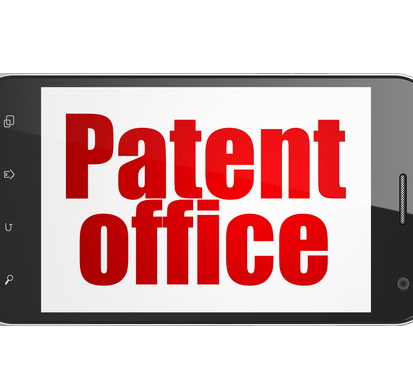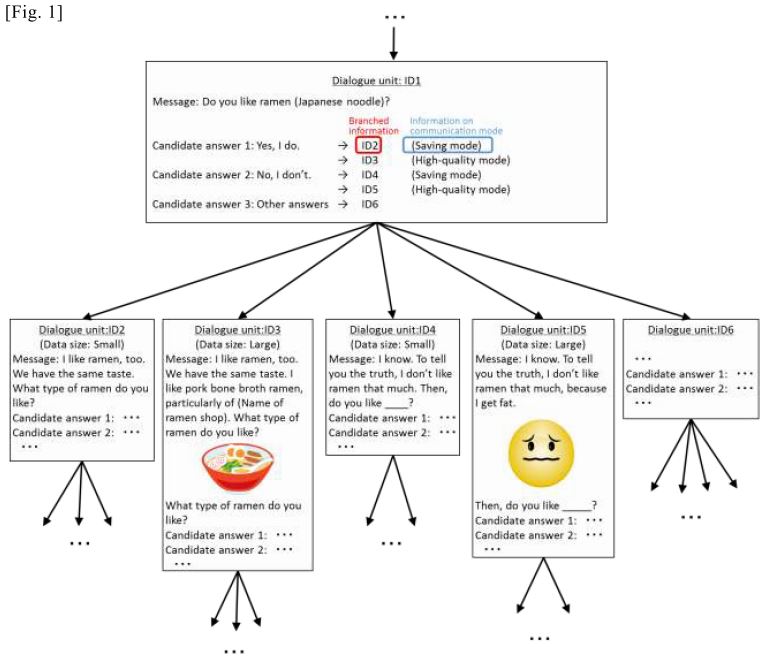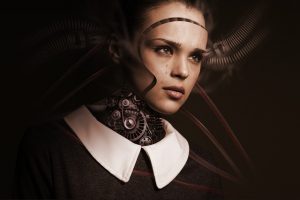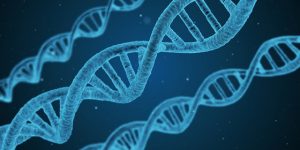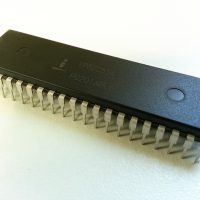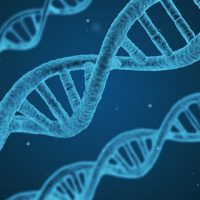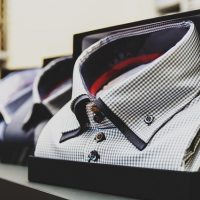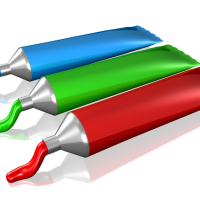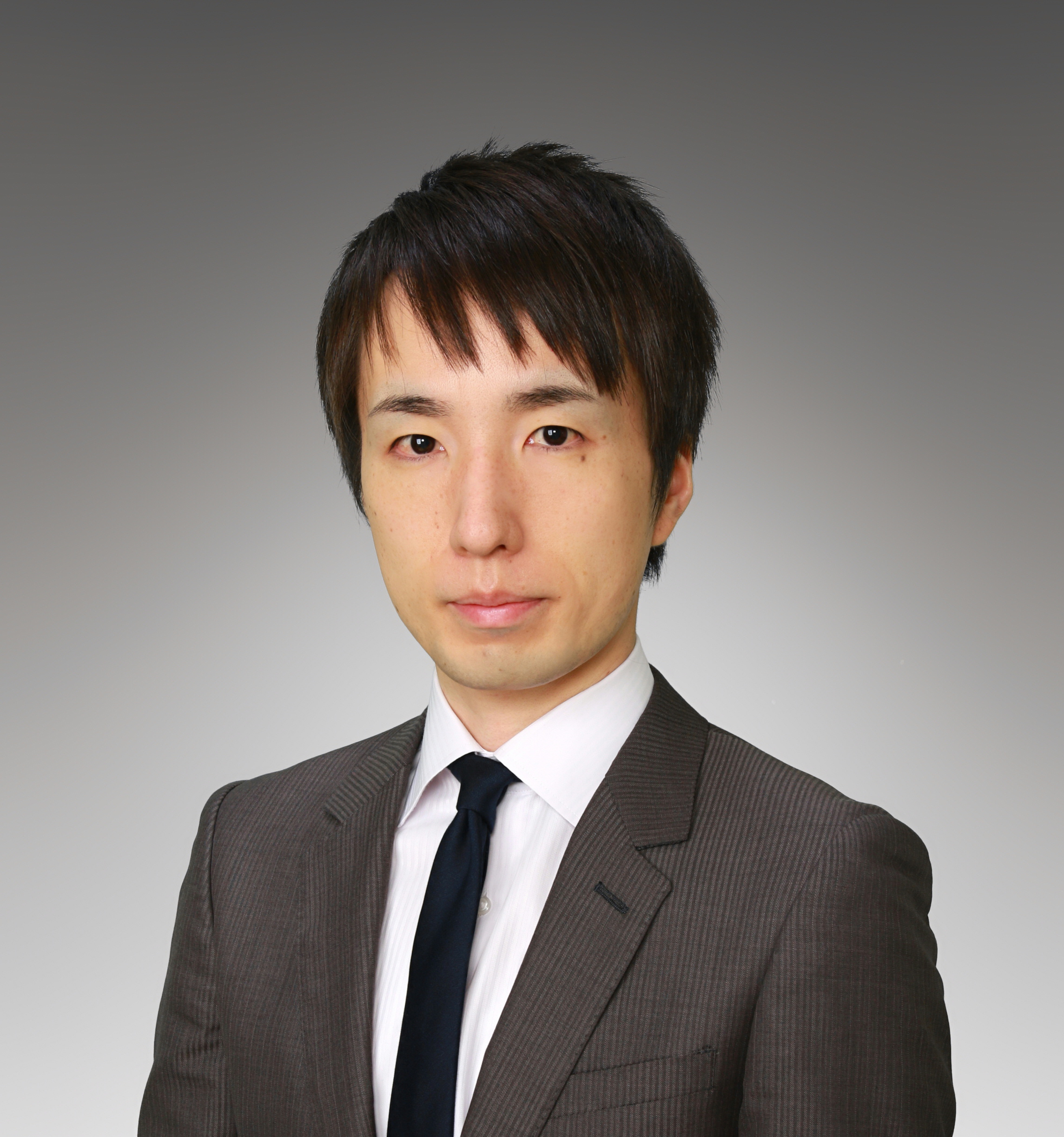Japan Patent Office publishes the Examination Handbook for Patent and Utility Model. Computer Software section of the Examination Handbook is shown below.
Chapter 1 Computer Software-Related Inventions
In this chapter, application of the examination guidelines to a patent application related to a computer software-related invention, more specifically, an invention that uses software to carry out the invention (hereinafter also referred to as a "software-related invention") is described.
In addition, a software-related invention related to a method for doing business is also described in this chapter.
See 1. for determination concerning the requirements for description of a software-related invention (enablement requirement and clarity requirement).
See 2. for determination concerning patentability of a software-related invention (eligibility for patent, novelty, and inventive step). When referring to 2. in determination of eligibility for patent, in particular, note that an examiner does not review according to the "idea based on the standpoint of software" described in 2.1.1.2 if a determination on whether or not the claimed software-related invention is the "creation of a technical idea utilizing the laws of nature" is made in accordance with the examination guidelines "Part III Chapter 1 Eligibility for Patent and Industrial Applicability," as stated in 2.1.1.1 (1) and (2).
See 3. for specific cases concerning the handling of examination of a software-related invention.
(i) Information processing
Operating or processing of information, depending on an intended use.
(ii) Procedure
A series of processes or operations connected in terms of timeframe for achieving a predetermined object.
(iii) Computer software
A program related to operation of a computer and other information supplied for processing by the computer and equivalent to the program (same as "program etc." in Article 2(4), and hereinafter also referred to as "software").
(iv) Program
A set of instructions given to a computer which are combined in order to produce a specific result (Article 2(4)).
(v) Program list
Presentation itself of a program by means of printing to a piece of paper or display on a screen.
(vi) Computer readable recording medium recording a program
A computer readable recording medium that can be used for installation and execution of a program as well as distribution of the program, and that can be read by a computer in which the program is recorded.
(vii) Those "equivalent to programs"
Those which are not direct instructions to computers and thus cannot be called programs, but have similar properties to programs in terms of prescribing computer processing. For example, "data structure" can be "equivalent to programs."
(viii) Data structure
A logical structure of data that is expressed by correlations between data elements.
(ix) Structured data
Data that has a logical structure that is expressed by correlations between data elements.
(x) Hardware resource
A physical device or physical element that is used in processing, operation, or implementation of a function.
For example, this refers to a computer as a physical device, and a CPU, memory, input device, output device, or physical device connected to a computer, which are components thereof.
(xi) Specific field
A field to which procedures or means, etc. of a computer technology are applied. This term includes all kinds of fields.
1. Description and claims
1.1 Requirements for description
1.1.1 Enablement requirement (Article 36(4)(i))
A determination on the enablement requirement in a software-related invention shall be made according to "Part II Chapter 1 Section 1 Enablement Requirements" of the examination guidelines. When making a determination on the enablement requirement in a software-related invention, an examiner should also note the matters stated in 1.1.1.1 below.
1.1.1.1 Examples of violation of enablement requirement
In the case of (1) or (2) below, the detailed description of the invention is not stated clearly and fully to the extent that a person skilled in the art in the field of the software-related invention can carry out the claimed invention. Therefore, it will breach enablement requirement.
(1) A case in which although technical procedures or functions are stated in the claims, the detailed description of the invention does not state how such technical procedures or functions are executed or implemented by hardware or software, and yet, in which the claimed invention cannot be carried out because a person skilled in the art cannot understand the invention even based on the common general knowledge at the time of filing.
Example 1:
In the claims, an information processing system which executes a mathematical solution, method for doing business, or game rule is described. On the one hand, in the detailed description of the invention, it is not stated how the method or the rule is implemented on a computer. Yet, a person skilled in the art cannot understand them even based on the common general knowledge at the time of filing. This applies to a case in which the person skilled in the art cannot carry out the claimed invention.
Example 2:
In the claims, a step of operating a computer based on a display screen of a computer (example: an input form using a GUI) is stated. On the one hand, in the detailed description of the invention, it is not stated how the step of operating the computer is implemented on the computer. Yet, a person skilled in the art cannot understand it even based on the common general knowledge at the time of filing. This applies to a case in which the person skilled in the art cannot carry out the claimed invention.
(2) A case in which although the claims are identified by matters including functions, the detailed description of the invention explains hardware or software that implements the functions of claimed invention, only by a functional block diagram or a schematic flow chart. With only the explanation by means of the functional block diagram or flow chart, it is not clear how the hardware or software is configured, and yet, the claimed invention cannot be carried out because a person skilled in the art cannot understand them even based on the common general knowledge at the time of filing.
Example 3:
In an exchange fluctuation forecasting system for forecasting fluctuations in future exchange, the claims state that "A exchange fluctuation forecasting system comprising ... means, ... means, calculation means configured to calculate forecasted exchange based on exchange data of the time series, weighting means configured to weight an exchange fluctuation analysis result from an economic expert to the forecasted exchange based on a mathematical evaluation approach derived from a game theory, and means configured to display the weighted forecasted exchange." On the one hand, in the detailed description of the invention, only a flow chart schematically indicating each functional means such as "Calculating forecasted exchange" → "Weighting an analysis result from an economic expert based on a game theory" → "Displaying forecasted exchange to which weighting is added" is stated. Thus, with only the statement in the detailed description of the invention, a mathematical expression that expresses theory content of a game theory, a mathematical expression that reflects a mathematical evaluation approach derived from the game theory, and software for implementing these mathematical expressions are not clear, and yet, cannot be understood by a person skilled in the art even based on the common general knowledge at the time of filing.
In addition, it has been well known that a mathematical evaluation approach derived from a game theory that is used to weight analysis results largely depends on how a component such as a prerequisite condition or individual's behavior pattern is evaluated. Therefore, if a person skilled in the art could understand a game theory used to forecast exchange fluctuations on the basis of the common general knowledge at the time of filing, software for implementing a mathematical expression that reflects a mathematical evaluation approach and software for implementing the mathematical expression are still unclear and yet, cannot be understood by a person skilled in the art even based on the common general knowledge at the time of filing.
Therefore, this applies to a case in which the person skilled in the art cannot carry out the claimed invention.
1.2 Requirements for claims
1.2.1 Clarity requirement (Article 36(6)(ii))
A determination on the clarity requirement in a software-related invention shall be made according to "Part II Chapter 2 Section 3 Clarity Requirement" of the examination guidelines. When making a determination on the clarity requirement in a software-related invention, an examiner shall also note the matters stated in 1.2.1.1 to 1.2.1.3 below.
1.2.1.1 Category of software-related invention
An applicant can state the following as an "invention of a method" or an "invention of a product" in the claims:
(1) Invention of a method
When a software-related invention can be expressed as a series of processes or operations, which are connected in terms of the time series, more specifically, as "steps," an applicant can state the software-related invention as an "invention of a method" (including an "invention of producing a product") in the claims, by identifying the "steps."
(2) Invention of a product
When a software-related invention can be expressed by a plurality of functions the invention serves, an applicant can state the software-related invention in the claims as an "invention of a product" which is identified by the functions.
The applicant can state a program, a structured data and a data structure as follows.
(i) A "program" that identifies a plurality of functions a computer serves can be stated as an "invention of a product" in the claims.
Example 1: A program for causing a computer to execute a step A, a step B, a step C, ...
Example 2: A program for causing a computer to function as means A, means B, means C, ...
Example 3: A program for causing a computer to implement a function A, a function B, a function C, ...
(ii) "Structured data" or a "data structure" in which information processing to be performed by a computer is prescribed by a structure of data can be stated as an "invention of a product" in the claims.
Example 4: Structured data including a data element A, a data element B, a data element C, ...
Example 5: A data structure including a data element A, a data element B, a data element C,...
(iii) A computer readable recording medium which records the "program" in (i) above or the "structured data" in (ii) above can be stated as an "invention of a product" in the claims.
Example 6: A computer readable recording medium which records a program for causing a computer to execute a process A, a process B, a process C, ...
Example 7: A computer readable recording medium which records a program for causing a computer to function as means A, means B, means C, ...
Example 8: A computer readable recording medium which records a program for causing a computer to implement a function A, a function B, a function C, ...
Example 9: A computer readable recording medium which records structured data including a data element A, a data element B, a data element C, ...
1.2.1.2 Points to note
(1) If it is clear in consideration of description, drawings and the common general knowledge at the time of filing that the claimed invention is a "program" even though the claimed subject matter is any word other than the "program" (for example, "module", "library", "neural network", "support vector machine" or "model") the claimed invention is handled as the "program." In this case, the claimed invention shall not be considered a violation of clarity requirement because the claimed subject matter is any word other than the "program."
In addition, if the claimed subject matter is either a "program signal (array)" or a "data signal (array)", the claimed invention will breach clarity requirement because it is impossible to identify whether it is an "invention of a method" or an "invention of a product."
(2) Even if the claimed subject matter is either a "program article" or a "program product," the claimed invention is handled as what it means, as long as it is clear in consideration of the description, drawings and the common general knowledge at the time of filing that it means any of (a) - (c) below. If this is not the case, the claimed invention will breach clarity requirement, because the scope of the invention is unclear.
(a) A "program" itself
(b) A "recording medium in which a program is recorded"
(c) A system into which a program is read, such as a "computer system into which a program is read"
(Example in which a "program article" is allowed)
Example:
A program article recording a computer program for causing a computer to execute a step a, a step b, a step c, ...
(Detailed description of the invention)
A detailed description of the invention states that a program article is a computer readable medium in which a computer program is recorded.
(Explanation)
Since the detailed description of the invention states that "a program article is a computer readable medium in which a computer program is recorded" and it can be clearly understood that a "program article" in the claims is a "computer readable medium," the invention is clear.
(3) If the claimed subject matter is a "scheme" or a "system," it is handled as a word indicating the "product" category (See 2.2(3)a in "Part II Chapter 2 Section 3 Clarity Requirement" of the examination guidelines).
1.2.1.3 Examples in which an invention is not clear
In the following cases, a software-related invention is unclear and will breach clarity requirement.
(1) The case in which the statement of the claims is unclear and consequently an invention is unclear (See 2.2(1) in "Part II Chapter 2 Section 3 Clarity Requirement" of the examination guidelines).
Example 1:
An order receiving method which performs a step of using a computer and receiving an order of an article from a customer; a step of checking for stock of the ordered article; and a step of responding to the customer if there is stock of the article that the article can be dispatched and responding to the customer if there is no stock of the article that the article cannot be dispatched.
(Explanation)
With the expression of "a step of using a computer ...," a subject of an action in each step is not identified. For this reason, it can be interpreted that the claimed invention includes a method which does not have similar properties or functions of the following (i) and (ii):
(i) A "method of operating a calculation tool of a computer" which is an "order receiving method which performs a step of using a computer (as the calculation tool) and (a man manipulating the computer and) receiving an order of an article from a customer; a step of (the man manipulating the computer and) checking for stock of the ordered article; and a step of (the man manipulating the computer and) responding to the customer if there is stock of the article that the article can be dispatched and (the man manipulating the computer and) responding to the customer if there is no stock of the article that the article cannot be dispatched".
(ii) An "information processing method with a software" which is an "order receiving method which performs a step of (in an order receiving system constructed by) using a computer and (means A the computer is provided with) receiving an order of an article from a customer; a step of (means B the computer is provided with) checking for stock of the ordered article; and a step of (means C the computer is provided with) responding to the customer if there is stock of the article that the article can be dispatched and (means C the computer is provided with) responding to the customer if there is no stock of the article that the article cannot be dispatched."
As described above, the claim includes an ambiguous Japanese expression of "using a computer," and one invention cannot be clearly understood from the statement of the claim even by considering other statements in the claim. Hence, the claimed invention is not clear.
Note that the claimed invention is clear if one invention can be clearly understood by considering other statements in the claim even if the words "using a computer" are included.
(Remarks)
In light of the objective of the claims, it is necessary that one invention is understood based on matters stated in one claim (See 2.1(1) in "Part II Chapter 2 Section 3 Clarity Requirement" of the examination guidelines).
Example 2:
A program comprising order receiving means for receiving an order of an article from a customer; examination means for checking for stock of the ordered article; customer response means to respond to the customer if there is stock of the article that the article can be dispatched and respond to the customer if there is no stock of the article that the article cannot be dispatched.
(Explanation)
While a "program" causes a computer to function as means, the "program" itself does not function as the "means." Therefore, it is not possible that the "program" itself is provided with functional means, and the claimed invention cannot be clearly understood.
Note that if the claimed invention is "a program for causing a computer to function as means for receiving an order of an article from a customer; examination means for checking for stock of the ordered article; customer response means to respond to the customer if there is stock of the article that the article can be dispatched and respond to the customer if there is no stock of the article that the article cannot be dispatched," it is clear that the claimed invention is an invention which causes the computer to function as means.
(2) The case where matters specifying the invention are not technically related to each other, and as a result, the invention is unclear (See 2.2(2)d in "Part II Chapter 2 Section 3 Clarity Requirement" of the examination guidelines).
Example 3:
An information transmission medium transmitting a specific computer program.
(Explanation)
The transmission of information is a function inherent to the transmission media. To define the matter specifying the invention to be "information transmission media transmitting a specific computer program" only means that a specific computer program is being transmitted at any time and to any place on the information transmission media. It only defines the inherent function of the transmission media, and does not specify any relation between the information transmission media and the computer program.
(3) The case where the category of a claimed invention is unclear, or cannot be identified as any category, and as a result, the invention is unclear (See 2.2(3) in "Part II Chapter 2 Section 3 Clarity Requirement" of the examination guidelines).
Example 4:
A program signal array for causing a computer to execute a step A, a step B, a step C, ...
(Explanation)
The claimed invention is not clear because it cannot be identified whether the invention is an "invention of a product" or an "invention of a method."
2. Patentability
In a software-related invention, since requirements for eligibility for patent and requirements of inventive step are important among patentability, these requirements will be described.
As a premise for determination concerning patentability, specifying an invention is carried out according to 2. of the examination guidelines "Part I Chapter 2 Section 1 Specifying Claimed Invention."
2.1 Eligibility for Patent (Main Paragraph of Article 29(1))
For the claimed invention to be an "invention" in terms of the Patent Act when the claimed invention is a software-related invention, it shall be same as with a case in which the claimed invention is not a software-related invention, in the point that said invention is required to be "advanced one of creation of a technical idea utilizing the laws of nature."
2.1.1 Procedure of determination
The procedure to determine whether or not the claimed software-related invention is a "creation of a technical idea utilizing the laws of nature" is as described below.
First of all, as stated in 2.1.1.1 (1) and (2), the examiner reviews whether or not the claimed software-related invention is a "creation of a technical idea utilizing the laws of nature", based on the examination guidelines "Part III Chapter 1 Eligibility for Patent and Industrial Applicability".
The examiner does not review according to the "idea based on the standpoint of software" if a determination on whether or not the claimed software-related invention is a "creation of a technical idea utilizing the laws of nature" is made in accordance with the examination guidelines "Part III Chapter 1 Eligibility for Patent and Industrial Applicability".
If not, the examiner shall make a determination according to the "idea based on the standpoint of software," as described in 2.1.1.2.
When making the determinations, the examiner reviews whether or not the claimed invention as a whole is a "creation of a technical idea utilizing the laws of nature," irrespective of part of matters specifying the invention in the claims.
Figure: Process of determining eligibility for patent for a software-related invention
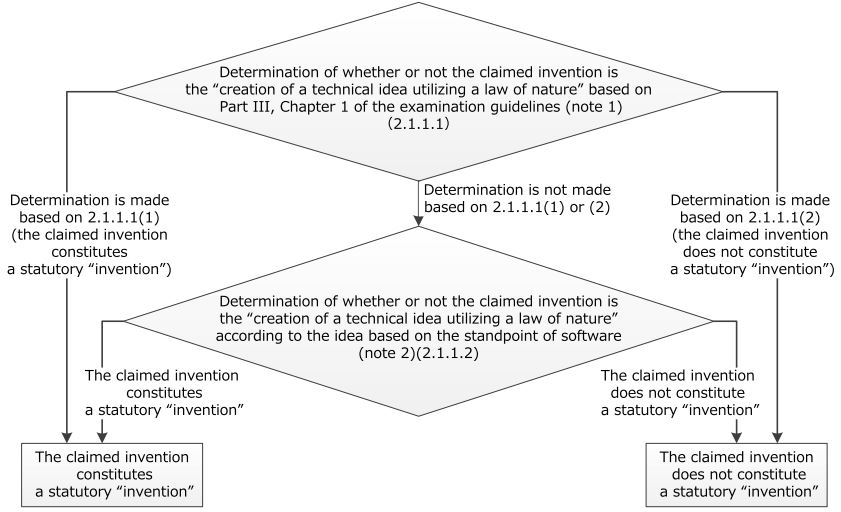
(note 1)
(1) Whether the claimed invention as a whole utilizes a law of nature, like those stated in (i) or (ii) below
(i) Those concretely performing control of an apparatus, or processing with respect to the control.
(ii) Those concretely performing information processing based on the technical properties of an object.
(2) Whether the claimed invention falls under any type that does not constitute a statutory “invention,” such as mere presentation of information, arbitrary arrangements, and mathematical formulae.
(note 2)
Whether or not information processing by the software is concretely realized by using hardware resources in the claimed invention.
2.1.1.1 Case in which a determination is made according to the examination guidelines "Part III Chapter 1 Eligibility for Patent and Industrial Applicability"
(1) Case of "creation of a technical idea utilizing the laws of nature"
A software-related invention utilizing the laws of nature as a whole and being considered as a "creation of a technical idea utilizing the laws of nature" (e.g., (i) or (ii) shown below) constitutes a statutory "invention" without being examined from a viewpoint of software.
(i) Those concretely performing control of an apparatus (e.g., rice cooker, washing machine, engine, hard disk drive, chemical reaction apparatus, nucleic acid amplifier), or processing with respect to the control
(ii) Those concretely performing information processing based on the technical properties such as physical, chemical, biological or electric properties of an object (e.g., rotation rate of engine, rolling temperature, relation between gene sequence and expression of a trait in a living body, physical or chemical relation of bound substances)
For example, those described below normally fall under the category of (i) above and are considered as the "creation of a technical idea utilizing the laws of nature."
(i-1) Those performing control of a target apparatus. based on a structure, system component, composition, action, function, nature, property, operation, etc. of the control target apparatus. or any other apparatus. related to the control target apparatus.
(i-2) Those performing control in a way that realizes operations according to the purpose of an apparatus.
(i-3) Those performing integrated control of a whole system comprising multiple related apparatuses.
In addition, those described below normally fall under the category of (ii) above and are considered as the "creation of a technical idea utilizing the laws of nature."
(ii-1) Those obtaining intended numerical values, images, etc. by calculation or processing of numerical values, images, etc. showing the technical properties of an object, which is performed according to said technical properties
(ii-2) Those performing information processing by utilizing a technical correlation between a state of an object and a phenomenon corresponding thereto
Software for causing a computer to execute a procedure of a method, which is a "creation of a technical idea utilizing the laws of nature" and thus constitutes a statutory "invention," or a computer or system for executing such a procedure, is normally a "creation of a technical idea utilizing the laws of nature" as a whole, and thus, it constitutes a statutory "invention."
(Example of a case falling under (i-1) above)
Example 1:
A server comprising:
a means for receiving users’ schedule information stored on users’ terminals from multiple users’ terminals;
a means for making estimations for the time of the users' return home based on said schedule information;
a means for setting the time to start cooking rice so that cooking is done right before the earliest estimated time of the users' return home, which is determined based on said multiple estimated time of the user's return home; and
a means for giving an instruction to a rice cooker to start cooking rice and causing said rice cooker to start cooking rice at said time set.
(Explanation)
As the claimed invention performs control based on a function, etc. of the control target apparatus (rice cooker) (a rice cooking function to complete rice cooking after a specific amount of time), it falls under the category of those concretely performing control of an apparatus or processing with respect to the control. Therefore, the claimed invention constitutes a statutory "invention."
(Example of a case falling under (i-2) above)
Example 2:
An electricity control system related to (a) sale of electricity through the transmission of electricity generated by a power generation apparatus to a commercial power system, (b) purchasing of electricity through the transmission of the system power of said commercial power system to a battery and electric equipment, (c) storage of electricity through the transmission of power generated by said power generation apparatus to said battery, and (d) discharge of electricity through the transmission of power stored in said battery to said electric equipment, comprising:
a server with an electricity value calculation part that estimates an electricity value for each time slot by adding (a) a value calculated by multiplying the unit price for sold electricity by the amount of electricity generated by said power generation apparatus, which is calculated based on the estimated amount of electricity consumed by the load of said electric equipment and the estimated amount of electricity generated by said power generation apparatus and is vendible when using power stored in said battery as the electricity consumed by the load of said electric equipment, to (b) a value calculated by multiplying the amount of the system power not necessary to be purchased by the unit price for sold electricity; and
an electricity control apparatus, which is connected with said server through a network, comprising an electricity control part that performs said sale, storage and discharge of electricity and refrains from performing said purchasing during a time slot in which the electricity value calculated by said electricity value calculation part is higher than the prescribed value.
(Explanation)
The claimed invention performs control in a way that realizes operations (performing (i) sale of electricity through the transmission of electricity generated by a power generation apparatus to a commercial power system and (ii) storage of electricity through the transmission of power generated by the power generation apparatus to the battery, and (iii) discharge of electricity through the transmission of power stored in the battery to the electric equipment; and refraining from purchasing of electricity through the transmission of the system power of the commercial power system to a battery and electric equipment) according to the purpose of apparatuses. (the power generation apparatus and battery). Therefore, the claimed invention falls under the category of those concretely performing control of an apparatus or processing with respect to the control. Therefore, the claimed invention constitutes a statutory "invention."
(Example of a case not falling under (i-2) above)
Example 3:
An electricity control system that controls sale of electricity generated by a power generation apparatus to an electric power company, purchasing of electricity from said electric power company, and discharge of electricity stored in the battery to cover electricity consumed by electric equipment, in a way that increases economic benefit for a consumer based on the purchase and sale prices of electricity.
(Explanation)
(Reasons why the claimed invention does not fall under (i-2) above)
In the claimed invention, it is only specified that the sale, purchasing and discharge of electricity are controlled "in a way that increases economic benefit for a consumer based on the purchase and sale prices of electricity." Even if the description, drawings and common general knowledge at the time of filing are taken into consideration in interpreting the meanings of words in the claims, the application does not specify anything about the operation of the apparatuses. (the power generation apparatus and battery), although it successfully specifies the purpose of the apparatuses.
Therefore, it cannot be said that the claimed invention falls under the category of those performing control in a way that realizes operations according to the purpose of an apparatus.
(Reasons why the claimed invention is not a "creation of a technical idea utilizing the laws of nature")
It cannot be said that the claimed invention as a whole concretely performs control of an apparatus or processing with respect to the control, nor can it be said that it concretely performs information processing based on the technical properties such as physical, chemical, biological or electric properties of an object. In the claimed invention, it cannot be said either that information processing by the software is concretely realized by using hardware resources (see "2.1.1.2 Idea based on the standpoint of software").
Therefore, the claimed invention as a whole is not the "creation of a technical idea utilizing the laws of nature" and thus does not constitute a statutory "invention."
(Example of a case falling under (i-3) above)
Example 4:
A delivery method for a delivery system comprising a transport vehicle with a cargo supply mechanism and a drone capable of autonomous flight, wherein:
said transport vehicle has in its ceiling part a cargo supply mechanism that automatically supplies cargo to said drone and space for takeoff and landing located immediately above said cargo supply mechanism;
said cargo supply mechanism and said drone are capable of communicating with a control server; and
the following steps are carried out once or more based on an instruction sent from said control server:
(a) a step in which said cargo supply mechanism supplies cargo to said drone that lands on the takeoff and landing space;
(b) a step in which said drone flies to the destination and releases said cargo; and
(c) a step in which said drone flies to said transport vehicle and lands on said takeoff and landing space.
(Explanation)
When the claimed invention is studied as a whole, the delivery of cargo is accomplished by the coordinated operation of the apparatuses, namely the cargo supply mechanism and drone, based on an instruction from the control server. The claimed invention performs integrated control of a whole system (the delivery system) comprising multiple related apparatuses (the cargo supply mechanism and drone). Therefore, the claimed invention constitutes a statutory "invention."
(Example of a case falling under (ii-2) above)
Example 5:
A secondary accident prevention program for causing a computer to implement (a) a function to confirm the fact that a shock has occurred to a vehicle and said vehicle has stopped based on the acceleration rate and velocity of said vehicle transmitted from the terminal on said vehicle, (b) a function to analyze the velocity of other vehicles located near said vehicle after said confirmation, and determine whether an accident has occurred by studying whether the velocity of other vehicles located near said vehicle has decreased, and (c) a function to transfer information on the occurrence of the accident to other vehicles located near said vehicle.
(Explanation)
The claimed invention performs information processing by utilizing technical correlations (a correlation between the occurrence of an accident and the velocity and acceleration rate of a vehicle and the velocity of vehicles located nearby) with respect to the secondary accident prevention program. Therefore, it can be said that the claimed invention concretely performs information processing based on the technical properties such as physical, chemical, biological or electric properties of an object. Thus, the claimed invention constitutes a statutory "invention."
(Example of a case not falling under (ii-2) above)
Example 6:
A secondary accident prevention program for causing a computer to implement a function to determine whether an accident has occurred based on information concerning multiple vehicles.
(Explanation)
(Reasons why the claimed invention does not fall under (ii-2) above)
In the claimed invention, it is only specified that the secondary accident prevention program "determines whether an accident has occurred based on information concerning multiple vehicles." Even if the description, drawings and common general knowledge at the time of filing are taken into consideration in interpreting the meanings of words in the claims, it cannot be said that the claimed invention performs information processing utilizing a technical correlation (a correlation between the occurrence of an accident and information concerning multiple vehicles).
(Reasons why the claimed invention is not the "creation of a technical idea utilizing the laws of nature")
It cannot be said that the claimed invention as a whole concretely performs information processing based on the technical properties such as physical, chemical, biological or electric properties of an object, nor can it be said that it concretely performs control of an apparatus or processing with respect to the control. In the claimed invention, it cannot be said either that information processing by the software is concretely realized by using hardware resources (see "2.1.1.2 Idea based on the standpoint of software").
Therefore, the claimed invention as a whole is not the "creation of a technical idea utilizing the laws of nature" and thus does not constitute a statutory "invention."
(2) Example of not "creation of a technical idea utilizing the laws of nature"
When the claimed software-related invention falls under any type of 2.1 in "Part III Chapter 1 Eligibility for Patent and Industrial Applicability" of the examination guidelines, the claimed invention is not a "creation of a technical idea utilizing the laws of nature."
Listed below are specifically related types and their examples, of the type of 2.1 in "Part III Chapter 1 Eligibility for Patent and Industrial Applicability" of the examination guidelines.
a Those in which the laws of nature are not utilized
When a claimed invention is considered as any of (i) to (v) shown below, the claimed invention is not deemed to utilize the laws of nature, and thus, is not considered as a statutory "invention" (see Example 1 and Example 2).
(i) Any laws other than the laws of nature (e.g., economic laws)
(ii) Arbitrary arrangements (e.g., a rule for playing a game as such)
(iii) Mathematical formula
(iv) Mental activities of humans
(v) Those utilizing only (i) to (iv) (e.g., methods for doing business as such)
Even if a part of matters specifying the invention stated in a claim utilizes the laws of nature, when it is determined that the claimed invention as a whole does not utilize the laws of nature, the claimed invention is deemed as not utilizing the laws of nature (see Examples 3 to 6).
On the contrary, even if a part of matters specifying the invention stated in a claim does not utilize the laws of nature, when it is determined that the claimed invention as a whole utilizes the laws of nature, the claimed invention is deemed as utilizing the laws of nature.
The characteristic of the technology is to be considered in determining whether a claimed invention as a whole utilizes the laws of nature.
(Examples of those contrary to the laws of nature)
Example 1: Computer programming languages (applicable to (ii) in the above)
Example 2: A method of collecting money for an electricity bill or a gas bill etc., by rounding off the total amount to be collected to the nearest 10 yen unit (applicable to (v) in the above)
Example 3: A method of plying a container vessel to transport a large amount of beverages from a region where crude oil is expensive and beverages are inexpensive to another region where crude oil is inexpensive and beverages are expensive, and after unloading the beverages, transporting a large amount of crude oil instead of beverages to the homeward voyage
Example 4: A method of billboard advertising using utility poles, characterized by forming in advance groups A, B, C, D, ... with a prescribed number of poles in each group, placing a holding frame to post thereon a billboard for each pole, and posting the billboards in each group on holding frames placed to poles in each group in circulation in a certain time interval
Example 5: A method of playing Shogi (Japanese chess) between players remote from each other, the method comprising: a step of transmitting a move of one player to the other player through a chat system in the one player's turn; and a step of transmitting a move of the other player to the one player through the chat system in the other player's turn, the steps being repeated alternately.
(Explanation)
It does not fall under "the invention" since the method described above applies only artificial arrangements as a whole where two players remote from each other play alternately although the chat system is used as the technical means.
Example 6: A method of playing a game in which cards with nn (n is an odd number that is three or more) numbers thereon are distributed to each player, each player marks a number drawn by a computer if his/her card includes the drawn number, and a player who first marks all numbers in a vertical, horizontal or diagonal row can be a winner
(Explanation)
It does not fall under "the invention" since the method described above applies only the specific rules of the game as a whole where each player marks a drawn number if the player has such number in the card and the player who first marks all numbers in a vertical, horizontal or diagonal row can be a winner, although the drawing is carried out by the computer as the technical means.
b Mere presentation of information (where the feature resides solely in the content of the information, and the main object is to present information)
Example 1: A written manual for instructing an operation of a machine or directing a use of a chemical substance
Example 2: An audio CD the feature of which resides solely in music recorded thereon
Example 3: Image data taken with a digital camera
Example 4: A program of an athletic meeting made by a word processor
Example 5: A computer program list (mere representation of computer programs by means of printing them on paper, displaying them on a screen, etc.)
If a technical feature resides in presentation of information (presentation per se, means for presentation, a method for presentation, etc.), a claimed invention is not considered as mere presentation of information.
Example 6: A test pattern for use in checking the performance of a television set
(Explanation)
The technical feature resides in the pattern per se.
Example 7: A plastic card on which information is recorded with characters, letters and figures embossed on it
(Explanation)
The information is printed on the plastic card by emboss processing and the printed information on the card is copied by affixing the card on paper. The technical feature resides in the means for presentation.
2.1.1.2 Idea based on the standpoint of software
If it cannot be determined according to the examination guidelines "Part III Chapter 1 Eligibility for Patent and Industrial Applicability" whether or not the claimed software-related invention falls under the "creation of a technical idea utilizing the laws of nature", the examiner shall make a determination based on the basic ideas as described below:
(1) Basic ideas
Listed below are basic ideas whereby a software-related invention is a "creation of a technical idea utilizing the laws of nature":
(i) When for software of a software-related invention, "information processing by the software is concretely realized by using hardware resources," said software is a "creation of a technical idea utilizing the laws of nature."
"Information processing by the software is concretely realized by using hardware resources" means that "a specific information processor or an operation method thereof is constructed through cooperation of the software and the hardware resources."
(ii) Of a software-related invention, for an information processor which operates in cooperation with software and an operation method thereof, as well as a computer readable recording medium in which the software is recorded, if said software satisfies (i) above, it is a "creation of a technical idea utilizing the laws of nature."
(2) Procedure for determination based on the basic ideas
Based on the basic ideas listed in (1), the examiner shall determine on requirements of "creation of a technical idea utilizing the laws of nature" depending on whether or not "information processing by the software is concretely realized by using hardware resources" in a software-related invention; that is to say, whether or not a specific information processor or an operation method thereof depending on intended use is constructed through cooperation of software and hardware resources.
As this specific determination approach, the examiner may determine whether or not the claimed invention implements specific calculation or processing of information depending on the intended use by concrete means or procedures on which software and hardware resources cooperate.
Example 1:
A computer for determining a minimum value of y in the range of a≦x≦b in the mathematical expression y=F(x).
(Explanation)
The claim states that the claimed invention determines "a minimum value of y in the range of a≦x≦b in the mathematical expression y=F(x)." However, only with this statement, it cannot be said that concrete means or procedures for implementing specific calculation or processing depending on the intended use of the claimed invention, namely determining a minimum value of y, is stated. Even if the description, drawings and common general knowledge at the time of filing are taken into consideration in interpreting the meanings of words in the claims and the entire statement of the claim are considered, the claimed invention does not specify means for implementing specific calculation or processing for determining a minimum value of y. Thus, the claimed software-related invention does not construct the specific computer (information processor) depending on the intended use by the software cooperating with the hardware resource.
Therefore, since information processing by the software is not concretely realized by using the hardware resource, the claimed software-related invention is not a "creation of a technical idea utilizing the laws of nature" and does not constitute a statutory "invention."
Example 2:
A computer receiving an input of the prediction date and subject product for which sales are to be predicted and predicting sales for said subject product on said prediction date based on past sales data for said subject product on the same day of the week as said prediction day during a specific period in the past.
(Explanation)
The claim states sales for the subject product on the prediction date that has been input are predicted, based on data on past sales for the subject product on the same day of the week as said prediction day during a specific period in the past. However, only with the statement "based on past sales data for said subject product on the same day of the week as said prediction day during a specific period in the past," it cannot be said that concrete means or procedures for implementing specific calculation or processing depending on the intended use, namely prediction of sales for the subject product on the prediction date, is stated. Even if the description, drawings and common general knowledge at the time of filing are taken into consideration in interpreting the meanings of words in the claims and the entire statement of the claim are considered, the claimed invention does not specify concrete means or procedures for implementing specific calculation or processing for predicting sales of the subject product on the prediction date. Consequently, the claimed software-related invention does not construct the specific computer (information processor) depending on the intended use by the software cooperating with the hardware resource.
Therefore, since information processing by the software is not concretely realized by using the hardware resource, the claimed software-related invention is not the "creation of a technical idea utilizing the laws of nature" and does not constitute a statutory "invention."
Example 3:
A computer comprising input means configured to input document data, processing means configured to process the inputted document data, and output means configured to output the processed document data, the computer for creating a summary of the document inputted by the processing means.
(Explanation)
The claim states that a summary is created by the processing means. However, only with the statement "creating a summary of the document inputted by the processing means," it cannot be stated that concrete means or procedures for implementing specific calculation or processing depending on the intended use of creation of a summary is stated. Even if the description, drawings and common general knowledge at the time of filing are taken into consideration in interpreting the meanings of words in the claims and the entire statement of the claim are considered, the claimed invention does not state concrete means or procedures for implementing specific calculation or processing of information for creation of a summary is stated even considering the entire statement of the claim. Consequently, the claimed software-related invention does not construct the specific computer (information processor) depending on the intended use by the software cooperating with the hardware resource.
Therefore, since information processing by the software is not concretely realized by using the hardware resource, the claimed software-related invention is not a "creation of a technical idea utilizing the laws of nature" and does not constitute a statutory "invention."
Example 4:
A computer for creating a summary for a specific subject document contained in a group of documents wherein:
through analysis of said subject document, one or more sentences comprising said document are extracted and one or more words contained in each sentence are extracted;
a TF-IDF value for each of said extracted words is calculated based on the frequency of the word's appearance in said subject document (TF) and the reciprocal of the frequency of the word's appearance in all documents contained in said group of documents (IDF); and
the total of said TF-IDF values for multiple words contained in each sentence is calculated as the sentence's importance index for each sentence, a certain number of sentences are selected from said subject document in the descending order of the sentence's importance index, and a summary is created by arranging the selected sentences.
(Explanation)
The claim concretely states specific calculation or processing of information for creating a summary of the input document data. Moreover, although the only hardware resource stated in the claims is the "computer," it is obvious to a person ordinarily skilled in the art that the specific calculation or processing of information depending on the intended use is implemented by concrete means or procedures on which the software and hardware resources that a "computer" usually comprises, such as a CPU, memory, storage means, input and output means, etc. cooperate, if the common general knowledge at the time of filing of the application is taken into account. Therefore, it is determined that specific calculation or processing of information depending on the intended use, namely creation of a summary, is implemented by a concrete means or procedure on which the software and hardware resources cooperate. Thus, it can be said that the claimed computer constructs an information processor apparatus depending on the intended use on which the software and hardware resources cooperate.
Therefore, since information processing by the software is concretely realized by using the hardware resources, the claimed software-related invention is the "creation of a technical idea utilizing the laws of nature" and constitutes a statutory "invention."
(Points to note)
(i) When determining whether or not "information processing by the software is concretely realized by using hardware resources," the examiner shall make a determination based on whether or not "information processing by the software is concretely realized by using hardware resources" by looking at the claimed invention as a whole, irrespective of part of matters specifying the invention in the claims. Note, in particular, that "concrete means or procedures" may be implemented as a whole not only by individual means or procedures stated in the claims but also multiple means or procedures (see 2.1.4 in "Part III Chapter 1 Eligibility for Patent and Industrial Applicability" of the examination guidelines).
(ii) The claimed software-related invention is to be determined. Thus, even if it is stated in the detailed description of the invention and drawings that "information processing by the software is concretely realized by using hardware resources," the examiner should note that the claimed invention is not a "creation of a technical idea utilizing the laws of nature" unless "information processing by the software is concretely realized by using hardware resources" in the claimed invention.
(iii) Even if the claims state such hardware resources as a "computer (information processor)", a "CPU (calculation means)", or a "memory (storage means)", the examiner should note that the claimed invention is not a "creation of a technical idea utilizing the laws of nature" unless the claims state concrete means or procedures for implementing specific calculation or processing of information depending on intended use on which software and hardware resources cooperate.
This is because with a simple statement of hardware resources, it cannot be stated that a specific information processor or an operation method thereof depending on an intended use has been constructed through cooperation of software and the hardware resources, and that information processing by the software has been concretely realized by using the hardware resources.
Even if the "computer (information processor)" is the only hardware resource stated in the claims, in cases where the claims state specific calculation or processing of information depending on the intended use, it may be obvious that specific calculation or processing of information depending on the intended use is implemented by concrete means or procedures in which the software cooperates with the hardware resources that a "computer (information processor)" usually comprises, such as a "CPU (calculation means)" and "memory (storage means)" in the claimed invention, if the common general knowledge at the time of filing of the application is taken into account.
(iv) When determining whether or not the claimed software-related invention is a "creation of a technical idea utilizing the laws of nature," the examiner should note that a determination be made by interpreting significance of matters (words) to identify an invention stated in the claims, regardless of a category (a "method" or a "product").
In other words, the examiner should be careful not to determine whether or not the claimed software-related invention is a "creation of a technical idea utilizing the laws of nature" based on the sole fact that the category of the claimed invention has been formally changed.
Example:
A computer program causing a computer to implement a method for playing Shogi between players remote from each other, the method comprising: a step of transmitting a move of one player to the other player through a chat system in the one player's turn; and a step of transmitting a move of the other player to the one player through the chat system in the other player's turn, the steps being repeated alternately.
(Explanation)
Since a "method of playing Shogi (Japanese chess) between players remote from each other, the method comprising: a step of transmitting a move of one player to the other player through a chat system in the one player's turn; and a step of transmitting a move of the other player to the one player through the chat system in the other player's turn, the steps being repeated alternately" as a whole is only a method using arbitrary arrangements, the claimed invention does not constitute a statutory "invention" (see Example 5 of 2.1.1.1(2)a). Moreover, even if the category is formally changed from "method" to "product (program)," it cannot be said that information processing by the software is concretely realized by using hardware resources and thus it still cannot be said that the claimed invention is a "creation of a technical idea utilizing the laws of nature," nor can it be said that it constitutes a statutory "invention."
In addition to the case of category change from "method" to "product (program)," in the case of formal category change from "method" to "product (system)," too, the claimed invention is still not found to be a "creation of a technical idea utilizing the laws of nature" or a statutory "invention" as long as the claimed invention is merely a system that is an arbitrary arrangement.
(v) The examiner should note that a determination whether or not a software-related invention related to a method for doing business falls under "creation of a technical idea utilizing the laws of nature" is made not from the standpoint of whether or not a method for doing business has a characteristic, but based on whether or not information processing by the software that said business-related invention utilizes is concretely realized by using hardware resources.
(vi) The examiner should note that a "program language" and a "program list" are not an "invention" because they are not "creation of a technical idea utilizing the laws of nature" (See 2.1.4 and 2.1.5(2) in "Part III Chapter 1 Eligibility for Patent and Industrial Applicability" of the examination guidelines).
(vii) In some cases, it may be determined that the claimed software-related invention which is not a "creation of a technical idea utilizing the laws of nature" may become a "creation of a technical idea utilizing the laws of nature" by being amended.
In such a case, it is desirable that the examiner suggests amendment when notifying the reason for refusal.
When conducting prior art search, the examiner takes into consideration the matters reasonably expected to be added to claims by an amendment in order for the claimed invention to become a "creation of a technical idea utilizing the laws of nature" as the subject of search in view of the efficiency of the procedures until a decision to grant a patent is rendered (see 2.2(2) of "Part I, Chapter 2, Section 2 Prior Art Search and Determination of Novelty, Inventive Step, etc." of the examination guidelines).
In principle, the examiner should give notice of all of the reasons for refusal which have been found in the first notice of reasons for refusal. However, where notification of only a reason for refusal is likely to lead to amendments by which not only the notified reason for refusal but also another reason for refusal will be overcome at the same time, multiple reasons for refusal should not be always notified redundantly (see 3.1(2) of "Notice of Reasons for Refusal" of the examination guidelines). For instance, where notification of only some reasons for refusal in terms of lack of novelty, lack of inventive step and non-compliance with description requirements is likely to lead to amendments by which not only the reasons for refusal but also a reason for refusal in term of eligibility for patent will be overcome, the reason for refusal in terms of eligibility for patent should not be always notified.
2.1.2 Handling of "structured data" and "data structure"
(1) The examiner shall determine whether or not the "structured data" and "data structure" are equivalent to programs, or, in other words, whether or not they have similar properties to programs in that the structure of data prescribes computer processing. If the "structured data" and "data structure" are equivalent to programs, they are determined to be (computer) software. "Structured data" and "data structures" that are not equivalent to a computer program are not determined to be software (see Case 2-8, etc. for cases of those equivalent to a computer program).
(2) The examiner shall determine on whether or not "structured data" (including a "computer readable recording medium in which structured data is recorded") and a "data structure," which are software, fall under "creation of the technical idea utilizing the laws of nature," based on "2.1.1 Procedure of determination."
(3) The examiner shall determine whether or not "structured data" and a "data structure," which are software, fulfill requirements for the "creation of a technical idea utilizing the laws of nature" based on whether or not information processing prescribed by the structure that data has is concretely realized by using hardware resources, according to "2.1.1.2 Idea based on the standpoint of software."
As a method of making this specific determination, the examiner may determine whether or not the claimed invention implements specific calculation or processing of information depending on the intended use by concrete means or procedures on which software (data structure equivalent to the program) and hardware resources cooperate.
Example 1:
A virtual space character created by a computer through the implementation of special information processing.
(Explanation)
The claimed invention is created by a computer through the implementation of special information processing and is a virtual space character expressed as a combination of figures and patterns. Although it is stated as a "character" in the claimed subject matter, it is obvious that the claimed invention is data. However, even though this data is created through the implementation of special information processing, its "structure" as "structured data" is not specified and thus the structure that this data has does not prescribe computer processing.
Therefore, this virtual space character does not have similar properties to programs and thus is not equivalent to programs.
The virtual space character of the claimed invention is a mere presentation of information in which a technical feature does not reside. The claimed invention as a whole is not the "creation of a technical idea utilizing the laws of nature" and does not constitute a statutory "invention."
Example 2:
A data structure of a telephone book in which data elements comprising name, address, and telephone number are stored and managed as a set of records, which is used by a computer to search for a telephone number using a name as a key.
(Explanation)
Looking at the data structure of the claimed invention, the claims only specify that multiple data elements comprising name, address, and telephone number are stored and managed as a set of records, and they do not specify any other relationships among the data elements. As such, since it cannot be said that the relationship among the data elements leads to the same result that a computer searches for a telephone number using a name as a key, said telephone number search cannot be said to be computer processing prescribed by the data structure (it is not the data structure but the program installed on the computer that prescribes the computer processing, namely said telephone number search).
Since the claimed data structure does not prescribe computer processing, it does not have similar properties to programs and thus is not equivalent to programs.
The data structure of the claimed invention merely specifies the content and order of data elements contained in the data structure and is merely an arbitrary arrangement. Therefore, it is not a "creation of a technical idea utilizing the laws of nature" and does not constitute a statutory "invention."
2.2 Novelty, Inventive Step (Article 29 (1), (2))
2.2.1 Target of determination on novelty, inventive step
An invention that is a target of determination on novelty and inventive step is the claimed invention.
In addition, when finding a software-related invention, it is appropriate to understand an invention as a whole, while it is not appropriate to specify it by dividing it into artificial arrangement or the like and a systemization method, since the matters or terms described in the claims should be always considered and should not be ignored, as with other kinds of inventions (see 2. of "Part III Chapter 2 Section 3 Procedure of Determining Novelty and Inventive Step" of the examination guidelines).
2.2.2 Determination of novelty
A determination on novelty in a software-related invention is made according to the examination guidelines "Part III Chapter 2 Novelty and Inventive Step". The examiner should also note the matters stated in 2.2.4 below when making a determination on novelty in a software-related invention.
2.2.3 Determination of inventive step
2.2.3.1 Basic ideas
(1) A determination on novelty in a software-related invention is made according to the examination guidelines "Part III Chapter 2 Novelty and Inventive Step". The examiner should also note the matters stated in the following (2) to (6) as well as 2.2.3.2 , 2.2.3.3 and 2.2.4.
(2) A person skilled in the art in a software-related invention pertaining to a specific field, a person who falls under all of the following (i) to (iv) is assumed.
(i) A person having the common general knowledge or general knowledge (including remarkable facts, or the like) in that specific field at the time of filing and the common general knowledge in the field of computer technology (for example, systemization technology) at the time of filing.
(ii) A person who is able to use ordinary technical means for research and development (including document analysis, experiment, technical analysis, manufacture, etc.).
(iii) A person who is able to exercise ordinary creativity in selecting materials and modifying designs.
(iv) A person who is able to comprehend all the matter in the state of the art in the technical field(the specific field and the field of computer technology) of the claimed invention at the time of filing, and comprehend all technical matters in the field relevant to problems to be solved by the invention.
In some cases, it may be appropriate to think that a person skilled in the art is not an individual but a "team composed of experts" from a plurality of technical fields (See 2. in "Part III Chapter 2 Section Inventive step").
(3) It is a common attempt in the field of software-related invention to apply a procedure, means, or the like of a computer technology which are utilized in a specific field to another specific field, in order to achieve a predetermined object. Therefore, combination of technologies utilized in various specific fields or application thereof to other specific fields falls within normal creation activity of a person skilled in the art.
For example, if the claimed invention simply applies a procedure, means, or the like of a computer technology applied in a specific field to another specific field, without demonstrating any other technical feature, and if the advantageous effect obtained through this application does not exceed what is predictable based on the state of the art at the time of filing, there is a factor in support of the non-existence of the inventive step.
When conducting prior art search for a software-related invention, since it is a common attempt in the field of software-related invention to apply a procedure, means, or the like of a computer technology which are utilized in a specific field to another specific field for a certain purpose, as stated above, the examiner should note that it is common to expand the scope of prior art search to other specific fields or computer technology fields, beyond the specific field.
(4) Issues involved in software or computerization are often general issues common to the computer technology field. For example, they include "sophistication of a determination through AI or fuzzy logic," "facilitation of input through GUI" or the like.
The examiner shall make a determination on inventive step based on these general issues that have been known in the field of computer technology.
Example:
As a sound reproducing device, the claims state a sound reproducing device comprising volume control means consisting of means A, means B, and a volume bar displayed by GUI on a display screen. The prior art states a sound reproducing device comprising means A, means B, and volume control means consisting of a jog dial. Here, it is a common general issue to the computer technology field to enable any one to use GUI to simply perform an input operation while looking at the display screen. Then, replacement of the volume control means of the reproducing device of the prior art with a well-known volume bar displayed by the GUI in consideration of said issue is exhibition of normal creation capabilities of a person skilled in the art. Therefore, the inventive step of the claimed invention is denied.
(5) General effects that can be obtained by systemization of a computer, such as "capable of processing fast," "capable of processing volume of data," "capable of reducing errors," "obtaining uniform results," or the like, are often effects naturally involved in systemization. Normally, it cannot be stated that these general effects are unforeseeable from the state of the art at the time of filing. The examiner shall determine on the inventive step based on these general effects in the field of computer technologies.
(6) The factor which obstructs application of the secondary prior art to the primary prior art (obstructive factor) and the advantageous effects over the prior art which exceed what is predictable based on the state of the art at the time of filing support the existence of an inventive step similarly in a software-related invention. Therefore, the examiner shall consider such advantageous effects and obstructive factor as the factor in support of the existence of an inventive step (See 3.2 in "Part III Chapter 2 Section 2 Inventive Step" of the examination guidelines).
For example, an attempt to simply apply a procedure, means, or the like of a computer technology applied in a specific field to another specific field is considered as an exhibition of normal creation capabilities of a person skilled in the art. However, in some cases where advantageous effects obtained by setting specific technical conditions exceed what is predictable based on the state of the art at the time of filing, the existence of an inventive step may be presumed.
2.2.3.2 Examples which falls under exhibition of normal creation capabilities of a person skilled in the art
Shown below are examples which fall under exhibition of normal creation capabilities of a person skilled in the art in the field of software-related invention.
Matters falling under the following examples are the factor in support of the non-existence of an inventive step.
Examples for (1) below are related to 3.1 "Relationship of technical fields" and "Similarity of operations or functions" and examples for (2) to (6) below are related to "Design variation etc.," in "Part III Chapter 2 Section 2 Inventive Step" of the examination guidelines.
(1) Application to other specific field
A procedure or means used in a software-related invention related to a specific field has often a common function or action irrespective of an applied field. As such, when the function or action is common, an attempt to apply a procedure or means of a software-related invention related to a specific field to another specific field falls under exhibition of normal creation capabilities of a person skilled in the art.
Example 1:
If a prior art of a "file search system" is present, creating a "medical information search system" by applying means (specific configuration for searching) whose function or action is common falls under exhibition of normal creation capabilities of a person skilled in the art.
Example 2:
If a prior art of a "medical information search system" is present, applying means whose function or action is common to the "article information search system" falls under exhibition of normal creation capabilities of a person skilled in the art.
(2) Addition of well-known commonly used means or replacement by publicly known equivalent means
Addition of what is usually used (well-known commonly used means) as a system component or replacement of a part of the system component by the publicly known equivalent means falls under exhibition of normal creation capabilities of a person skilled in the art.
Example 3:
Addition, as system input means of means to select an item display on a screen with a mouse for inputting a numeric code or means to input with a barcode, in addition to a keyboard, falls under exhibition of normal creation capabilities of a person skilled in the art.
(3) Implementation by software of a function performed by hardware
An attempt to implement a function performed by hardware such as a circuit by means of software falls under exhibition of normal creation capabilities of a person skilled in the art.
Example 4:
Implementation of code comparison performed by a code comparison circuit, which is hardware, by means of software falls under exhibition of normal creation capabilities of a person skilled in the art.
(4) Systemization of service or a method for doing business performed by humans
While service or a method for doing business performed by humans in a specific field is disclosed as the cited invention, how to systemize the service is not disclosed as the cited invention.
Even in such a case, if systemizing the service or method for doing business performed by humans in the specific field and implementing it by a computer are to such an extent that they are possible by daily work using a normal system analysis method and a system design method, they fall under exhibition of normal creation capabilities of a person skilled in the art.
Example 5:
To simply make it a system to receive orders on a home page on the Internet falls under exhibition of normal creation activities of a person skilled in the art, if it is disclosed as the cited invention that the orders were previously received by facsimile or telephone.
Example 6:
To simply make it a system to place trade application information of readers in a home page of the publishing company on the Internet falls under exhibition of normal creation activities of a person skilled in the art, if it is disclosed as the cited invention that the publishing company used to include trade application information of readers in a magazine (placement of so-called "Buy/Sell" column)
Example 7:
To simply build a system, in which (a) the server receives information on the estimated time of returning home concerning multiple family members, (b) the server calculates the estimated time of returning home for the family member that comes home earliest, and (c) the timer is set so that rice cooking in the rice cooker is completed by the estimated time of returning home for the family member that comes home earliest, falls under exhibition of normal creation activities of a person skilled in the art, if it is disclosed as the cited invention that one of the family members used to receive contact regarding the estimated time of returning home from multiple family members and set the timer so that rice cooking in the rice cooker is completed by the estimated time of returning home for the family member that comes home earliest.
(5) Reproduction of a publicly known event in a computer virtual space
If reproducing a publicly known event in a computer virtual space to such an extent that it is possible by daily work using a normal system analysis method and a system design method, it falls under exhibition of normal creation capabilities of a person skilled in the art.
Example8:
In a "tennis game device", simply setting speed of a tennis ball after being rebounded on a hard court faster than that on a clay court falls under exhibition of normal creation capabilities of a person skilled in the art.
Example 9:
In a "racing game device", simply changing a chance that spinning occurs depending on a state of a road surface falls under exhibition of normal creation capabilities of a person skilled in the art.
Example 10:
To simply reproduce on a computer screen in a graphical manner a publicly known input/output interface (shape of a button or display unit or the like, and a positional relationship thereof) with which a calculator or copier is provided falls under exhibition of normal creation capabilities of a person skilled in the art.
(6) Design change based on a publicly known fact or custom
When a design change based on a publicly known fact or custom falls under the following (i) and (ii), it is simply a design change that is defined, as needed, by a person skilled in the art and falls under exhibition of normal creation capabilities of the person skilled in the art.
(i) When a person skilled in the art should consider well-known commonly used art or common general knowledge, general knowledge (including remarkable facts) or the like in that technical field and then determines, as appropriate, whether to perform the design change.
(ii) When there is no technical obstructive factor in performance of the design change
Example 11:
It is general knowledge that a seller expresses gratitude to a buyer when a trade contract is sealed. In addition, addition of a function to output a message in an e-commerce trading device is addition of well-known and commonly used means. Therefore, in an "e-commerce trading device having display means," addition of means to output a message "Thank you for your purchase" after an article is purchased falls under exhibition of normal creation capabilities of a person skilled in the art.
Example 12:
It is general knowledge that there is a cooling-off system (system whereby even after application for purchase of an article is made, the application for purchase of the article can be rescinded if it is within a certain period of time) in trading without a computer. In addition, it is also general knowledge that from the standpoint of protection of consumers, it is preferable to incorporate the cooling-off system, irrespective of being trading with a computer (e-commerce).
Therefore, addition of means to cope with the cooling-off system in an "e-commerce device" falls under exhibition of normal creation capabilities of a person skilled in the art.
2.2.3.3 Specific examples of the existence or non-existence of an inventive step in relation to application to other specific fields
As stated in (3) of 2.2.3.1, if the claimed invention simply applies a procedure, means, or the like of a computer technology applied in a specific field to another specific field, without demonstrating any other technical feature, and if the advantageous effect obtained through this application does not exceed what is predictable based on the state of the art at the time of filing, there is a factor in support of the non-existence of the inventive step.
Example 1:
A method for predicting the welding characteristics of a steel plate, which is manufactured by reheating casted steel slab and rolling and cooling it, using a neutral network model, wherein:
components of the steel and values of manufacturing conditions are used as input values for said neutral network model; and
learning of said neutral network model is done so that it can predict the welding characteristics of a steel plate using components of the steel and values of manufacturing conditions as input values.
[Primary cited invention]
A method for predicting the welding characteristics of a steel plate using a computer, wherein a prediction of the welding characteristics of a steel plate, which is manufactured by reheating casted steel slab and rolling and cooling it, is made using a mathematical model that uses components of the steel and values of manufacturing conditions as input values.
(Problem to be solved)
The primary cited invention addresses the problem of making a highly accurate prediction of the welding characteristics of a steel plate.
[Secondary cited invention]
A method for predicting the quality of glass that uses a neutral network model which has learned to estimate the quality of glass using specific input values.
(Problem to be solved)
The secondary cited invention addresses the problem of making a highly accurate prediction of the quality of glass.
(Explanation)
When the claimed invention is compared against the primary cited invention, there is a difference in that the claimed invention uses a neutral network model for predicting the welding characteristics of a steel plate using components of the steel and values of manufacturing conditions as input values and learning of said model is done so that it can predict the welding characteristics of a steel plate using components of the steel and manufacturing conditions as input values, whereas the primary cited invention uses a mathematical model.
Meanwhile, as the primary cited invention is a technology for predicting the welding characteristics of a steel plate and the secondary cited invention is a method for predicting the quality of glass, the specific fields of these two inventions are different. However, these inventions share a common function or operation, that is, to predict the quality of a material using a specific model. Moreover, they also share a common problem, which is to make a highly accurate prediction of the quality of a material. In addition, there are no other factors in support of the non-existence of an inventive step and there are no factors in support of the existence of an inventive step such as the advantageous effect and obstructive factor, in the primary cited invention and secondary cited invention. When these factors are assessed comprehensively, it is determined that, with regard to the difference, the reasoning is possible by applying the secondary cited invention to the primary cited invention. Therefore, it can be concluded that a person ordinarily skilled in the art would easily conceive of the idea to apply the secondary cited invention to the primary cited invention, which uses a mathematical model to predict the welding characteristics of a steel plate using components of the steel and values of manufacturing conditions as input values, and would easily conceived of the idea of using a neutral network model that has learned to predict the welding characteristics of a steel plate using components of the steel and values of manufacturing conditions as input values. Thus, the inventive step of the claimed invention is denied.
Example 2:
A system for capturing a cross-section image of a patient's cardiac muscle and identifying necrotic cardiac muscle tissues, comprising (a) a magnetic resonance imaging apparatus for obtaining an image of the cardiac muscle, (b) a processor that divides the myocardial wall into small sections, obtains images of the small sections of the myocardial wall, and determines based on the images of the small sections whether or not each small section contains any necrotic cardiac muscle tissue utilizing artificial intelligence, and (c) a display to show the image for each small section of the myocardial wall and a survivability index thereof, wherein:
said artificial intelligence is a neutral network that has learned to determine whether or not an image of a small section that has been input contains any necrotic cardiac muscle tissue.
[Primary cited invention]
A system for capturing a cross-section image of a patient's cardiac muscle and identifying necrotic cardiac muscle tissue, comprising (a) a magnetic resonance imaging apparatus for obtaining an image of the cardiac muscle, (b) a processor that divides the myocardial wall into small sections, obtains images of the small sections of the myocardial wall, and determines whether or not each small section contains any necrotic cardiac muscle tissue based on the average concentration of the images of the small sections, and (d) a display to show the image for each small section of the myocardial wall and a survivability index thereof.
[Secondary cited invention]
A method for dividing an image into small sections and analyzing the characteristics of the image using artificial intelligence comprising a neutral network that has learned to determine the presence or absence of specific characteristics of said small sections.
(Problem to be solved)
The secondary cited invention addresses the problem of improving the accuracy of analysis by having the neutral network learn based on a great amount of images.
(Explanation)
When the claimed invention is compared against the primary cited invention, there is a difference in that the claimed invention determines whether or not each small section contains necrotic cardio muscle tissue utilizing artificial intelligence, which is a neutral network that has learned to determine whether or not necrotic cardio muscle tissue is contained, with the input of images of the small sections, whereas the primary cited invention determines whether or not each small section contains necrotic cardio muscle tissue based on the average concentration of the image of each section.
Meanwhile, the neutral network of the secondary cited invention improves the accuracy of analysis by learning based on a great amount of images. Since sophistication of a determination by utilizing artificial intelligence is a general issue common to the computer technology field, it is obvious that the primary cited invention also addresses such a problem. The primary cited invention and the secondary cited invention share a common problem when focused on the improvement of the accuracy of image analysis through utilization of artificial intelligence.
Moreover, the primary cited invention, which determines whether necrotic cardio muscle tissue is contained in a small section based on the average concentration of an image of said small section, and the secondary cited invention, which analyzes the presence or absence of the characteristics in an image of a small section utilizing a neutral network, share a common function or operation when focused on analyzing the presence or absence of characteristics based on an image of a small section. In addition, there are no other factors in support of the non-existence of an inventive step and there are no factors in support of the existence of an inventive step such as the advantageous effect and obstructive factor, in the primary cited invention and secondary cited invention. When these factors are assessed comprehensively, it is determined that, with regard to the difference, the reasoning is possible by applying the secondary cited invention to the primary cited invention. Therefore, it can be concluded that a person ordinarily skilled in the art would easily conceive of the idea to apply the analysis technology utilizing artificial intelligence of the secondary cited invention instead of determining whether or not each small section contains any necrotic cardio muscle tissue based on the average concentration of an image of a small section in the primary cited invention, and would easily conceived of the idea to determine whether or not each small section contains any necrotic cardio muscle tissue by utilizing artificial intelligence, which is a neutral network that has learned to determine whether or not necrotic cardio muscle tissue is contained with the input of an image of a small section. Thus, the inventive step of the claimed invention is denied.
Example 3:
A rice cooker system comprising:
a means for receiving users' schedule information stored on users’ terminals from multiple users’ terminals to a server;
a means for making estimations for the time of the user's return home based on said schedule information in the server;
a means for setting the time to start cooking rice in the server so that cooking is done right before the earliest estimated time of the users' return home, which is determined based on said multiple estimations for the time of the users' return home; and
a means for giving an instruction from the server to a rice cooker to start cooking rice and causing said rice cooker to start cooking rice at said time set.
[Primary cited invention]
A water heater system comprising:
a means for receiving a users' schedule information stored on the user terminals, from multiple user terminals to a server;
a means for making estimations for the time of the user's return home based on said schedule information in the server;
a means for setting the time to start supplying hot water to the bathtub in the server so that the bathtub is filled right before the earliest estimated time of the users' return home, which is determined based on said multiple estimations for the time of the users' return home; and
a means for giving an instruction from the sever to the water heater to start supply hot water to the bathtub and causing said water heater to start supplying hot water to the bathtub at said time set.
(Explanation)
When the claimed invention is compared against the primary cited invention, there is a difference in that the claimed invention sends an instruction from a server to a rice cooker to have it start cooking rice, whereas the primary cited invention sends an instruction from a server to a water heater to have it start supplying hot water to the bathtub.
Meanwhile, a rice cooker system to set the time to start cooking rice so that cooking is done at a desired time is well known. Although the primary cited invention and such a well-known system have different specific fields in that the subject equipment for the former is a rice cooker and that for the latter is a water heater, they share a common function or operation in that they both set the time to start supplying hot water to the bathtub or cooking rice so that the supplying of hot water to the bathtub or rice cooking is completed at a desired time. In addition, there are no other factors in support of the non-existence of an inventive step and there are no factors in support of the existence of an inventive step such as the advantageous effect and obstructive factor, in the primary cited invention and secondary cited invention. When these factors are assessed comprehensively, it is determined that, with regard to the difference, the reasoning is possible by applying the secondary cited invention to the primary cited invention.
Therefore, it can be concluded that a person ordinarily skilled in the art would easily conceive of the idea to apply a rice cooker instead of a water heater in the primary cited invention, and would easily conceive of the idea to send an instruction from a server to a rice cooker and have it start cooking rice. Thus, the inventive step of the claimed invention is denied.
On the other hand, as stated in (6) of 2.2.3.1, an attempt to simply apply a procedure, means, or the like of a computer technology applied in a specific field to another specific field is considered as an exhibition of normal creation capabilities of a person skilled in the art. However, in some cases where advantageous effects obtained by setting specific technical conditions exceed what is predictable based on the state of the art at the time of filing, the existence of an inventive step may be presumed.
Example 4:
While the claimed invention is an internal pressure detection method that deems the cylinder's internal pressure estimation signals, which are output from the neutral network when vibration detection signals detected by the vibration sensor of the internal-combustion engine are input value, as cylinder's internal pressure, wherein the sampling rate of input value during and after learning is adjusted according to the rotation speed of the internal-combustion engine, while the cited invention specifies the sampling rate during and after learning is matched, but does not specify the sampling rate during and after learning is adjusted according to the rotation speed of the internal-combustion engine. Through this, the claimed invention makes it possible to use the neural network efficiently, which is an effect of the different nature from that of the cited invention. Said effect of the claimed invention is not a matter that can be derived from the common general knowledge at the time of filing. Therefore, this effect exceeds what is predictable based on the state of the art at the time of filing, this effect are factors in support of the existence of an inventive step.
Example 5:
While the claimed invention is a method for measuring the NO x concentration of smoke generated from combustion inside a furnace, which can make a highly accurate measurement of NO x concentration by estimating NO x concentration of smoke using data on pressure inside the furnace, data on smoke temperature, and data on CO 2 concentration and O 2 concentration as input data for a neutral network, while the cited invention specifies using data on smoke temperature, and data on CO 2 concentration and O 2 concentration as input data, but does not specify using data on pressure inside the furnace as input data. While it is common that noises are generated when a great amount of data is used as input data, the claimed invention can restrict such noises by using specific data as input data, which is an effect of the different nature from that of the cited invention. In addition, said effect of the claimed invention is not a matter that can be derived from the common general knowledge at the time of filing. Therefore, this effect exceeds what is predictable based on the state of the art at the time of filing, this effect are factors in support of the existence of an inventive step.
2.2.4 Points to note regarding determination of novelty, inventive step
(1) Handling of a case in which content (contents) of data only has characteristics
If only content (contents) of data is listed as a difference between the claimed invention and a publicly known prior art, the novelty or inventive step of the claimed invention is not affirmed only with this difference if a structure, function, or the like of the claimed invention and the prior art do not differ due to this difference (see (3)(ii) in case 3-1).
Example 1:
If an invention of "a performance management device processing a data structure A" is present, a structure as a "performance management device processing a data structure A" or a method of processing the data structure A do not change at all even when it is made a "student academic result management device having a data structure A" by storing student academic result management data or a "racehorse performance management device having a data structure A" by storing performance management data of racehorses. Therefore, the novelty or inventive step of the claimed invention is not affirmed only by this difference.
Example 2:
If an information processor is present in which "a computer readable recording medium in which music C" having a data structure B "is recorded" is stored, a configuration to store a computer readable recording medium in which a data structure B is recorded as an "information processor in which a computer readable recording medium in which music having a data structure B is recorded is stored" does not change at all even when it is made an information processor in which a "computer readable recording medium in which music D" having the identical data structure B, "is recorded" is stored. Therefore, the novelty or inventive step of the claimed invention is not affirmed only by this difference.
(2) Recording to a "computer readable recording medium"
When the inventive step of an invention of a "program" or the like is denied, and even if limitation of recording to a "computer readable recording medium" is added to said invention, the inventive step of the invention cannot be presumed with this limitation.
(3) Medium that can transmit information
If the claimed invention is specified only by a function specific to a medium, such as a "medium capable of transmitting predetermined invention", the claimed invention cannot be patented due to lack of the novelty or inventive step.
Being capable of transmitting predetermined information such as a program or data is a function inherently possessed by a normal communication network, a communication line, or the like. Therefore, the matter that predetermined information can be transmitted usually does not serve the purpose to identify a "transmission medium" as a product. Thus, said transmission medium does not differ from a normal communication network or a communication line, or a person skilled in the art can easily invent it from the normal communication network or the normal communication line. Therefore, it has neither novelty nor an inventive step.
Example 1:
A transmission medium which transmits a program for causing a computer to execute a step A, a step B, a step C...
(Extraction from the detailed description of the invention)
An execution format file which describes the above-mentioned processing procedure as a computer program is electrically stored in recording means 3 such as a hard disk or the like which a host calculator 1 has. In addition, the host calculator 1 is connected with a plurality of user terminals 2 by way of a 100BASE-T Ethernet cable 5 and configured to operate based on TCP/IP protocol.
Then, in response to a transmission request from any user terminal 2, the execution format file is supplied from the host calculator 1 to the user terminal 2. The execution format file thus supplied is stored in storage means 4 which is located within the user terminal 2. Execution of this by a user enables implementation of the processing procedure of this embodiment in any user terminal 2.
(Explanation)
In the claim, the predetermined information is stated as "transmission means to transmit," and "transmit" is representation of a transmission function inherently possessed by a transmission medium. In addition, in the detailed description of the invention, there is no statement that defines "transmit" as "in transmission" or "transmitting". Therefore, there is no problem to find "transmit" as "transmittable". Therefore, because there is no difference as a product from the prior art (any transmission medium capable of transmitting any computer program) or because a person skilled in the art can easily invent from the same prior art, the invention cannot be patented according to the prescriptions in Article 29 (1) or (2).
Example 2:
A transmission medium consisting of a wired cable capable of transmitting image information encoded by a certain encoding method at a speed of at least 128 kbps or higher.
(Explanation)
In a transmission medium for transmitting predetermined information, the claim simply specifies communication performance. It is not a matter specific to a case in which predetermined information is to be transmitted. Therefore, being capable of transmitting predetermined information does not serve the purpose of identifying a transmission means. Therefore, because there is no difference as a product from the prior art (transmission medium capable of showing same communication performance) or because a person skilled in the art can easily invent from the same prior art, the invention cannot be patented according to the prescriptions in Article 29 (1) or (2).
(4) Selection of a primary cited invention
As with other kinds of inventions, in relation to a software-related invention, too, the examiner select generally a primary cited invention which is same as or close to the claimed invention from the aspect of technical field or problem to be solve (see 3.3(2) of "Part III Chapter 2 Section 2 Inventive Step" of the examination guidelines).
For example, when attempting reasoning based on a cited invention for a procedure, means, or the like of a computer technology applied to a specific field and another cited invention in another specific field, the examiner shall determine which is to be the primary cited invention based on the relationship or commonality of the technical fields or problem to be solved in relation to the claimed invention.
Regarding a software-related invention related to a method for doing business, too, it may be appropriate to choose as the primary cited invention a cited invention whose technical field or problem to be solved has a relationship or commonality in relation to the claimed invention, even if the content of business is different. Moreover, regarding a software-related invention concerning an IoT-related technology, too, it may be appropriate to choose as the primary cited invention a cited invention whose technical field or problem to be solved has a relationship or commonality in relation to the claimed invention, even if the thing that is to be connected to the network is different.
(5) Consideration of commercial success or a fact conforming to this
In a software-related invention related to a business operation method, in particular, there are a number of cases in which an applicant claims presence of the inventive step in a written opinion or the like, based on commercial success by a business operation method itself or a fact conforming to this.
Also regarding a software-related invention related to a business operation method, commercial success or a fact conforming thereto can be taken into consideration as a fact that is of help to affirmatively presume presence of the inventive step, which does not differ from the cases of any other inventions. However, this is only limited to a case in which it is convinced by applicant's allegations or demonstration that this fact is based on a technical feature of the claimed invention and not on any other reason such as a sales technique or advertisement, or the like (See 3.3(6) in "Part III Chapter 2 Inventive Step" of the examination guidelines).
3. Case
Application of the examination guidelines to a software-related invention is described by reference to specific cases.
(Points to Note)
This case was prepared to describe application of the examination guidelines to a software-related invention. Therefore, it should be noted that modification such as simplification is added to claims etc. in the case for ease of description of the software-related invention. Also, it should be noted that it does not necessarily mean that there are not any reason for refusal other than those considered in each case.
(1) Case for requirements for description (clarity requirement)
Case List

(2) Case for eligibility for invention
An "Idea based on the standpoint of software" is described in determining whether the software-related invention satisfies the requirements for the relevance of invention in this case.
The determination is made in accordance with "Examination Guidelines Part III, Chapter 1: Eligibility for Patent and Industrial Applicability". Thus, reference should be made to the case 4-1, 4-2 and 4-3 in Appendix A "Cases of Eligibility for Patent and Industrial Applicability(main paragraph of Article 29(1) of the Patent Act)" that describes the case which the determination is not made in accordance with the "idea based on the standpoint of software."
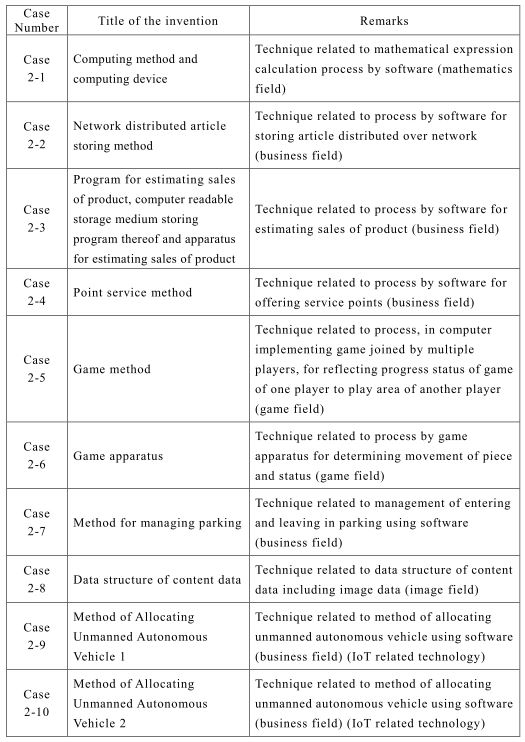
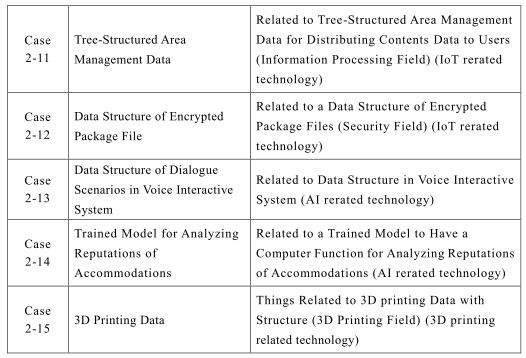
(3) Case for Determination of Inventive Step
Case List
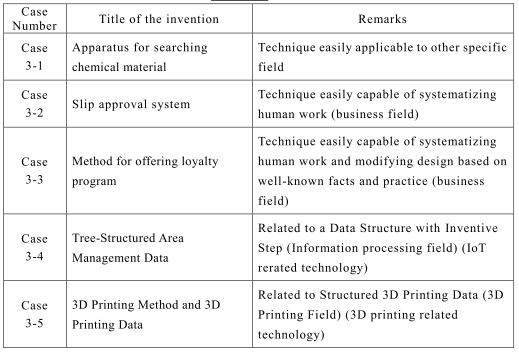
3.1 Case for requirements for description (clarity requirement)
[Case 1-1] Providing Medium
(Medium represented alternatively by storage medium or transmission medium)
Title of the invention
Providing Medium
What is claimed is:
[Claim 1]
A providing medium for causing a computer to function as an information processor comprising a means A, a means B and a means C,
the providing medium providing a computer readable program for causing the computer to perform a step a, a step b and a step c.
Excerpt from Description
The providing medium for providing a user with a computer program performing the processes of the present embodiment is deliverable as a variety of forms of computer readable media, and the present invention is applicable regardless of a specific type of medium used for actual delivery. An example of such a computer readable medium includes a storable type of medium such as a flexible disk or a CD-ROM, and a transmission type of medium such as digital and analog communication links.
[Explanation]
The relation between information and medium cannot be derived clearly only from the term "providing" medium recited in claim 1. Thus, the medium of the claimed invention can be constructed to include a medium for transmitting information as well as a medium for storing information taking the statement in the description into consideration based on the common general technical knowledge of a person skilled in the art. As a result, an invention as one technical idea cannot be clearly understood from the description of one claim since the claimed invention represents alternatively properties or functions having no similarities with each other. Therefore, it violates clarity requirement.
[Case 1-2] Computer Readable Medium Carrying Program
(Medium represented alternatively by storage medium or transmission medium)
Title of the invention
Computer readable medium carrying program
What is claimed is:
[Claim 1]
A computer readable medium carrying program for controlling a computer, comprising at least a program causing the computer to perform a procedure A, a procedure B and a procedure C.
Excerpt from Description
The computer program for implementing the present embodiment are deliverable to the computer from a medium carrying in a fixed manner such as hard disk and semiconductor memory, and a medium carrying in a flux manner such as communication network.
[Explanation]
Although, it is clear that the meaning of term "carry" in claim 1 is typically similar to the meaning of "store," there is the statement "carrying program in a flux manner" in the description, and it describes that this meaning covers almost the same scope as "transmission." As a result, the claimed invention is constructed to be "medium for storing or transmitting." Thus, an invention as one technical idea cannot be clearly understood from the description of one claim, since the claimed invention represents alternatively properties or functions having no similarities with each other. Therefore, it violates clarity requirements.
3.2 Case for eligibility for invention
[Case 2-1] Method for computing and computing device (mathematical area)
(Technique related to mathematical calculation process by software is concretely realized by using hardware resources)
Title of invention
Computing method and computing device
What is claimed is:
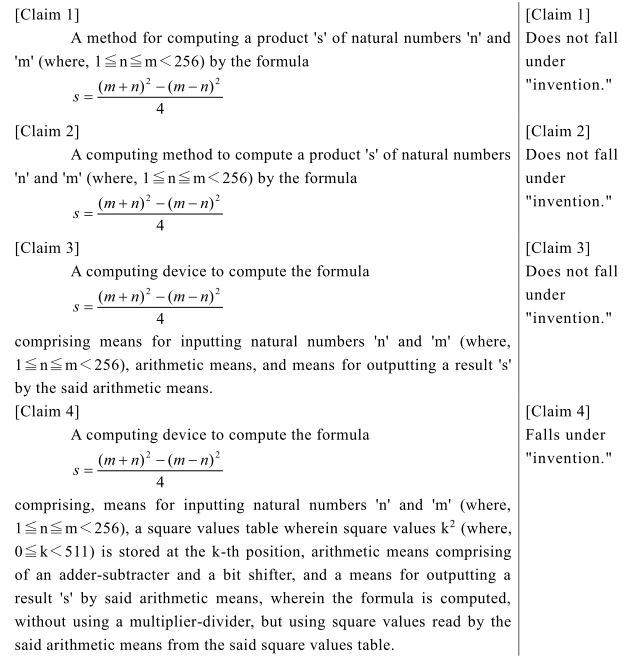
Description
[Technical field]
This invention relates to a calculation apparatus to realize high-speed calculation of multiplication, where the said calculating apparatus has just an adder-subtracter and a bit shift arithmetic unit, such as an early 8-bit CPU with limited memory, without a multiplier-divider unit so as to make the said calculation procedure manageable directly by the said CPU.
[Background art]
In order to enable a program to perform calculation process of multiplication by using a CPU with small memory space, and not using multiplier-divider unit, so that the said process can be directly managed by the said CPU, it is necessary to perform process of multiplication by software. To date, (i) the method to add the natural number 'm' n-times, or (ii) the method to refer to a multiplication table of 'm x n' have been known for realizing the said calculation process.
[Problems to be solved by the invention]
Although the method (i) does not occupy a great deal of memory due to the relatively small size of the calculation program, it takes more time to calculate depending on the value of the natural number n.
On the other hand, method (ii) requires less calculation time than method (i) because one only needs to refer to the table. However, memory becomes more limited as the table becomes larger. Especially when 1≦n≦m < 256, if results of multiplication are stored on multiplication table of 255 x 255 in two bytes, about 128 k is required for memory. This exceeds the 64k memory capacity of an early 8-bit CPU.
The problems to be solved by the invention is therefore to realize high-speed calculation process of multiplication by using the calculation apparatus, where the early date 8-bit CPU with limited memory has only an adder-subtracter and bit shift arithmetic unit but does have a multiplier-divider unit, so that the said calculation process can be directly managed.
[Means for solving the problem]
A calculating apparatus of the invention solves the said problem to adopt a program which makes a calculation apparatus perform calculation of the following formula

by utilizing a square function table of 0~510, instead of using a multiplication table of 255 x 255.
[Brief description of drawings]
(Omitted)
[Description of the embodiments]
The invention performs calculation of values (m + n) 2 and (m- n) 2 by referring to a square function table of 0~510, without using a multiplier device. It therefore requires shorter time for calculation than adding natural number m n-times, and guarantees to perform such calculation process within a certain time. In addition, since memory space required for the square function table is about 1 k bytes (511 x 2 bytes), this is much less than the 128 k bytes (256 x 256 x 2 bytes) required for a multiplication table of 255 x 255. This can therefore be accommodated within a memory space of 64 k bytes which an early date 8-bit CPU can directly manage.
Furthermore, division by 4 can be realized by performing right bit shift arithmetic twice (i.e., for 2 bit columns). The procedure for right bit shift of the decimal number 12 (1100 in binary) is as follows.

As can be understood above, when right bit shift operation is carried out twice, 12 (decimal) becomes 3 (decimal) which means division by 4 is realized.
Therefore, calculation process of multiplication is realized by a calculation apparatus including an early date 8-bit CPU which has an adder-subtracter and bit shift arithmetic unit with limited memory within less calculation time, so that the said process can be directly managed by the said CPU and does not need a multiplier-divider unit.
Drawings
(Omitted)
[Conclusion]
The invention of claim 1 does not fall under "invention."
The invention of claim 2 does not fall under "invention."
The invention of claim 3 does not fall under "invention."
The invention of claim 4 falls under "invention."
[Explanation]
Claim 1
The claimed invention is "calculation of a numerical formula itself" and corresponds to what does not utilize the laws of nature. Therefore, the claimed invention does not constitute a "statutory invention."
(Note) Since the determination is made whether the subject matter of Claim 1 falls under "invention" in accordance with "Part III Chapter 1 Eligibility for Patent and Industrial Applicability" of the examination guidelines, the determination is not made in accordance with "2.1.1.2 Idea based on the standpoint of software."
Claim 2
Claim 2 states the hardware resource of a "computing device" and a numerical formula for computing a formula. Only with these statements, however, it cannot be said that concrete means or procedure is used for implementing specific calculation or processing of information depending on the intended use, i.e., computing a formula. Thus, the subject matter of Claim 2 does not construct the specific device (information processing device) depending on the intended use through cooperation of software and hardware resources.
Therefore, since information processing by the software is not concretely realized by using the hardware resource, the subject matter of Claim 2 is not a creation of a technical idea utilizing the laws of nature, and does not fall under an "invention".
Claim 3
Claim 3 states a computing device comprises inputting means, arithmetic means, outputting means, and a numerical formula for computing a formula. Only with these statements, however, it cannot be said that concrete means or procedure is used for implementing specific calculation or processing of information depending on the intended use, i.e. computing a formula. Thus, the subject matter of Claim 3 does not construct the specific computing device (information processing device) depending on the intended use through cooperation of software and hardware resources.
Therefore, since information processing by the software is not concretely realized by using the hardware resource, the subject matter of Claim 3 is not a creation of a technical idea utilizing the laws of nature, and does not fall under an "invention".
Claim 4
Based on the statement in claim 4, it can be determined that specific calculation or processing of information depending on the intended use, i.e., computing a formula on a device which does not have any multiplier-divider unit, is implemented by concrete means or procedure through cooperation of software and the hardware resources such as a square values table and arithmetic means that calculates using the said table. Thus, the subject matter of Claim 4 constitutes a specific computing device (information processing device) depending on the intended use through cooperation of software and hardware resources.
Therefore, since information processing by the software is concretely realized by using the hardware resource, the subject matter of Claim 4 is a creation of a technical idea utilizing the laws of nature, and falls under an "invention".
[Case 2-2] Storing method of articles distributed via network (business area)
(Related to article storing process by software)
Title of invention
Storing method of articles distributed via network
What is claimed is:
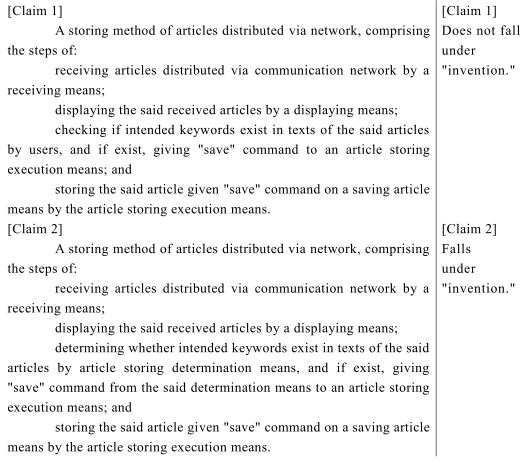
Description
[Technical field]
The invention relates to a storing method of articles distributed via communication networks such as the Internet.
[Background art]
Methods to distribute articles via communication networks such as the Internet are already known, and technologies for storing these articles are also already known.
[Problems to be solved by the invention]
However, there are not so many articles necessary to be stored, and storing all the distributed articles is a waste of memory space.
The purpose of the invention is to save the memory space by selecting which distributed articles need to be stored.
[Means for solving the problem]
(Omitted)
[Advantageous effect of the invention]
According to this invention, memory space for storing articles can be saved, since only those necessary to be stored among the articles distributed via communication network will be stored.
[Brief description of drawings]
(Omitted)
[Description of the embodiments]
The most preferred embodiment of the invention is a method wherein users determine if the distributed article needs to be stored based on the criteria if an intended keyword is included in the text of the article.
First, a receiving means such as a modem receives an article distributed via communication network such as the Internet. The received article is stored in a temporal storage means of a computer system.
Second, the received article is displayed on a display means.
Then, users determine if an intended keyword exists in the text of the said displayed article, and if exists, give "save the article" command to the article storing execution means. This process can be realized in such manner that users determine if a prescribed keyword exists in the text by reading the articles, identify the article which include the said keyword using a keyboard or mouse and give "save the article" command to the said identified articles.
Furthermore, an article storing execution means executes storing the said identified articles on an article storage means, when the "save the article" command is given from an article storing determination means.
The second preferred embodiment of the invention is a method wherein a computer determines if the distributed article needs to be stored based on the criteria if an intended keyword is included in the text of the article.
First, a receiving means such as a modem receives an article distributed via communication network such as the Internet. The received article is stored in a temporal storage means of a computer system.
Second, the received article is displayed on a display means.
Then, an article storing determination means determines if a prescribed keyword exists in the contents of displayed article, and if exists, "save the article" command is given to an article storing execution means. This process can be realized in such manner that, previously storing a prescribed keyword on temporal storage means such as memory, the article storing determination means conducts matching between the contents of the stored article on the temporal storage means and the said prescribed keyword, and determines if the keyword exists in the said article.
Furthermore, an article storing execution means executes storing the said identified articles on an article storage means, when the "save the article" command is given from an article storing determination means.
Drawings
(Omitted)
[Conclusion]
The invention of claim 1 does not fall under "invention."
The invention of claim 2 falls under "invention."
[Explanation]
Claim 1
Claim 1 states a receiving means, a displaying means and an article storing execution means, but these means are general function of a computer such as receiving information process, displaying process and storing process. Additionally, the determination of whether intended keywords are existed or not in texts of articles is done not by a concrete means but by intellectual activity of user. So, it cannot be said that concrete means procedure is used for implementing specific calculation or processing of information depending on the intended use. Thus, the subject matter of Claim 1 does not construct the specific computer information processor depending on the intended use through cooperation of software and hardware resources.
Therefore, since information processing by the software is not concretely realized by using the hardware resource, the subject matter of Claim 1 is not a creation of a technical idea utilizing the laws of nature, and does not fall under "invention."
Claim 2
From state of claim2, it can be determined that specific calculation or processing of information depending on the intended use such as storing only articles in that it is determined that the predetermined keyword exists is implemented by concrete means or procedure through cooperation of software and the hardware resources such as an article storing determination means, an article storing execution means and an article storing means. Thus, the subject matter of Claim 2 constructs the specific computer information processor depending on the intended use through cooperation of software and hardware resources.
Therefore, since information processing by the software is concretely realized by using the hardware resource, the subject matter of Claim 2 is a creation of a technical idea utilizing the laws of nature, and fall under "invention."
[Case 2-3] Apparatus for predicting daily sales of commodities
(Technique related to predicting process by software of daily sales of commodities is concretely realized by using hardware resources)
Title of invention
Apparatus for predicting daily sales of commodities
What is claimed is:
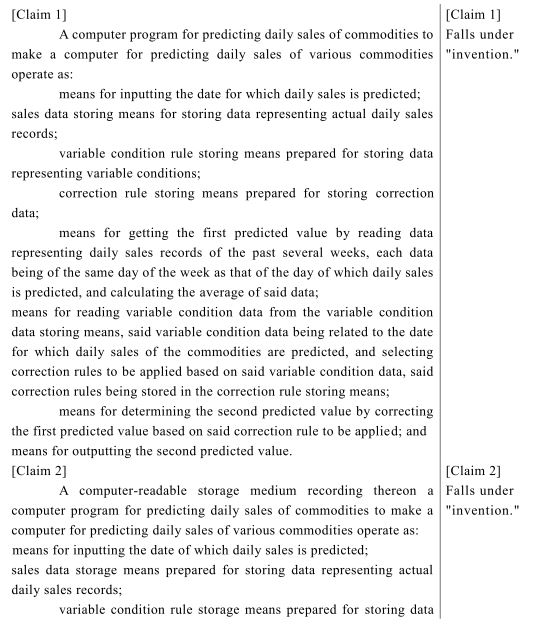
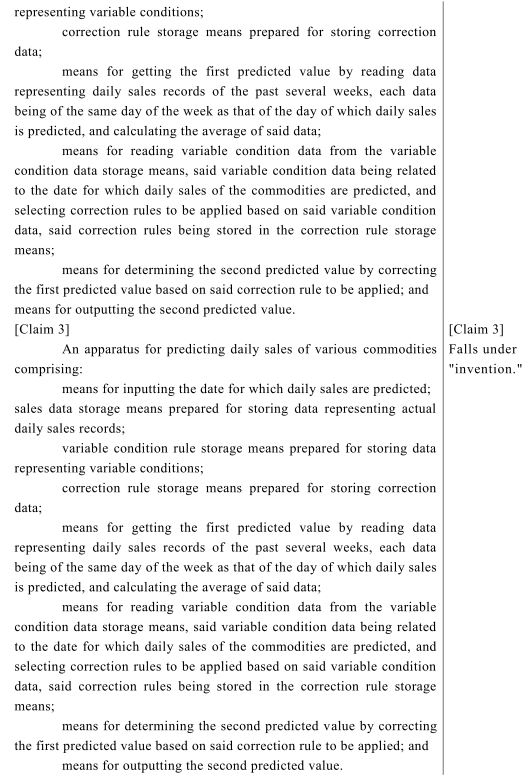
Description
[Technical field]
This invention relates to a computer system for predicting daily sales necessary for ordering commodities at a retail shop, and more particularly, to a computer system for predicting daily sales suitable for predicting daily sales of various commodities at a large scale retail shop such as a supermarket whose demand changes greatly.
[Background art]
Daily sales of commodities at a large scale retail shop such as a supermarket changes greatly, depending on various factors such as the day of the week, the date, weather, the selling status of competing shops (bargain or going out of business sale), and events held in the community. Therefore amounts of commodities to be ordered are determined depending on daily sales predictions based on inventory control experience.
Thus, carrying out a prediction took too much time especially in cases of little inventory control experience.
Moreover, overlooking of some factors of change often arose and prediction was not so accurate.
[Problems to be solved by the invention]
The problem to be solved by the invention is to provide a system for predicting daily sales which does not rely on human inventory control experience and which brings a stable result of predictions in a short time.
[Means for solving the problem]
(Omitted)
[Brief description of the drawings]
(Omitted)
[Description of the embodiments]
Fig. 1 shows the system constitution of the apparatus for predicting daily sales, and Fig. 2 shows a flow chart executed by said system.
At first, a worker inputs a date of which daily sales are predicted via an input device such as a keyboard.
Actual daily sales records are stored in advance in the sales data file associated with the date and the day of the week.
The central processing unit (CPU), being instructed by the control program stored in the main memory, reads data of the past few weeks, each being the same day of the week as that of the day of which daily sails is predicted, and calculates the average of the said data. The average of the said data is utilized as the first predicted value.
It is empirically known that using actual daily sales records in three to four weeks is preferable. Then the CPU, being instructed by the control program stored in the main memory, reads variable condition data, such as the probability of rain obtained from the weather forecast, from the variable condition data file, said variable condition data being associated with the date of which daily sales of commodities are predicted, reads correction rule being stored in the correction rule file in advance.
(Note: An example of the correction rule is "If it rains all day, a 30% decrease in the sales is expected." It is assumed that details of the correction rules are fully supported by the detailed explanation of the invention.)
Finally, the CPU, being instructed by the control program stored in the main memory, corrects the first predicted value based on said correction rule corresponding to the variable condition data, and determines the second predicted value.
The second predicted value is used as the final predicted data and is obtained from an output device such as a printer.
[Working example]
(It is assumed that all components of the mode for carrying out the invention, how to fix correction rules, etc. are fully supported by the working example.)
Drawings
[Figure 1] System Constitution of the Apparatus for Predicting Daily Sales
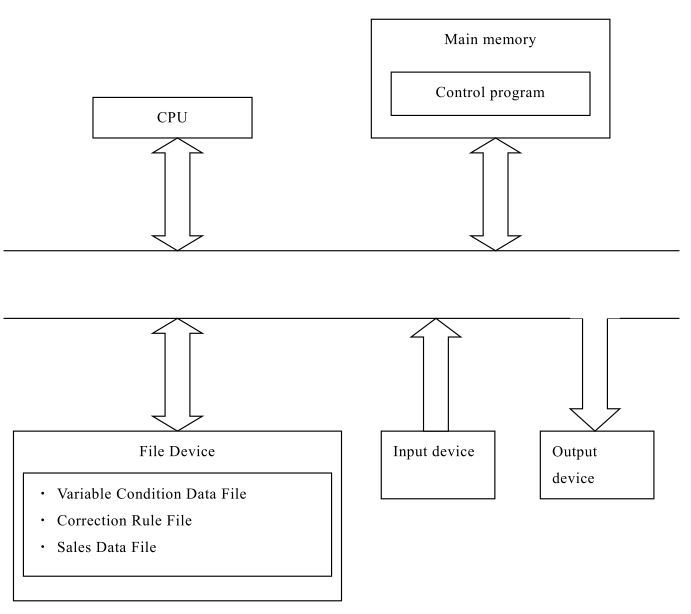 [Figure 2] Flow Chart
[Figure 2] Flow Chart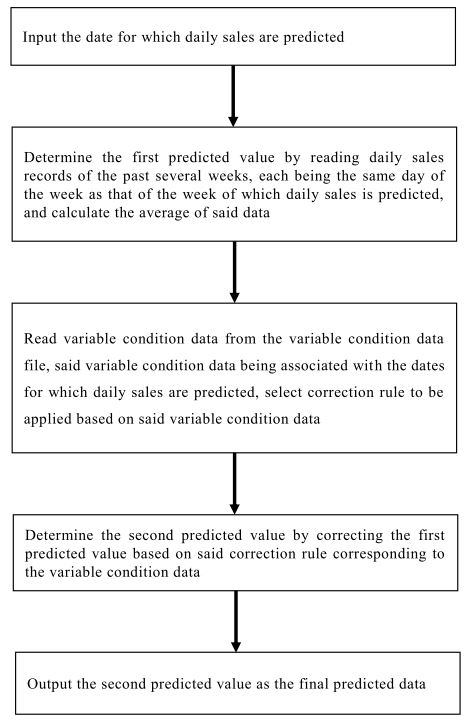
[Conclusion]
The invention of claim 1 falls under "invention."
The invention of claim 2 falls under "invention."
The invention of claim 3 falls under "invention."
[Explanation]
Claim 1
From state of claim 1, it can be determined that specific calculation or processing of information depending on the intended use such as predicting sales of commodities based on various variable conditions and correction rules is implemented by concrete means or procedure through cooperation of software and the hardware resources such as a multiple of storage means and control means to read and select data from the said storage means. Thus, the subject matter of Claim 3 constructs the specific computer (computer information processor) depending on the intended use through cooperation of software and hardware resources.
Therefore, since information processing by the software is concretely realized by using the hardware resource, the subject matter of Claim 1 is a creation of a technical idea utilizing the laws of nature, and fall under "invention."
Claim 2
The subject matter of Claim 2 is a computer-readable storage means containing thereon a computer program for predicting daily sales (the subject matter of Claim 1), therefore, the subject matter of Claim 2 fall under "invention" as in the case of claim 1.
Claim 3
The subject matter of Claim 3 is an information processing apparatus which is cooperatively working with a computer program for predicting daily sales (the subject matter of Claim 1), therefore, the subject matter of Claim 3 fall under "invention" as in the case of claim 1.
[Case 2-4] Points service method (business area)
(Technique related to points servicing process by software is concretely realized by using hardware resources)
Title of invention
Points service method
What is claimed is:


Description
[Technical field]
The present invention relates to a points service method used in mail-order business.
[Background art]
There have been in the past services to give service points depending on an amount of commodity purchased at a shop by a customer and to exchange the total service points with goods, gift coupon or cash.
[Problems to be solved by the invention]
In the past, points service methods could not be realized in mail-order business because of the customer management problem etc. In addition, because of the same reason, only the customer herself or himself could use such service points and even the family members could not be assigned with such service points.
[Means for solving the problem]
In order to realize the points service method in the mail-order business, this invention is configured to manage the service points of each customer by providing a customer list (including, at least, customer names, total service points and customer addresses) at the shop side, and adding service points when a customer purchases goods by mail-order.
And, in order to give service points from a customer to another, when the name of the person to whom service points are offered are notified, the total service points of the designated person registered in a customer list are calculated by adding the said service points, and the fact that the said service points have been given is notified to the said person by using the registered address of the said person.
By the present invention, when making communication via telephone between a customer and the shop, it is recommendable that telephone numbers of customers are registered as the contact point in the customer list.
On one hand, when making communication between a customer and the shop via the Internet, it is better to register e-mail addresses of customers as the contact point in the customer list.
Furthermore, in the present invention, by providing a shop with a server, the following procedure can be realized on a computer.
A system is configured in such a way to manage service points of each customer by providing a database of customer lists (including at least, customer names, total service points and e-mail addresses of customers) on a shop server on the Internet, and to add service points when a customer purchases goods via the Internet.
And, when a customer wants to give service points to another, by notifying the server of the said service points and the name of the person by e-mail, the server retrieves the e-mail address of the said person from the database of customer lists by the name of the said person, adds up the said service points and automatically notifies the customer that the said service points were given.
[Advantageous effect of the invention]
The present invention enables the points service method to easily be realized even in the mail-order business. In addition, since service points can be assigned to another customer, the utility of the points service method is increased.
[Brief description of the drawings]
(Omitted)
[Description of the embodiments]
(Omitted)
[Working example]
(Omitted)
Drawings
(Omitted)
[Conclusion]
The invention of claim 1 does not fall under "invention."
The invention of claim 2 does not fall under "invention."
The invention of claim 3 falls under "invention."
[Explanation]
Claim 1
The subject matter of Claim 1 is a technical method which uses means such as "a telephone" and "a customer list storage means," but considered as a whole, it is an artificial arrangement per se using those means as a tool. So that it does not constitute "a creation of technical ideas utilizing the laws of nature." Thus the subject matter of Claim 1 does not fall under "invention."
Claim 2
The subject matter of Claim 2 is a technical method which uses means such as "the Internet," "a customer list storage means" and “e-mail,” but considered as a whole, it is an artificial arrangement per se using those means as a tool. So that it does not constitute a "creation of technical ideas utilizing the laws of nature." Thus the subject matter of Claim 1 does not fall under "invention."
(Note) It is determined whether the subject matter of Claim 1 and 2 falls under "invention" in accordance with "Part III Chapter 1 Eligibility for Patent and Industrial Applicability" of the examination guidelines, the determination is not made in accordance with "2.1.1.2 Idea based on the standpoint of software."
Claim 3
From state of claim3, it can be determined that specific calculation or processing of information depending on the intended use such as receiving a notification of an amount of service points offered and a person whom the said service points are offered, adding the service points to the accumulated points of the said person stored in the said customer list storage means and notifying to the said person via e-mail using a registered e-mail address is implemented by concrete means or procedure through cooperation of software and the hardware resources such as a series of information processes by a server which has a customer list storage. Thus, the subject matter of Claim 3 constructs the specific server (computer information processor) depending on the intended use through cooperation of software and hardware resources.
Therefore, since information processing by the software is concretely realized by using the hardware resource, the subject matter of Claim 3 is a creation of a technical idea utilizing the laws of nature, and fall under "invention."
[Case 2-5] Game method
(Technique related to process, in computer implementing game joined by multiple players, for reflecting progress status of game of one player to play area of another player (game field))
Title of the invention
Game method
What is claimed is:

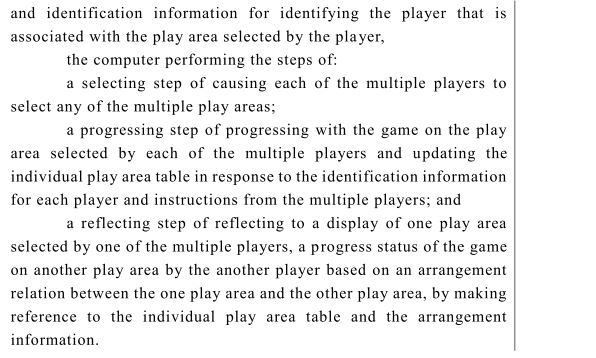
Description
[Technical field]
The present invention relates to a game method using a computer.
[Background art]
It has been known that, in a game system in which multiple players can join over a communication network, the players are capable of matching and cooperating with each other.
[Problems to be solved by the invention]
It is possible to combine smaller play areas to constitute a game space and cause the multiple players to play in different play areas respectively in order to accommodate more players in the same game space. However, since each player captures one limited play area in this case, the players in different play areas cannot cooperate with each other to proceed with the game and get a feeling of unity of playing the same game.
[Means of solving the problem]
(Omitted)
[Effect of invention]
The invention is capable of implementing the game in which the multiple players that are playing simultaneously separately in multiple play areas can cooperate with each other with a feeling of unity.
[Brief description of drawings]
(Omitted)
[Description of the embodiments]
A mobile terminal accepts an operation from a player. Also, a server controls the progress of the game played on each mobile terminal by each of the players. The mobile terminal and server are connected to each other over a communication network.
The mobile terminal comprises a mobile communicating section, a terminal storing section, an operating section, a displaying section, and a terminal processing section.
The terminal storing section comprises, for example, a semiconductor memory device. The terminal storing section stores, as an application program, a game program, etc. for progressing with the game and displaying the result. Also, the terminal storing section stores, as data, a terminal ID for identifying the mobile terminal, a player ID for identifying the player, an entire play area table for managing the entire play area, an individual play area table for managing the individual play areas constituting the entire play area, a fighter table for managing a friendly fighter, etc. used by the player, image data of objects such as an enemy character and friendly fighter, video data, and the like.
In the entire play area table, there are stored an individual play area ID for identifying the individual play area that partially constitutes the entire play area, a file name of the image data, an arrangement location in the entire play area, a level indicating challenge level for capturing, a player ID of a player in playing, an indication whether or not the individual play area is already captured, and the like.
In the game progress display of the player in an individual play area displayed in the mobile terminal of the player, a fort is displayed in a fighting situation displaying area in the upper direction and the horizontal direction, and a broken fort is displayed in the fighting situation displaying area in the lower direction. In this case, the player in the individual play area A can arrange a fighter only on the area in the lower direction to which the player can attack through the broken fort.
Once the individual play area B which is adjacent to the play area A in the upper direction is captured while the player is playing in the individual play area A, in the game progress display of the player in individual play area A, the fort in the fighting situation displaying area in the upper direction is changed to the broken fort to reflect the capture. As such, the player in the individual play area A can arrange a new fighter on the area led from the upper direction.
[Conclusion]
The invention of claim 1 does not fall under "invention."
The invention of claim 2 does not fall under "invention."
The invention of claim 3 falls under "invention."
[Explanation]
Claim 1
Claim 1 includes the process steps of selecting the play area, progressing with the game on the play area, and reflecting the progress status of game by another player. However, each process step defines a procedure of game and does not utilize the laws of nature. Thus it is only an artificial arrangement taken as a whole of claim 1.
Therefore, the subject matter of Claim 1 is not a "creation of a technical idea utilizing the laws of nature", and does not fall under "invention."
(Note) Since the determination is made whether the subject matter of Claim 1 falls under "invention" in accordance with "Part III Chapter 1 Eligibility for Patent and Industrial Applicability" of the examination guidelines, the determination is not made in accordance with "2.1.1.2 Idea based on the standpoint of software."
Claim 2
In claim 2, the computer is identified as being used. However, it is not identified specifically which means the computer employs in order to implement a sequence of procedures of selecting the play area, progressing with the game on the play area and reflecting the progress status of game by another player. Thus, it can be said that the game method is implemented for reflecting the progress status of game by another player through cooperation of software and the hardware resources, and information processing by the software is not concretely realized by using the hardware resources.
Therefore, the subject matter of Claim 2 is not a "creation of a technical idea utilizing the laws of nature," and does not fall under "invention."
Claim 3
In the subject matter of Claim 3, the computer comprises the storing section for storing the individual play area table for managing a progress status of the game in each play area, the arrangement information of each play area in the game space, and the identification information for identifying the player that is associated with the play area selected by the player. Also, the invention progresses with the game on the play area selected by each of the multiple players and updates the individual play area table in response to the identification information for each player and instructions from the multiple players, and reflects, to a display of one play area selected by one of the multiple players, a progress status of the game on another play area by the other player based on an arrangement relation between the one play area and the other play area, by making reference to the individual play area table and the arrangement information. Thus, the above features are implemented in accordance with concrete means involving cooperation by software and hardware resources, and it can be said that information processing by the software is concretely realized by using the hardware resources.
Therefore, the subject matter of Claim 3 is a "creation of technical idea utilizing the laws of nature," and falls under "invention."
[Case 2-6] Game Apparatus
(Technique related to process by game apparatus for determining movement of piece and status (game field)
Title of the invention
Game apparatus
What is claimed is:
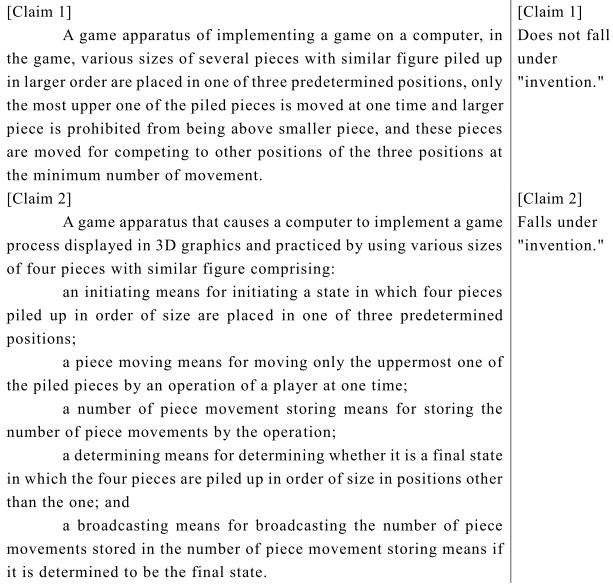
Excerpt from Description
According to the game apparatus of the present application, an interesting clever playgame can be practiced without limiting player number. Also the players are not required to count the number of piece movements, and the game apparatus broadcasts the number of movement.
[Conclusion]
The invention of claim 1 does not fall under "invention."
The invention of claim 2 falls under "invention."
[Explanation]
Claim 1
Claim 1 states the hardware resource of a "game apparatus." It also states that specific playgame is implemented by a computer. Only with these statements , however, it cannot be said that concrete means or procedure is used for implementing specific calculation or processing of information depending on the intended use, i.e., implementing a specific playgame using a computer. Thus, the game apparatus of claim 1 does not construct the specific computer information processor depending on the intended use through cooperation of software and hardware resources.
Therefore, since information processing by the software is not concretely realized by using the hardware resource, the game apparatus of claim 1 is not a creation of a technical idea utilizing the laws of nature, and does not fall under "invention."
Claim 2
From the statement of claim 2, it can be determined that the specific calculation or processing of information is implemented such as performing piece movement by the operation of a player, storing the number of piece movements, determining the status in which the pieces are piled up, and broadcasting the number of piece movements, depending on the intended use by concrete means through cooperation of software and hardware resources such as the initiating means, piece moving means, and the like that the game apparatus is provided with. Thus, the game apparatus of claim 2 constructs the specific computer information processor depending on the intended use through cooperation of software and hardware resources.
Therefore, since information processing by the software is concretely realized by using the hardware resource, the game apparatus of claim 2 is a creation of a technical idea utilizing the laws of nature, and falls under "invention."
[Case 2-7] Method for Managing Parking
(Technique related to management of entering and leaving in parking using software (business field))
Title of the invention
Method for managing parking
What is claimed is:
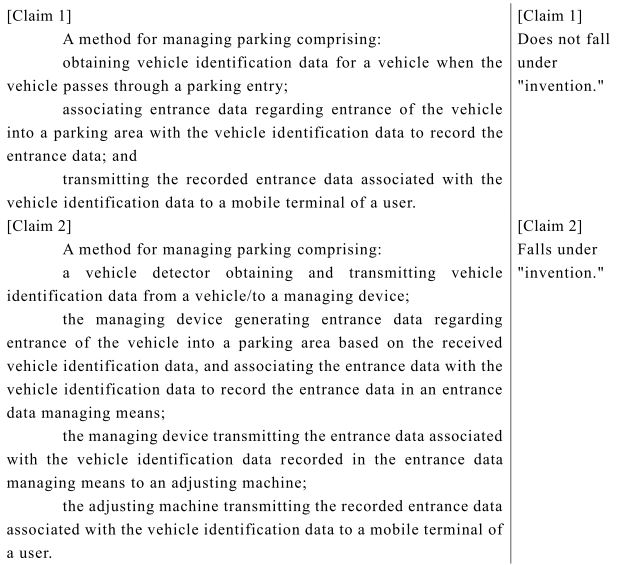
Excerpt from Description
In existing parking management, a manager manages the parking by issuing by hand, a parking ticket on paper stating information for identifying a vehicle and entrance time at a parking entry.
The purposes of the subject matter of Claims 1 and 2 are to implement parking management without the need of parking ticket on paper, and to allow a user to check parking information such as entrance time under the management.
The detailed description of the invention states the parking management implemented by the following steps.
When a vehicle detector placed at a parking entry detects a vehicle, the detector communicates with an on-board device of the vehicle, receives vehicle-identifiable ID data from the on-board device, and transmits the ID data to a managing device with the entrance time of the vehicle.
The managing device associates the ID data with the entrance time to record the ID data.
A mobile telephone transmits the ID data recorded in a mobile telephone when a user brings the mobile telephone near an adjusting machine in the parking area.
The adjusting machine transmits the ID data transmitted from the mobile telephone to the managing device.
The managing device checks the transmitted ID data with the record and transmits the relevant ID data and the associated entrance time to the adjusting machine.
The adjusting machine transmits the entrance time to the mobile telephone of the user.
[Conclusion]
The invention of claim 1 does not fall under "invention."
The invention of claim 2 falls under "invention."
[Explanation]
Claim 1
The purpose of the subject matter of Claim 1 is to "implement parking management without the need of parking ticket on paper, and to allow a user to check parking information (entrance time etc.) under the management."
The subject matter of Claim 1 uses a technical means of a "mobile terminal."
However, the mobile terminal is only used as a simple instrument for achieving the purpose, and the subject matter of Claim 1 is just an artificial arrangement for parking management taken as a whole.
Therefore, the subject matter of Claim 1 does not fall under an invention utilizing the laws of nature and is not a creation of a technical idea utilizing the laws of nature, and does not fall under "invention."
(Note) It is determined whether the subject matter of Claim 1 falls under "invention" in accordance with "Part III Chapter 1 Eligibility for Patent and Industrial Applicability" of the examination guidelines, the determination is not made in accordance with "2.1.1.2 Idea based on the standpoint of software."
Claim 2
Claim 2 states "the managing device generating entrance data based on vehicle identification data obtained from the vehicle, and associating the entrance data with the vehicle identification data to store the entrance data, and the adjusting machine transmitting the entrance data to the mobile terminal of a user." Therefore, it can be said that specific calculation or processing of information depending on the purpose (intended use) of the subject matter of Claim 2 is implemented by concrete procedure through cooperation of software and hardware resources. Thus, the subject matter of Claim 2 constructs the operation method of specific information processing system depending on intended use through cooperation of software and hardware resources.
Therefore, since it can be said that information processing by the software is concretely realized by using hardware resources, the subject matter of Claim 2 is a creation of a technical idea utilizing the laws of nature, and falls under "invention."
[Case 2-8] Data Structure of Content Data
(Technique related to data structure of content data including image data (image field))
Title of the invention
Data structure of content data
What is claimed is:
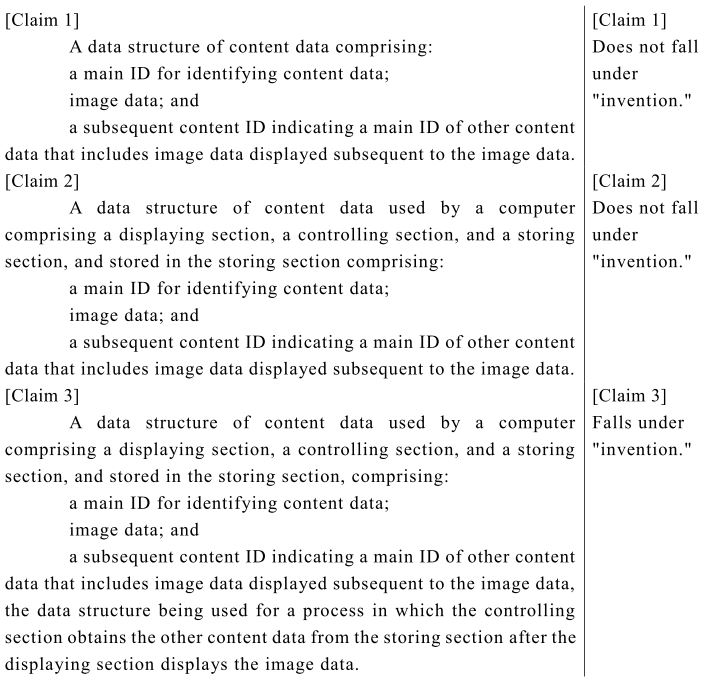
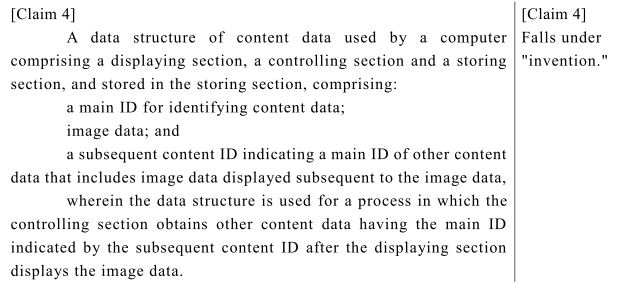
Description
[Field of invention]
The present invention relates to a data structure of content data used in image displaying by a slide show.
[Conventional art]
(Omitted)
[Problems to be solved by the invention]
(Omitted)
[Means of solving problem]
(Omitted)
[Effect of invention]
(Omitted)
[Brief description of drawings]
(Omitted)
[Detailed description]
As illustrated in FIG. 1, a computer comprises a displaying section, a controlling section, and a storing section, and is a device for displaying image data included multiple content data sequentially by a slide show. The content data stored in the storing section includes a main ID for identifying itself, image data, and a subsequent content ID indicating a main ID of other content data that includes image data displayed subsequent to the image data.
The computer performs the processes as below.
(1) The controlling section obtains first content data from the storing section and regards the first content data as a relevant content data.
(2) The displaying section displays image data included in the relevant content data.
(3) The controlling section obtains, from the storing section, other content data having the main ID indicated by the subsequent content ID that is included in the relevant content, and regards the other content data as a relevant content data.
(4) The above processes (2) and (3) are repeated.
Drawings
[FIG. 1]

[Conclusion]
The invention of claim 1 does not fall under "invention."
The invention of claim 2 does not fall under "invention."
The invention of claim 3 falls under "invention."
The invention of claim 4 falls under "invention."
[Explanation]
Claim 1
The data structure of claim 1 only defines the content of a data element included in the content data, such as the main ID, image data, and subsequent content ID, and is merely an artificial arrangement. Therefore, the subject matter of Claim 1 is not a "creation of a technical idea utilizing the laws of nature," and does not fall under "invention."
Claim 2
The data structure of claim 2 defines the content of data element included in the content data, such as the main ID, image data, and subsequent content ID. Claim 2 states that the data structure is used in the computer comprising the displaying section and controlling section and so on, and is stored in the storing section of the computer. However, it is only identified that the data structure is used in the computer having a normal functionality.
Therefore, the subject matter of Claim 2 is merely an artificial arrangement taken as a whole, is not a "creation of a technical idea utilizing the laws of nature," and does not fall under "invention."
(Note) Since claims 1 and 2 do not state any information processing prescribed by the data structure, it cannot be said that the data structure of these claims is the data structure equivalent to a program. Thus, since it is determined whether the data structure of these claims is a "creation of technical idea utilizing the laws of nature" in accordance with "Part III Chapter 1 Eligibility for Patent and Industrial Applicability" of the examination guidelines, the determination is not made in accordance with "2.1.1.2 Idea based on the standpoint of software."
Claim 3
It can be said that the data structure of claim 3 is a data structure for enabling the information processing by computer, of obtaining, from the storing part, other content data including image data displayed subsequently after displaying the image data included in the content data, from the statements of claim 3 that "the data structure is used for a process in which the controlling section obtains the other content data from the storing section after the displaying section displays the image data." Thus, the data structure has similar properties to a computer program and is a data structure equivalent to a program in that it prescribes information processing by the computer.
It can be determined that specific calculation or processing of information depending on the intended use such as displaying image sequentially is implemented by concrete means or procedure through cooperation of software (data structure equivalent to a program) and the hardware resources (the displaying part, storing part and the like included in the computer). Thus, the data structure constructs the operation method of specific computer (information processor) depending on intended use through cooperation of software and the hardware resources.
Therefore, since information processing prescribed by the data structure equivalent to a program is concretely realized by using hardware resources, the data structure of claim 3 is a "creation of a technical idea utilizing the laws of nature," and falls under "invention."
Claim 4
It can be said that the data structure of claim 4 is, as with claim 3, the data structure for enabling the information processing by computer, of obtaining, from the storing part, other content data including image data displayed subsequently after displaying the image data included in the content data, from the statements of claim that "the data structure is used for a process in which the controlling section obtains, from the storing section, the other content data having the main ID indicated by the subsequent content ID after the displaying section displays the image data." Thus, the data structure is a data structure equivalent to a program.
Therefore, since information processing prescribed by the data structure equivalent to a program is concretely realized by using hardware resources as determined in a similar manner to claim 3, the data structure of claim 4 is a "creation of a technical idea utilizing the laws of nature," and falls under "invention."
[Case 2-9] Method of Allocating Unmanned Autonomous Vehicle 1
(Technique related to method of allocating unmanned autonomous vehicle using software (business field))
Title of the invention
Method of Allocating Unmanned Autonomous Vehicle 1
What is claimed is:

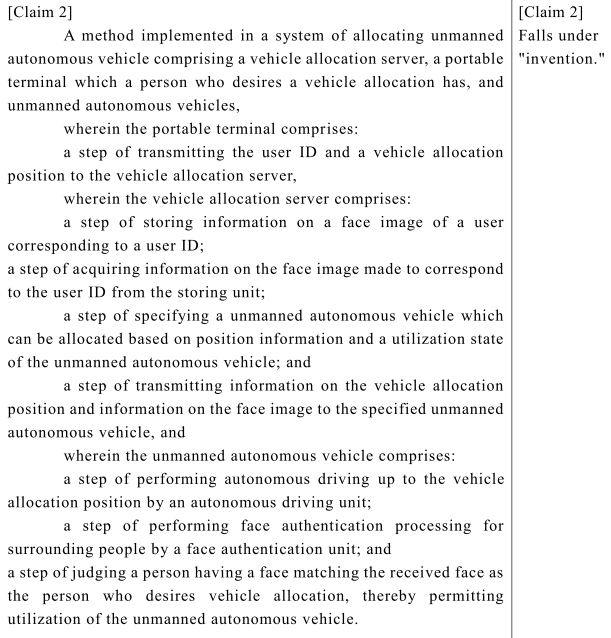
Drawing
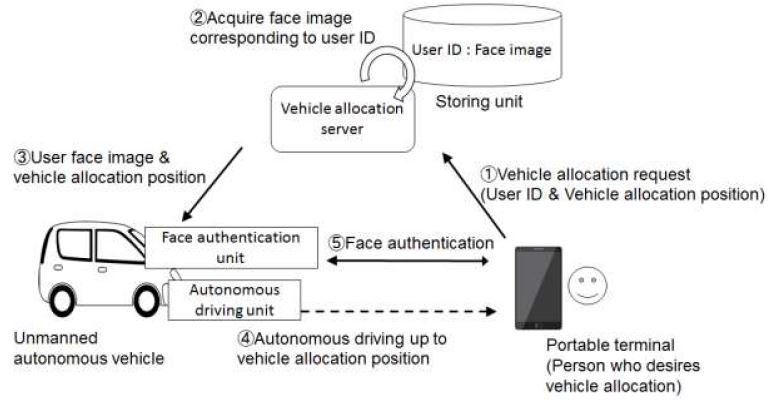
Description
[Background art]
The present invention relates to a service utilizing unmanned autonomous vehicles within a predetermined site in an amusement park, a theme park or the like.
[Problems to be solved by the invention]
As moving means within a predetermined site in an amusement park, a theme park or the like, there is a vehicle, such as a shuttle bus, traveling along a specific route but there was not a service for providing visitors with a vehicle which is freely moving within a large site like a taxi.
[Means of solving problem]
To solve the problem, the present invention provides a vehicle allocating service including authentication of users and utilizing known techniques of unmanned autonomous vehicles for which drivers are unnecessary and are capable of performing autonomous driving.
First, to provide a predetermined site with a plurality of unmanned autonomous vehicles as they can freely travel within the site. The user accesses the vehicle allocation server using his/her portable terminal in the site, thereby enabling the unmanned autonomous vehicle to travel to the desired vehicle allocation position. The vehicle allocation server which has received the vehicle allocation request specifies an unmanned autonomous vehicle which can be allocated, and issues an instruction for the specific unmanned autonomous vehicle to travel toward the vehicle allocation position.
After having arrived at the vehicle allocation position through the autonomous driving, the unmanned autonomous vehicle performs the authentication of the user based on the face authentication, and urges the user to get on the unmanned autonomous vehicle as soon as the authentication is completed. Accordingly, the user can move to the desired destination within the site in a sense of using a taxi.
[Description of the embodiments]
Hereinafter, a concrete system configuration and contents of operation will be described.
A plurality of unmanned autonomous vehicles, a vehicle allocation server, and a portable terminal within the predetermined site can communicate with each other through the network. The vehicle allocation server unitarily manages the position information of the unmanned autonomous vehicles and the current utilization states which indicate whether or not the user is getting on.
The user as the person who desires the vehicle to be allocated, firstly, manipulates his/her portable terminal, thereby requesting the vehicle allocation server to allocate the unmanned autonomous vehicle for which the vehicle allocation position is specified. Then, information including the user ID of the person who desires the vehicle allocation, and the vehicle allocation position is transmitted to the vehicle allocation server. The vehicle allocation server includes a storing unit in which face images of the users are previously made to correspond to the user IDs. Thus, when having received the user ID and the vehicle allocation position from the portable terminal, the vehicle allocation server acquires the face image made to correspond to the user ID from the storing unit. Subsequently, the vehicle allocation server specifies an unmanned autonomous vehicle which can be allocated based on the position information and the utilization states, of the unmanned autonomous vehicles, which are acquired through the network. Then, the vehicle allocation server transmits information on the vehicle allocation position and information on the face image to the specified unmanned autonomous vehicle, and issues an instruction to the specified unmanned autonomous vehicle to travel to the vehicle allocation position.
The unmanned autonomous vehicle equips an autonomous driving unit which is capable of performing autonomous driving for the destination even if a driver is absent. The unmanned autonomous unit is implemented by a known technique, which is, for example, processing various pieces of information such as the vehicle peripheral information and the position information which are acquired from a built-in radar, sensor, GPS or the like through an artificial intelligence, and controlling the driving of a motor or a steering. The unmanned autonomous vehicle further includes a unit for authenticating the face by using a camera for photographing a vehicle outside. Thus, after arrival at the vehicle allocation position, the face authentication unit performs identity verification through the face recognizing processing for finding the target user out of the surrounding people. When the face authentication unit recognizes a person having a face matching the face image received from the vehicle allocation server, the face authentication unit judges that the person as the target user who desires the vehicle allocation, and unlocks a door of the vehicle body to urge the person to get on the unmanned autonomous vehicle, thereby permitting the utilization.
Accordingly, a vehicle allocating service utilizing unmanned autonomous vehicles within a predetermined site, is realized.
The invention of claim 1 falls under "invention."
The invention of claim 2 falls under "invention."
[Explanation]
- Claim 1
Claim 1 states that the vehicle allocation server has the storing unit for storing a face image of the user corresponding to the user ID, acquires the face image made to correspond to the user ID received from the portable terminal and transmits information on the face image to the unmanned autonomous vehicle, and the unmanned autonomous vehicle performs the face authentication processing by using the received face image, etc.. From these statements, it is possible to determine that specific calculation or processing of information depending on the intended use which is an allocation of unmanned autonomous vehicles, is implemented by concrete means on which software and hardware resources cooperate, which is a system consisting of the vehicle allocation server having the storing unit, the unmanned autonomous vehicle provided with the face authentication unit, and the portable terminal. For this reason, in the invention of claim 1, a specific information processing system depending on intended use is constructed through cooperation of software and hardware resources.
Therefore, since the information processing by the software is concretely realized by using hardware resources, the invention of claim 1 is a creation of the technical idea utilizing the laws of nature, and thus falls under "invention."
- Claim 2
Claim 2 states that the vehicle allocation server has the storing unit for storing a face image of the user corresponding to the user ID, acquires the face image made to correspond to the user ID received from the portable terminal and transmits information on the face image to the unmanned autonomous vehicle, and the unmanned autonomous vehicle performs the face authentication processing by using the received face image, etc.. From these statements, it is possible to determine that specific calculation or processing of information depending on the intended use which is an allocation of unmanned autonomous vehicles, is implemented by concrete procedure on which software and hardware resources cooperate, which is a series of information processing in a system consisting of the vehicle allocation server having the storing unit, the unmanned autonomous vehicle provided with the face authentication unit, and the portable terminal. For this reason, in the invention of claim 2, an operation method of specific information processing system depending on intended use is constructed through cooperation of software and hardware resources.
Therefore, since the information processing by the software is concretely realized by using hardware resources, the invention of claim 2 is a creation of the technical idea utilizing the laws of nature, and thus falls under "invention."
[Case 2-10] Method of Allocating Unmanned Autonomous Vehicle 2
(Technique related to method of allocating unmanned autonomous vehicle using software (business field))
Title of the invention
Method of Allocating Unmanned Autonomous Vehicle 2
What is claimed is:

Drawing

Description
[Background art]
The present invention relates to a service utilizing unmanned autonomous vehicles for which a driver are unnecessary and is capable of performing autonomous driving within a predetermined site in an amusement park, a theme part or the like.
[Problems to be solved by the invention]
As moving means within a predetermined site in an amusement park, a theme park or the like, there is a vehicle, such as a shuttle bus, traveling along a specific route but there was not a service for providing visitors with a vehicle which is freely moving within a large site like a taxi.
[Description of the embodiments]
A plurality of unmanned autonomous vehicles are disposed in a state in which the unmanned autonomous vehicles can freely travel within a predetermined site. A plurality of unmanned autonomous vehicles, a vehicle allocation server, and a portable terminal can communicate with each other through the network. A user accesses the vehicle allocation server from his/her portable terminal in the site, thereby enabling an unmanned autonomous vehicle to move to the desired vehicle allocation position. The vehicle allocation server which has received the vehicle allocation request issues an instruction to the specific unmanned autonomous vehicle to travel toward the vehicle allocation position through the network. After arriving at the vehicle allocation position through the autonomous driving, the unmanned autonomous vehicle urges the user to get on the unmanned autonomous vehicle. Accordingly, the user can move to the destination within the site in a sense of using a taxi.
The invention of claim 1 does not fall under "invention."
The invention of claim 2 does not fall under "invention."
The invention of claim 1 and 2 recites "unmanned autonomous vehicles."
However, the invention of claim 1 and 2 does not recite neither the control of the unmanned autonomous vehicles or the information processing performed by the unmanned autonomous vehicles at all.
Therefore, the invention of claim 1 and 2 does not fall under neither of (a) those concretely performing control of an apparatus or processing with respect to the control or (b) those concretely performing information processing based on the technical properties such as physical, chemical, biological or electric properties of an object described in "Part III Chapter 1 Eligibility for Patent and Industrial Applicability 2.2 (2)."
Then, it is determined "whether or not information processing by the software is concretely realized by using hardware resources." Claim 1 and 2 specifies that a system comprising a vehicle allocation server, a portable terminal, and an unmanned autonomous vehicle is used. However, it is specified merely "when the vehicle allocation server receives a vehicle allocation request for the unmanned autonomous vehicle for which a vehicle allocation position is specified from the person who desires the vehicle allocation, the vehicle allocation server allocates unmanned autonomous vehicle to the person who desires the vehicle allocation" and no information processing is specified. Therefore, it is not possible to determine that concrete means or procedures for specific calculation or processing of information depending on the intended use which is an allocation of unmanned autonomous vehicles, is specified. For this reason, in the invention of claim 1 and 2, a specific information processing system or an operation method thereof depending on intended use is not constructed through cooperation of software and hardware resources.
Therefore, since the information processing by the software is not concretely realized by using hardware resources, the invention of claim 1 and 2 is not a creation of the technical idea utilizing the laws of nature, and thus does not fall under "invention."
[Measures of the applicant]
It is not possible to resolve the reason of refusal.
(Supplementary explanation)
In the detailed description of the invention, it is described merely "A plurality of unmanned autonomous vehicles, a vehicle allocation server, and a portable terminal can communicate with each other through the network" or "A user accesses the vehicle allocation server from his/her portable terminal in the site, thereby enabling an unmanned autonomous vehicle to move to the desired vehicle allocation position," etc. Furthermore, it is not described specific calculation or processing of information depending on the intended use which is an allocation of unmanned autonomous vehicles. Therefore, it is not possible to amend the claim 1 and 2 to be "the information processing by the software is not concretely realized by using hardware resources."
[Case 2-11] Tree-Structured Area Management Data
Related to Tree-Structured Area Management Data for Distributing Contents Data to Users (Information Processing Field) (IoT rerated technology)
Title of the invention
Tree-Structured Area Management Data, Contents Data Distribution Method and Contents Data
What is claimed is:
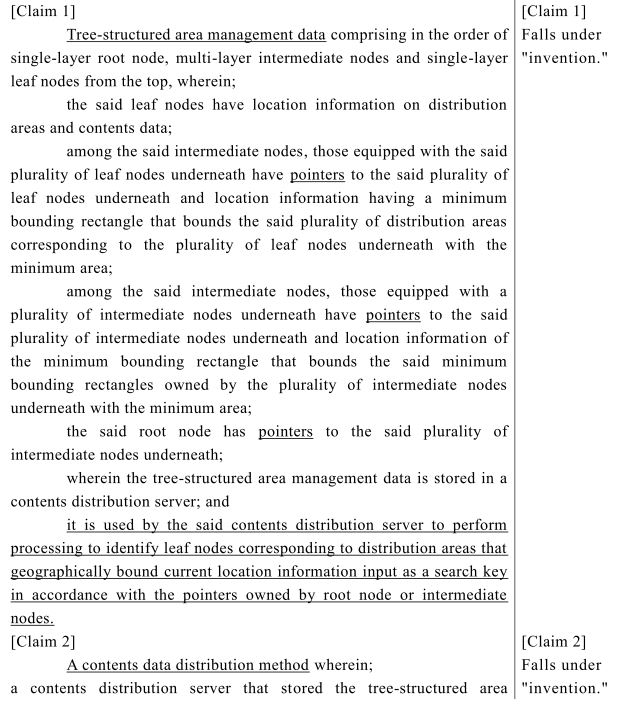
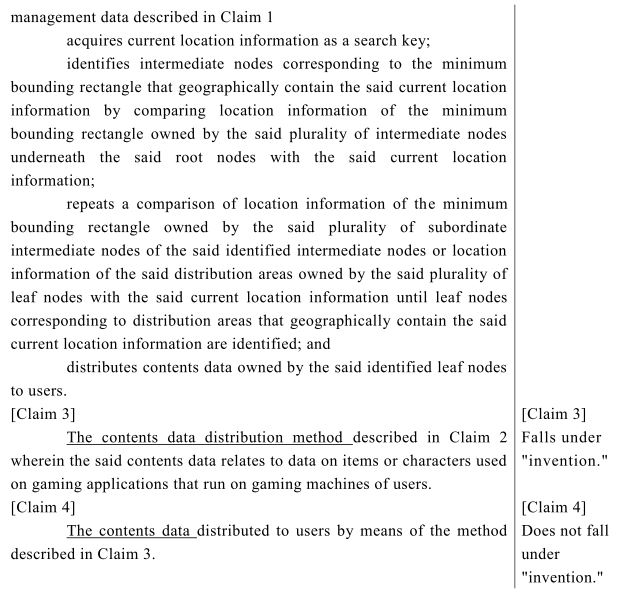
Drawing
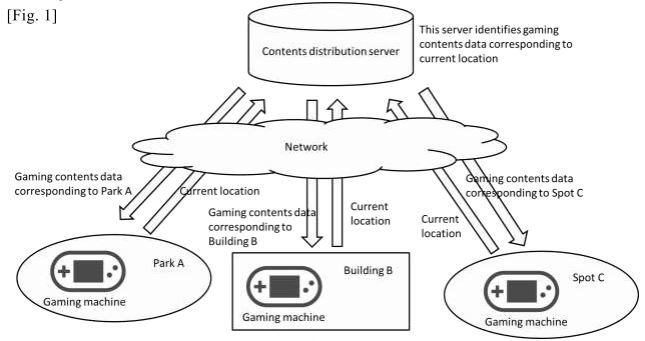
[Fig. 2]

[Fig. 3]

[Fig.4]

Overview of the description
[Technical Field]
The present invention relates to a data structure for a technology to distribute contents data to users.
[Background Art]
As described in Fig.1, there is a service for users who own gaming machines that run on specific gaming applications within specific distribution areas on a map to distribute contents data on gaming related to the distribution areas to their gaming machines. In this service, if a user is found to be in a specific distribution area while he/she is in transit, contents data related to the distribution area is automatically distributed to his/her gaming machine. Moreover, it is envisaged that the user physically moves to a specific distribution area where he/she may receive desired contents data in order to acquire it.
[Problems to be solved by the invention]
However, in order to increase a game element of those applications, it is necessary to set an enormous number of distribution areas. In the conventional techniques, it was required to compare location information on all distribution areas and current location of users so as to identify distribution areas that geographically contain current location of users. This required large computing burden. [Solution for the Problem to be solved]
(Omitted)
[Description of the embodiments]
The contents distribution server acquires current location information of users from their gaming machines as a search key, identifies distribution areas that geographically contain the current location information, and distributes contents data corresponding to the identified distribution areas to users. The gaming machines are equipped with the communication function and current location acquisition function. Contents data includes those related to items and characters used on gaming applications that run on those gaming machines. The contents distribution server manages distribution areas and contents data in a way that they are included in tree-structured area management data as described below and stored in a memory part thereof.
(Data Structure of Area Management Data)
Each distribution area defines location information based on information on latitude and longitude (x1, y1) (x2, y2) in the rectangular diagonal position. A distribution area is bounded by one minimum bounding rectangle together with one or more distribution areas nearby. The minimum bounding rectangle refers to a rectangle that bounds a plurality of distribution areas with the minimum area and defines location information based on information on latitude and longitude in the rectangular diagonal position in the same manner as distribution areas. A minimum bounding rectangle is bounded by a superordinate minimum bounding rectangle together with one or more minimum bounding rectangles nearby. In this way, a tree-structure composed of a plurality of distribution areas and minimum bounding rectangles is formed.
A root node is in the uppermost position of data structure. Nodes corresponding to minimum bounding rectangles are called intermediate nodes, while those corresponding to distribution areas are called leaf nodes. A root node has pointers to a plurality of intermediate nodes underneath. Each intermediate node has location information on a corresponding minimum bounding rectangle and a pointer to a plurality of subordinate intermediate nodes or leaf nodes. Each leaf node has location information on corresponding distribution areas and contents data.
Fig.2 is an illustrative example of distribution areas and minimum bounding rectangles. The distribution areas A - C are bounded by the minimum bounding rectangle I and the distributions areas D - F by the minimum bounding rectangle II.
Fig.3 represents a structure of area management data formed in the case of Fig.2. The intermediate node corresponding to the minimum bounding rectangle I has pointers to the leaf nodes corresponding to the distribution areas A - C, while that corresponding to the minimum bounding rectangle II has the leaf nodes corresponding to the distribution areas D - F. The uppermost root node has pointers to each of the intermediate nodes. Contents data is associated with each of the leaf nodes.
(Processing for Contents Data Distribution)
Fig.4 is used to explain processing for distributing contents data performed by the contents distribution server. Once the server acquires current location information of a user from his/her gaming machine as a search key (S1), it refers to the intermediate nodes underneath the root node (S2) and compares location information owned by the intermediate nodes with current location information (S3). Based on this comparison, it is determined whether or not there is any node corresponding to the minimum bounding rectangle that geographically contains current location information (S4), and if that is the case, subordinate nodes of the intermediate nodes are referred to (S5). If there is no such node, it is determined that there are no users in any of the distribution areas, and the processing completes and processing for distributing contents data is not performed. Then, whether or not the subordinate nodes of the intermediate nodes are leaf nodes is determined (S6). If they are not leaf nodes, that is, if they are intermediate nodes, the process returns to S3 and the procedures of S3 - S5 are repeated until those nodes reach a leaf node. If they are found to be leaf nodes, location information on distribution areas owned by the leaf nodes and current location information are compared (S7) to determine whether or not there is any leaf node corresponding to distribution areas that geographically contain current location information (S8). If there is such a leaf node, contents data owned thereby is distributed to users (S9). On the other hand, if there is no such leaf node, it is determined that there are no users in any of the distribution areas, and the processing completes and processing for distributing contents data is not performed.
Specific processing for distributing contents data is shown using the examples in Figs. 2 and 3. In these examples, a user exists in the distribution area C. By repeating process of comparing location information on distribution areas owned by the root node and intermediate nodes with current location information, it is determined that current location information is contained geographically in the minimum bounding rectangle I. Then, location information on the distribution areas A - C owned by a subordinate leaf node of the intermediate node corresponding to the minimum bounding rectangle I is compared with current location information to determine whether or not it is contained geographically in the distribution area C. Therefore, contents data owned by the leaf node corresponding to the distribution area C is distributed to users.
As discussed here, the management of distribution areas with tree-structure only requires the processing of comparison for the number of stages of the tree-structure in order to identify distribution areas that geographically contain current location information of users that was input as search keys. As a result, this method may identify distribution areas at higher speed compared to the conventional technique of comparing location information on all distribution areas with current location of users.
[Conclusion]
The inventions of claim 1-3 fall under "invention."
The invention of claim 4 does not fall under "invention."
[Explanation]
- Claim 1
The area management data of Claim 1 is data having a structure capable of identifying distribution areas that geographically contain current location information input as a search key by means of information processing in accordance with pointers owned by root nodes and intermediate nodes. Thus, the "structured data" has similar properties to the computer program in that a structure of the data prescribes information processing by computer so that this structured data is determined to be equivalent to the computer program.
Moreover, it is determined, from the statement of Claim 1, that computing or processing of specific information in accordance with its purpose of use, that is, the identification of distribution areas including current location input as a search key, is realized by concrete means or procedures, that is, a series of information processing by the contents distribution server that stores area management data by means of the collaboration between the software ("structured data" equivalent to the computer program) and hardware resources. The "structured data" is thus determined to establish an operating method of a specific information processing device in accordance with the purpose of use by means of the collaboration between the software and hardware resources.
Therefore, as information processing prescribed by the "structured data" equivalent to the computer program is concretely realized using hardware resources, the area management data of Claim 1 is a creation of the technical idea utilizing the laws of nature and thus falls under "invention."
- Claim 2
It is determined, from the description of Claim 2, that computing or processing of specific information in accordance with its purpose of use, that is, the distribution of contents data in accordance with current location input as a search key, is realized by concrete procedures, that is, a series of information processing by the contents distribution server that stores area management data, by means of the collaboration between the software and hardware resources. The method of Claim 2 is thus determined to establish an operating method of a specific information processing device in accordance with the purpose of use by means of the collaboration between the software and hardware resources.
Therefore, as information processing by the computer program is concretely realized using hardware resources, the method of Claim 2 is a creation of the technical idea utilizing the laws of nature and thus falls under "invention."
- Claim 3
Since Claim 3 cites Claim 2, it is determined, from the description of Claim 3, that computing or processing of specific information in accordance with its purpose of use, that is, the distribution of contents data in accordance with current location input as a search key, is realized by concrete procedures, that is, a series of information processing by the contents distribution server that stores area management data by means of the collaboration between the software and hardware resources in the same manner as the determination made in Claim 2. The method of Claim 3 is thus determined to establish an operating method of a specific information processing device in accordance with the purpose of use by means of the collaboration between the software and hardware resources.
Therefore, as information processing by the computer program is concretely realized using hardware resources, the method of Claim 3 is a creation of the technical idea utilizing the laws of nature and thus falls under "invention."
- Claim 4
Mere presentation of information (where the feature resides solely in the content of the information, and the main object is to present information), such as presentation of information (presentation per se, means for presentation or method of presentation) in which a technical feature does not reside, does not fall under "invention" ("creation of the technical idea utilizing the laws of nature") mentioned in the main paragraph of Article 29(1).
The contents data of Claim 4 relates to data on items or characters used on gaming applications that run on gaming machines of users. The only thing identified is that such data is distributed from the contents distribution server to users. The distribution processing and the distribution method do not have any technical features. Therefore, the contents data of Claim 4 does not have technical features in the presentation of information (presentation per se, means for presentation or method of presentation), its feature resides solely in the content of the information that "it is data on items or characters used on gaming applications that run on gaming machines of users," and its main object is to present information. Moreover, since the contents data is owned only by the leaf nodes of area management data and its structure does not prescribe any information processing by computers, it does not fall under "structured data" equivalent to the computer program either.
Therefore, since the contents data of Claim 4 is mere presentation of information, it is not a creation of the technical idea utilizing the laws of nature as a whole and thus does not fall under "invention."
[Measures of the applicant]
It is understood that regarding the contents data its feature resides solely in the content of information and that it is not equivalent to the computer program as far as the description etc. are referred to. Therefore, the contents data of Claim 4 cannot overcome the reason for refusal.
[Case 2-12] Data Structure of Encrypted Package File
Related to a Data Structure of Encrypted Package Files (Security Field) (IoT rerated technology)
Title of the invention
Data Structure of Encrypted Package File
What is claimed is:
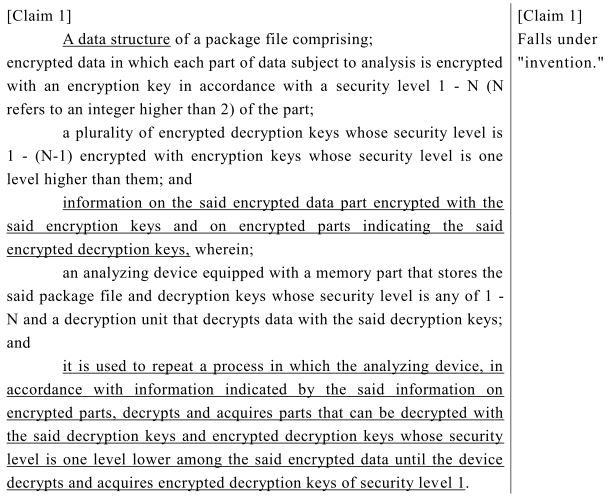
Drawing
[Fig. 1] ("Security level" is indicated as "level" for the purpose of simplification)
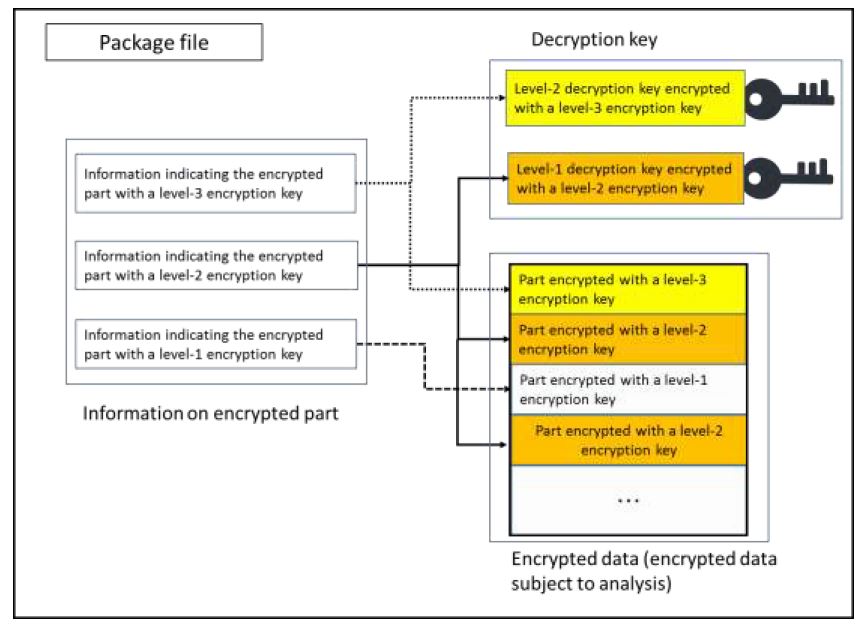

Overview of the description
[Technical Field]
The present invention relates to a data structure that encrypts data subject to analysis including parts of different security levels.
[Background Art]
In response to the progress of IoT technology in recent years, it has become possible to collect bulk data (so called big data) on the status of operation of devices and behaviors of individuals (histories of movement, purchase, etc.) acquired from various sensors. The study on analytical techniques has become popular to analyze such big data and obtain useful knowledge. On the other hand, since such data includes a great deal of confidential information of enterprises and personal information of individuals, sufficient care should be taken to protect security when data subject analysis is provided to data analysts.
As one of security measures, there is a system that allows data provider to set a plurality of security levels for each part of data subject to analysis and for data analysts to whom data is provided. In this case, each part of data subject to analysis is encrypted with an encryption key in accordance with its security level, while a plurality of decryption keys whose security levels are lower than those set for analysts are provided thereto. Data analysts decrypt parts for which security levels lower than those set therefor in the data subject to analysis using the decryption keys provided. For example, we suppose a case where security level 3 is set for information on "addresses", security level 2 for information on "names," and security level 1 for other parts in the data subject to analysis, and data is encrypted with encryption keys in accordance with their security level and then provided to data analysts. In this case, decryption keys of levels 1 - 3 are provided to data analysts of security level 3 so that they may decrypt the whole data subject to analysis for their analysis. Decryption keys of levels 1 and 2 are provided to data analysts of security level 2 so that they may decrypt parts other than information on "addresses" for their analysis.
[Problems to be solved by the invention]
In the conventional encryption system mentioned above, data analysts had to own a plurality of decryption keys in accordance with the number of several security levels. This caused burden for data analysts and the management of decryption keys was complicated.
[Solution for the Problem to be solved]
In the present invention, only one decryption key is provided originally to data analysts regardless of their security level by providing data analysts with package files that add a plurality of encrypted decryption keys and information on encrypted parts to data subject to analysis encrypted in accordance with security levels. That is, although data analysts originally have only one decryption key, they may decrypt data parts within the range in accordance with their security level with respect to encrypted data encrypted with a plurality of encryption keys of different security levels.
The specific embodiment is explained below. It is supposed that there are three security levels (1 - 3).
(Data Structure of Package File)
Fig. 1 shows one example of data structure of package files. A data administrator creates a package file under the following procedures based on data subject to analysis he/she has in order to provide an analyst therewith. As a simple example of data subject to analysis, there is a document file in which security levels are set for each paragraph considering the paragraphs as "parts," but not limited thereto. For example, if data subject to analysis is a structured document, a system to set security levels for each part defined by a specific tag ("address" tag, etc.) is conceivable. Data subject to analysis may be images or music data.
Firstly, the respective parts of data subject to analysis are encrypted with separate encryption keys in accordance with their security levels (1 - 3) and included in the package file as encrypted data. Then, decryption keys corresponding to the plurality of encryption keys used for the said encryption are encrypted with encryption keys whose security levels are one level higher than them. However, decryption keys of the highest security level are not encrypted. In this embodiment, decryption keys of security levels 1 and 2 are encrypted with encryption keys of security levels 2 and 3, respectively. The plurality of encrypted decryption keys is included in the package file as encrypted decryption keys.
Lastly, information on encrypted parts indicating parts of the said encrypted data encrypted with encryption keys of those security levels and the said encrypted decryption keys is created for each security level, and included in the package file. Specifically, "information indicating parts encrypted with encryption keys of security level 3" includes address of data subject to analysis encrypted with encryption keys of security level 3 and decryption keys of security level 2 encrypted with encryption keys of security level 3 in the package file.
(Information Processing by Analyzing Device)
A data administrator provides a data analyst with the said package file created and one decryption key of a security level set therefor.
An analyzing device owned by the data analyst is equipped with a memory part to store the package file and the decryption key of any of the security levels (1 - N) and a decryption part to decrypt data using decryption keys. By decrypting the said package file using the said decryption key of any of the security levels acquired, the data analyst obtains data subject to analysis in accordance with his/her security level.
Specific information processing performed by the analyzing device is explained as follows (Fig. 2).
S1: The analyzing device acquires the said package file and given decryption key of any of the security levels and stores it in the memory part.
S2: A security level of the said one decryption key acquired is set to be M.
S3: If M is 2 or higher, the processing described in S4 is performed. If M is 1, the processing described in S6 is performed.
S4: In accordance with information indicated by the said information on encrypted parts corresponding to security level M, access an encrypted data part encrypted with an encryption key of security level M and an encrypted decryption key of security level (M-1) to decrypt the said part and the encrypted decryption key with a decryption key of security level M.
S5: A security level (M-1) of the decryption key decrypted in S4 is newly set as M and the process returns to S3.
S6: In accordance with information indicated by the said information on encrypted parts corresponding to security level 1, access the encrypted data part encrypted with an encryption key of security level 1 to decrypt the said part with a decryption key of security level 1.
[Effect of Invention]
The present invention can simplify the management of decryption keys, because an analyzing device sequentially decrypts encrypted parts and decryption keys of subordinate security levels so that it is possible to decrypt parts of data in accordance with security levels of the device, although only one decryption key regardless of the security level is provided to data analysts.
[Conclusion]
The inventions of claim 1 falls under "invention."
[Explanation]
- Claim 1
The data structure of package file of Claim 1 can be said to be a data structure which enables the processing of decrypting encrypted parts and decryption keys of subordinate security levels sequentially, from its statement that "an analyzing device equipped with a memory part that stores the said package file and decryption keys whose security level is any of 1 - N and a decryption unit that decrypts data with the said decryption keys; and it is used to repeat a process in which the analyzing device, in accordance with information indicated by the said information on encrypted parts, decrypts and acquires parts that can be decrypted with the said decryption keys and encrypted decryption keys whose security level is one level lower among the said encrypted data until the device decrypts and acquires encrypted decryption keys of security level 1." Since the data structure has similar properties to the computer program in that it prescribes information processing performed by an analyzing device, it is equivalent to the computer program (computer software).
Moreover, we may determine, from the statement of Claim 1, that computing or processing of specific information in accordance with its purpose of use, that is, an analyzing device having one decryption key sequentially decrypts encrypted parts and decryption keys of subordinate security levels and thereby decrypting the decryption of data parts in accordance with security levels of the analyzing device, is realized by concrete means or procedures, that is, a series of information processing by the analyzing device by means of the collaboration between the software (data structure equivalent to the computer program) and hardware resources. The data structure is thus determined to establish an operating method of the specific information processing device in accordance with the purpose of use by means of the collaboration between the software and hardware resources.
Therefore, as information processing prescribed by the data structure equivalent to the computer program is concretely realized using hardware resources, the data structure of Claim 1 is a creation of the technical idea utilizing the laws of nature and thus falls under "invention."
[Case 2-13] Data Structure of Dialogue Scenarios in Voice Interactive System
Related to Data Structure in Voice Interactive System (AI rerated technology)
Title of the invention
Data Structure of Dialogue Scenarios in Voice Interactive System
What is claimed is:
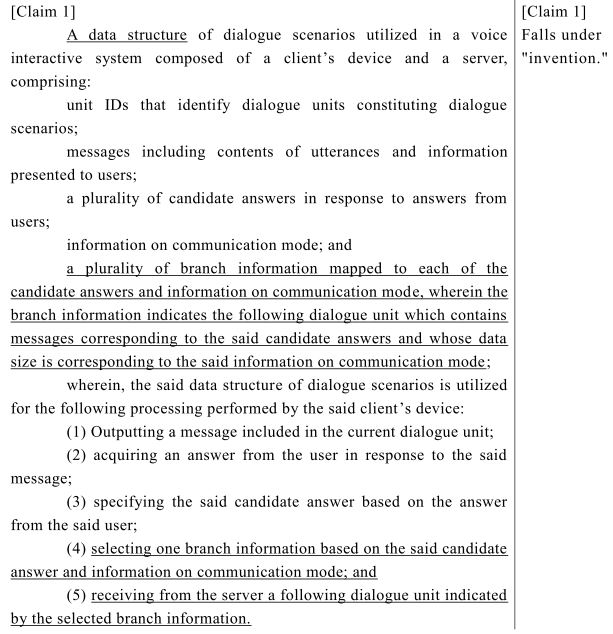
Overview of the description
[Background Art]
In recent years, research and development have progressed aiming at realization of interactive artificial intelligence (AI) that gives users a feeling of actual conversations or communications. The present invention relates to a data structure of dialogue scenarios utilized in voice interactive systems to realize such interactive AI.
As one technique of voice interactive systems, we have a technique of managing contents of dialogues based on dialogue scenarios. A dialogue scenario maps the subsequent scenario to each of candidate answers from a user, and a dialogue is forwarded by selecting one of the scenarios in response to an answer from the user. For example of dialogue scenarios, in the case where a user is asked, "do you like ramen?", a voice dialogue is performed by selecting different scenarios according to positive answers (the user likes ramen) or negative answers (the user does not like ramen) from the user. When a dialogue scenario is created, it is possible to utilize a collection of natural and human dialogue patterns generated by collecting corpus data on actual dialogues from comments posted on websites or social networking services and by analyzing and learning such data with the use of natural language processing technologies such as morphological analysis and syntax analysis.
Voice interactive systems are widely utilized in smartphones, etc. In this case, dialogue scenarios are usually managed by voice dialogue servers.
[Problems to be solved by the invention]
However, conventional voice interactive systems do not give any consideration to the capacity of communications with servers. The monthly capacity of communications is often restricted in the case of communication systems including smartphones. The capacity of communications differs from one price plan to another selected by users. While some users whose monthly capacity of communication is small want to enjoy voice dialogues consuming a small capacity of communications, other users whose monthly capacity of communications is large expect to enjoy high-quality voice dialogues.
The present invention aims to provide a data structure that allows users to select dialogue scenarios adapted to communication capacities they look for.
[Description of the embodiments]
(Overall Structure)
A dialogue scenario describes how a dialogue continues in the tree shape and one unit of dialogue is herein called "dialogue unit." The overall dialogue scenario is stored in a memory part of a server and sent to a client’s terminal by dialogue unit. The client’s terminal is equipped with a well-known composition such as CPU, memory, touch screen, microphone and speaker. The well-known composition realizes various functions including the function to communicate with the server, the function to store dialogue units received from the server, the function of playing messages included in dialogue units in the form of audio output and image display, and the function of receiving answers from users to messages in the form of voice, character entry, etc.
(Data Structure)
Fig. 1 illustrates one example of data structure of a dialogue scenario. Each of the dialogue units that constitutes the dialogue scenario contains data including, unit IDs, messages indicating contents of utterances to users and information presented, a plurality of candidate answers in response to answers from users, information on communication mode ("saving mode" or "high-quality mode") and a plurality of branch information mapped to each of the candidate answers and information on communication mode, wherein the branch information indicates the following dialogue unit which contains messages corresponding to the said candidate answers and whose data size is corresponding to the said information on communication mode. The said messages may be mere contents of utterances to be played in audio (Dialogue ID2 or ID4 in Fig. 1) or presented information such as images to be displayed together with audio output reproduction (Dialogue ID3 or ID5 in Fig. 1). Thus, the data size of dialogue units differs greatly depending on contents of messages included in dialogue units. In cases where the data size of following dialogue units indicated by the branch information is small, "saving mode" is mapped to the branch information. In cases where the data size of dialogue units indicated by the branch information is large, "high-quality mode" is mapped to the branch information for management. By this way, a plurality of options can be offered as candidates of following dialogue units in response to one candidate answer, in accordance with the capacity of communications.
(Information Processing in Voice Interactive System)
Firstly, after one dialogue unit is distributed to a client’s terminal, a message in the dialogue unit is played with the client’s terminal. When the client’s terminal acquires an answer from the user to the message, the candidate answer is specified based on the answer. The specification is executed, for example, by specifying the most similar candidate answer to the answer from the user through a matching of strings relating to the answer from the user with strings relating to candidate answers. Then, one branch information is selected from a plurality of branch information corresponding to the specified candidate answer. The details of how to select branch information will be described below. When the selected branch information is sent to the server, a following dialogue unit indicated by the branch information is sent to the client’s device from the server. A voice interactive system is realized by repeating this processing.
(Selection of Branch Information)
In the present voice interactive system, the communication mode of clients’ terminals is set as "saving mode" or "high-quality mode." A communication mode may be set automatically in accordance with price plans of clients’ terminals or the status of communications, or manually by users. It is also possible to switch a mode where necessary during voice dialogues.
In cases where "saving mode" is set for clients’ terminals, branch information mapped to "saving mode" is selected, while in cases where "high-quality mode" is set, branch information mapped to "high-quality mode" is selected. By this way, in cases where "saving mode" is set, voice dialogues may be realized in a small communication capacity, since dialogue units whose data size is small are sent sequentially to the clients’ devices. On the other hand, in cases where "high-quality mode" is set, the user may enjoy high-quality voice dialogues, since dialogue units whose data size is large are sent sequentially to the clients’ devices.
(Other Embodiments)
In the above embodiment, the case where there are only two communication modes, "saving mode" and "high-quality mode" is explained, but not limited thereto. More detailed setting of communication capacity may be allowed by offering three or more communication modes.
The inventions of claim 1 falls under "invention."
[Explanation]
- Claim 1
It can be said that the data structure of Claim 1 enables information processing, that is for voice dialogues based on branch information included in dialogue units, from the statement of Claim 1 that "the said data structure of dialogue scenarios is utilized for the following processing performed by the said client’s device:
(1) Outputting a message included in the current dialogue unit;
(2) acquiring an answer from the user in response to the said message;
(3) specifying the said candidate answer based on the answer from the said user;
(4) selecting one branch information based on the said candidate answer and information on communication mode; and
(5) receiving from the server a following dialogue unit indicated by the selected branch information."
Since the data structure has similar properties to the computer program in that it defines information processing performed in voice interactive systems, it is equivalent to the computer program (computer software).
Moreover, it can be determined, from the statement of Claim 1, that computing or processing of specific information in accordance with its purpose of use, that is, voice dialogues in accordance with branch information included in dialogue units, is realized by concrete means or procedures, that is, a series of information processing by a voice interactive system composed of the server and clients’ devices by means of the collaboration between the computer software (data structure equivalent to the computer program) and hardware resources. The data structure is thus determined to establish an operating method of the specific information processing device in accordance with the purpose of use by means of the collaboration between the computer software and hardware resources.
Therefore, as information processing prescribed by the data structure equivalent to the computer program is concretely realized utilizing hardware resources, the data structure of Claim 1 is a creation of the technical idea utilizing the laws of nature and thus falls under "invention."
[Case 2-14] Trained Model for Analyzing Reputations of Accommodations
Related to a Trained Model to Have a Computer Function for Analyzing Reputations of Accommodations (AI rerated technology)
Title of the invention
Trained Model for Analyzing Reputations of Accommodations
What is claimed is:
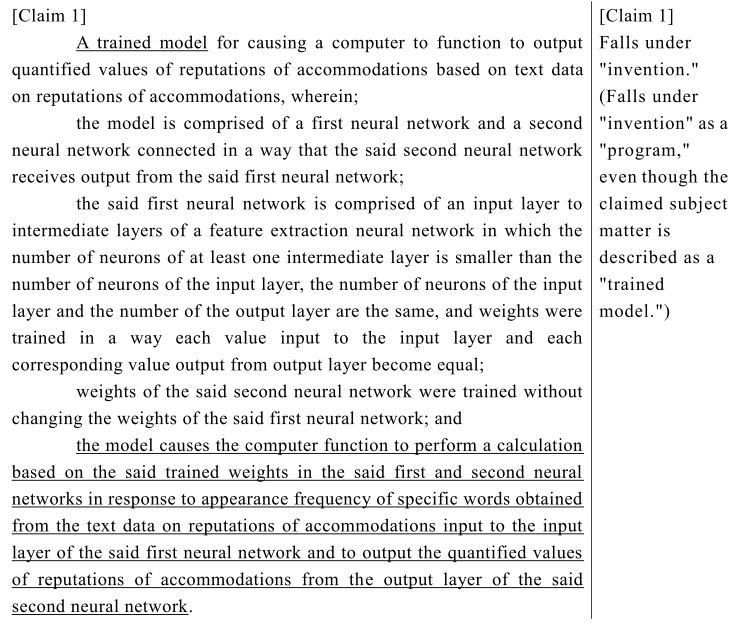
Drawing
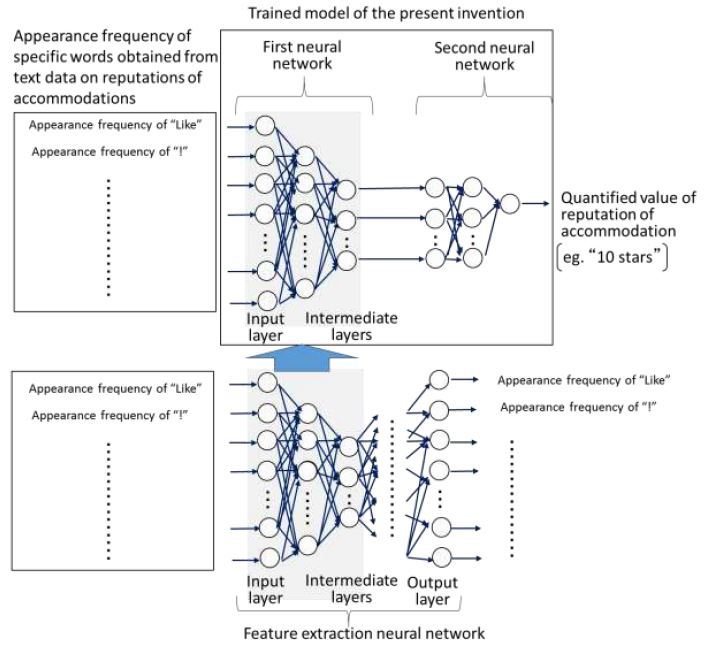
Overview of the description
[Background Art]
A neural network, which has a computer function as a computing unit to calculate output in response to certain input, is capable of performing complicated information processing at high speed by being trained from a number of actual examples. Therefore, people intend to use neural networks for various purposes in such fields as image recognition, voice recognition, voice synthesis and automated translation.
Generally, in cases where neural networks are utilized in new areas, in many cases it is not clear what should be input as the input feature values, therefore, it is necessary to carefully review what should be selected as the input feature values accordingly.
In order to analyze text data on reputations of accommodations such as hotels posted on travel review sites with neural networks, it is not straightforward to select the input feature values, because the appearance frequencies of a variety of words ("Like", "!", etc.) included in the text data can be considered as the candidate input feature values.
[Problems to be solved by the invention]
The present invention has been conceived in view of the above problems into consideration and aims to accurately analyze reputations of accommodations even if the input feature values are not properly pre-selected.
[Solution for the Problem to be solved]
The trained model of the present invention aims to cause a computer to function to output quantified values of reputations of accommodations based on text data on reputations of accommodations and is comprised of a first neural network and a second neural network connected in a way that the second neural network receives output from the first neural network. The trained model is supposed to be utilized as a program module which constitutes a part of artificial intelligence software.
The trained model of the present invention is utilized in a computer equipped with a CPU and a memory. Specifically, the CPU of the computer operates, in accordance with instructions from the trained model stored in the memory, in a way that it performs a calculation based on trained weights and response functions in the first and second neural networks in response to data input to input layers of the first neural network (appearance frequency of specific words obtained from text data of reputations of accommodations, e.g. by performing morphological analyses) and outputs results from output layers of the second neural network (quantified values of reputations, e.g. "10 stars").
The first neural network is comprised of an input layer to intermediate layers of a feature extraction neural network. This feature extraction neural network is generally called autoencoder. In this network, the number of neurons in the intermediate layers is smaller than the number of neurons in the input layer. The number of neurons in the input layer and the number of neurons in the output layers are set to be equal. Moreover, a response function of each of the neurons in the input and output layers is a linear function, and other response functions of each of the neurons are sigmoid functions (1/(1+exp(-x))).
The feature extraction neural network is trained by means of a well-known art called back propagation method and weights between neurons are updated. In the embodiment of present invention, this neural network is trained to minimize mean square errors for overall input data so that data (each appearance frequency of a plurality of words obtained from text data on reputations of accommodations by performing morphological analyses) is input in the input layers and data the same as this input data is output from the output layers. Since sigmoid functions which are non-linear functions are utilized as neuron’s response functions as explained earlier, the weights between neurons are not symmetrical across the intermediate layer. As the feature extraction neural network is trained, the intermediate layer become possible to obtain the feature values indicating characteristics of each input data. Although the feature values that appear in the intermediate layer do not necessarily have clear physical implication, those feature values are considered as what were compressed to the extent that information input to the input layer can be restored to information output from the output layer and the feature values that appear in the intermediate layer become almost similar regardless of the input feature values to the input layer. Therefore, it is not necessary to properly preselect the input feature values to the input layer any more.
In the present invention, the part from the input layer to the intermediate layers in the feature extraction neural network in which weights were trained is connected to the second neural network as the first neural network. Weights of the second neural network are trained without changing weights of the said first neural network. The training is performed by a well-known art called a back propagation method as explained earlier.
Since the trained model of the present invention is comprised of the above first and second neural networks, it can accurately analyze reputations of accommodations without presetting the feature values.
[Conclusion]
The inventions of claim 1 falls under "invention."
[Explanation]
- Claim 1
The trained model of Claim 1 is what "causes a computer to function to output quantified values of reputations of accommodations based on to text data on reputations of accommodations" as well as to what "causes the computer function to perform a calculation based on the said trained weights in the said first and second neural networks in response to appearance frequency of specific words obtained from the text data on reputations of accommodations input to the input layer of the said first neural network and to output the quantified values of reputations of accommodations from the output layer of the said second neural network." Moreover, considering the descriptions which states that "the trained model is supposed to be utilized as a program module which constitutes a part of artificial intelligence software" and "the CPU of the computer operates, in accordance with instructions from the trained model stored in the memory, in a way that it performs a calculation based on trained weights and response functions in the first and second neural networks in response to data input to input layers of the first neural network (appearance frequency of specific words obtained from text data of reputations of accommodations, e.g. by performing morphological analyses) and outputs results from output layers of the second neural network (quantified values of reputations, e.g. "10 stars")", it is clear that the trained model of Claim 1 is a "program" even though the claimed subject matter of Claim 1 is described as a "model."
Moreover, it is determined, from the statement of Claim 1, that specific calculation or processing of specific information depending on the intended use which is accurate analysis of reputations of accommodations, is implemented by concrete means or procedures on which software and hardware resources cooperate, which is for a computer to "function to perform a calculation based on the said trained weights in the said first and second neural networks in response to appearance frequency of specific words obtained from the text data on reputations of accommodations input to the input layer of the said first neural network and to output the quantified values of reputations of accommodations from the output layer of the said second neural network." For this reason, in the trained model of Claim 1, a specific information processing system depending on intended use is constructed through cooperation of software and hardware resources.
Therefore, since the information processing by the software is concretely realized by using hardware resources, the trained model of Claim 1 is a creation of the technical idea utilizing the laws of nature and thus falls under "invention."
[Case 2-15] 3D Printing Data
Things Related to 3D printing Data with Structure (3D Printing Field) (3D printing related technology)
Title of the invention
3D Printing Data
What is claimed is:
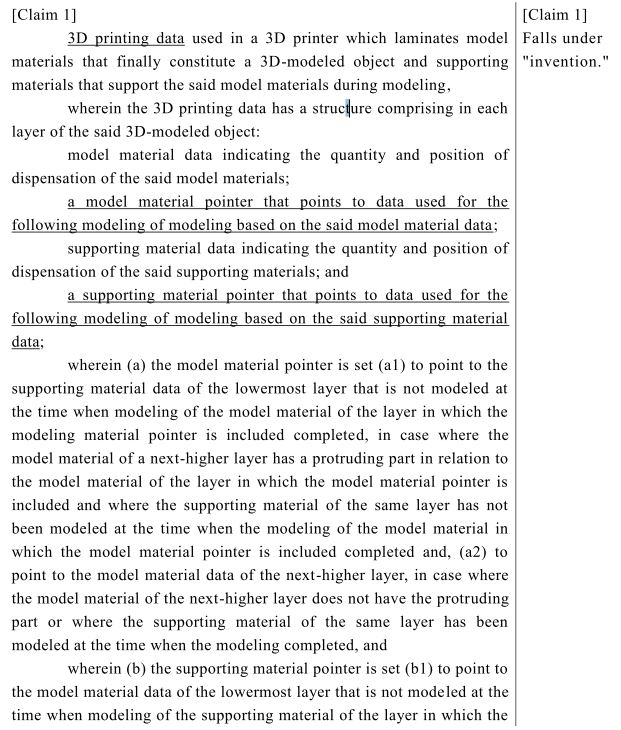
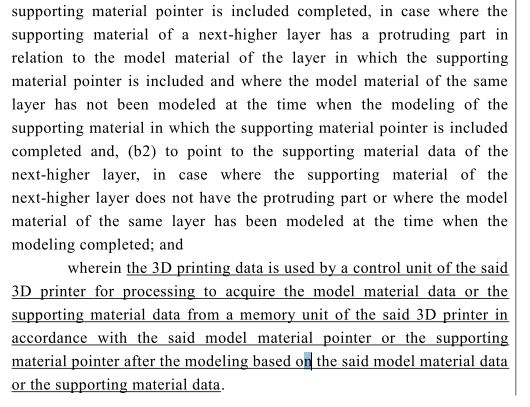
Drawing
[Fig. 1]

[Fig. 2]
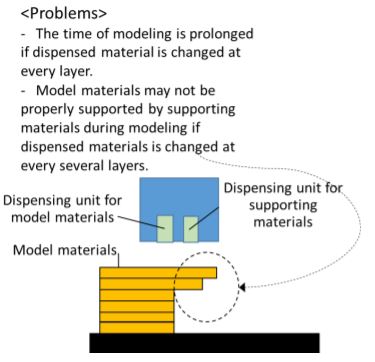
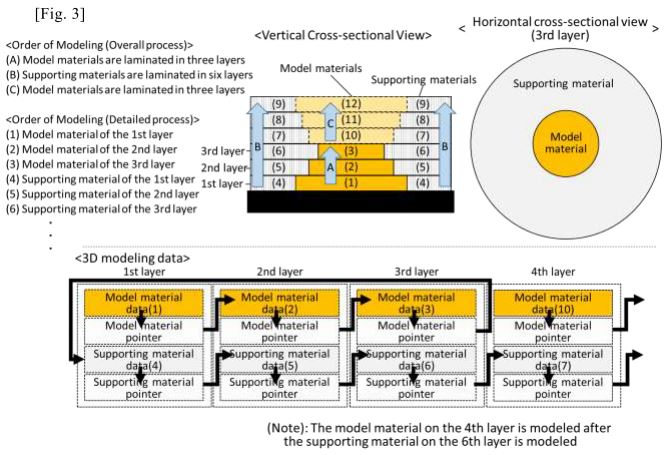
Overview of the description
[Technical Field]
The present invention relates to 3D printing data.
[Background Art]
A 3D printer models a 3D-modeled object by calculating data indicating a thinly-cut cross-sectional shape in the laminated direction and a position of dispensation corresponding to the cross-sectional shape based on the data on a three-dimensional shape of the 3D-modeled object, modeling each layer using model material in accordance with the data and laminating each of the layers on modeling stages.
A 3D printer (see fig. 1) is known that laminates model materials which finally constitute the 3D-modeled object and supporting materials that supports the said model materials. In case where an object to be modeled has a protruding part in relation to a lower-layer structure, the supporting materials are placed on the outer or inner circumference of the model materials to support the said protruding part of the model materials until the modeling of 3D-modeled object completes and then removed once the modeling of 3D-modeled object completes.
Such a 3D printer is comprised of a dispensing unit that dispenses model materials and a dispensing unit that dispenses supporting materials separately. After an object is modeled by dispensing model materials (or supporting materials), one layer is modeled, through changing material to be dispensed, by dispensing supporting materials (or model materials).
[Problems to be solved by the invention]
In cases where dispensed material is changed at every layer as described earlier, the time of modeling is prolonged. To solve this problem, dispensed materials may be changed at every several layers.
In this case, the time of modeling is expected to be reduced due to the reduction in the number of changes, but supporting materials may not support model materials properly during modeling depending on a layout of model materials and supporting materials and the order of their modeling (see fig. 2).
The present invention has been conceived in view of those problems and aims to provide 3D printing data capable of reducing the time of modeling while appropriately laminating model material and supporting material.
[Solution for the Problem to be solved]
The 3D printing data of the present invention is used, for example, in an ink-jet 3D printer that laminates model materials that finally constitute a 3D-modeled object and supporting materials that support the said model materials during modeling.
A 3D printer is equipped with a control unit that sequentially acquires model material data or supporting material data used for modeling among the 3D printing data from a memory unit in accordance with a pointer and that makes a dispensing unit to dispense materials. The 3D printer itself may be equipped with the memory unit or an external server connected to the 3D printer via a network may be equipped therewith.
The 3D printing data includes, together with model material data and supporting material data of each layer, a pointer that points to data used for a modeling following a modeling based on the model material data or the supporting material data. The model material data and the supporting material data indicate materials (model materials or supporting materials) dispensed from the dispensing unit of the 3D printer and the position and quantity of dispensation.
Now the pointer is explained. (a) The model material pointer is set (a1) to point to the supporting material data of the lowermost layer that is not modeled at the time when modeling of the model material of the layer in which the modeling material pointer is included completed, in case where the model material of a next-higher layer has a protruding part in relation to the model material of the layer in which the model material pointer is included and where the supporting material of the same layer has not been modeled at the time when the modeling of the model material in which the model material pointer is included completed and, (a2) to point to the model material data of the next-higher layer, in case where the model material of the next-higher layer does not have the protruding part or where the supporting material of the same layer has been modeled at the time when the modeling completed. (b) The supporting material pointer is set (b1) to point to the model material data of the lowermost layer that is not modeled at the time when modeling of the supporting material of the layer in which the supporting material pointer is included completed, in case where the supporting material of a next-higher layer has a protruding part in relation to the model material of the layer in which the supporting material pointer is included and where the model material of the same layer has not been modeled at the time when the modeling of the supporting material in which the supporting material pointer is included completed and, (b2) to point to the supporting material data of the next-higher layer, in case where the supporting material of the next-higher layer does not have the protruding part or where the model material of the same layer has been modeled at the time when the modeling completed. It should be noted that, when a dispensing unit comes close to the 3D-modeled object or the modeling stage to dispense materials, the dispensing unit may collide with any of modeled layers. Therefore, materials to be dispensed may be changed after the predetermined number of layers are laminated, even in cases where a model material or supporting material does not have a protruding part in relation to a lower layer, and a pointer may be set to realize such a change. Moreover, a model material pointer (or a supporting material pointer) of the uppermost layer is, in cases where the modeling of all the supporting materials (or model materials) has not yet completed, set to point to supporting material data (or model data) of the bottommost layer, and, in cases where the modeling of all the supporting layers (or model layers) have already completed, set to indicate the completion of modeling of all the layers.
The case where an hour-glass shaped 3D-modeled object having six layers shown in fig. 3 is modeled using the pointer set in the above manner is explained hereafter (It should be noted that it is rare that the lamination completes in six layers in actual 3D printing and hundreds or thousands of layers are usually laminated. The example gives an explanation supposing that the 3D-modeled object is composed of six layers in order to explain an idea of the present invention). When such a 3D-modeled object is modeled, it is required to place supporting materials on the outer circumference of model materials. However, as model materials of the fourth to the sixth layers have protruding parts from model materials of layers directly thereunder and supporting materials of the first to the third layers have protruding parts on layers directly thereunder, it is appropriate to laminate three layers of model materials, six layers of supporting materials and then the remaining three layers of model materials.
In this case, as for pointers in the 3D printing data, model material data of the second layer is pointed after the modeling based on model material data of the first layer, model material data of the third layer is pointed after the modeling based on model material data of the second layer, and supporting material data of the first layer is pointed after the modeling based on model material data of the third layer (the same process is repeated for subsequent layers). Since data to be pointed by the pointer can be changed by simple data editing, the 3D printing data having such a structure with pointers can simply set the order of modeling, that is, the order of acquiring data, after calculating data indicating a thinly-cut cross-sectional shape in a laminated direction and the quantity and position of dispensation of each material corresponding to the cross-sectional shape based on data on three-dimensional shape of the 3D-modeled object.
Since a control unit of the 3D printer sequentially acquires from the memory unit the model material data or the supporting material data used for modeling among 3D printing data, such 3D printing data having a structure with pointers is preferable in cases where the size thereof is larger than the RAM capacity of the control unit of the 3D printer or the memory unit (and a conversion unit that converts data on 3D shapes of the 3D-modeled object into 3D printing data taking into account cross-sectional shapes and stores it in the said memory unit) is accommodated in an external server connected to the 3D printer via a network.
[Effect of Invention]
The present invention is capable of reducing the time required for modeling since materials to be dispensed are changed at every several layers as well as properly laminating model materials and supporting materials.
[Conclusion]
The inventions of claim 1 falls under "invention."
[Explanation]
- Claim 1
It is determined that the 3D printing data of Claim 1 is, from its statement that "comprising in each layer of the said 3D-modeled object:" "a model material pointer that points to data used for the following modeling of modeling based on the said model material data" and "a supporting material pointer that points to data used for the following modeling of modeling based on the said supporting material data," and "the 3D printing data is used by a control unit of the said 3D printer for processing to acquire the model material data or the supporting material data from a memory unit of the said 3D printer in accordance with the said model material pointer or the supporting material pointer after the modeling based on the said model material data or the supporting material data," data having a structure enabling the information processing by the control unit, of acquiring data used for the following modeling from the memory unit after the modeling is performed based on the model material data or the supporting material data. Thus, this 3D printing data is structured data (computer software) equivalent to the computer program, because it has similar properties to the computer program in that it prescribes information processing by the control unit based on its own structure.
The method of concretely controlling an apparatus which is a 3D printer, or performing processing along with the control is a "creation of the technical idea utilizing the laws of nature."
The invention of Claim 1, which is the computer software for causing the control unit to carry out the above method, thus falls under "invention."
(Reference)
For 3D printing data that does not fall under "invention," see Case 3-3 in "Annex A, 3. Eligibility of Invention and Industrial Applicability."
3.3 Case for Determination of Inventive Step
[Case 3-1] Apparatus for Searching Chemical Material
(Technique easily applicable to other specific field)
Title of the invention
Apparatus for searching chemical material
What is claimed is:
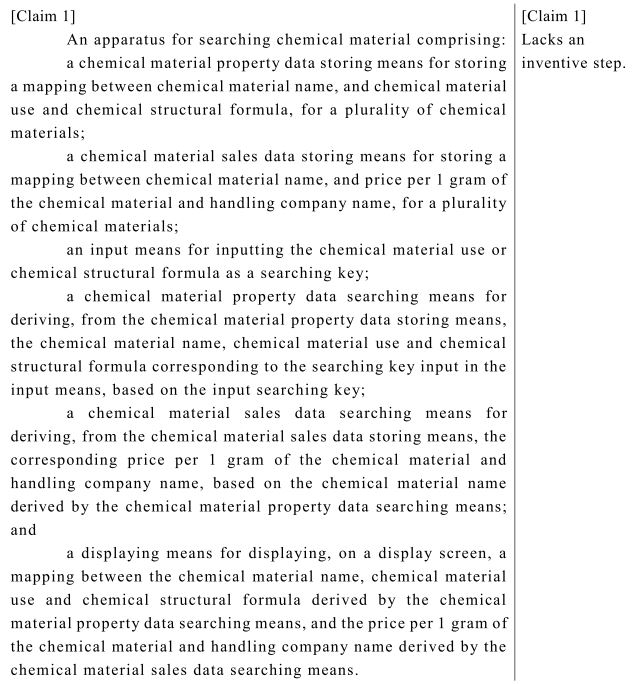

Description
[Technical Field]
The present invention relates to a system for searching and ordering chemical materials used in a chemical factory, pharmacy and the like.
[Background]
A searching technique has been applicable to a variety of applications. It has been well-known that, in a searching technique for chemical materials, chemical material name, chemical structural formula, chemical material use and the like are mapped as an item, and one item is searched as a searching key to retrieve other information.
However, since an existing chemical material searching apparatus does not store a mapping of commercial transaction information such as price and handling company without the direct relevancy to chemical material property, such information is required to be obtained from another apparatus.
[Problem to be solved]
The problem to be solved is to provide an apparatus for searching chemical material contributing to convenience in ordering desired chemical materials, by searching chemical materials based on chemical material use and chemical structural formula, and allowing to retrieve commercial transaction information such as price and handling company.
Moreover, the apparatus further contributes to convenience for ordering etc. by including "cleaning agent for circuit substrate" in data to be searched, as use for chemical material B newly found by the applicant.
[Means of Solving Problem]
The apparatus for searching chemical material of the present invention has the configuration that comprises a storing means for storing a mapping between chemical material name, and chemical material use and chemical structural formula, and a storing means, as a separate storing means, for storing a mapping between chemical material name, and price and handling company, and in which the price and handling company are searched with the chemical material name after searching the chemical material name based on the chemical material use and chemical structural formula. It takes into consideration easiness for data migration from an existing chemical material searching apparatus and for data maintenance
[Effect of Invention]
The present invention provides an apparatus for searching chemical material contributing to convenience in ordering desired chemical materials, by searching chemical materials based on chemical material use and chemical structural formula, and allowing retrieval of commercial transaction information such as price and handling company.
Moreover, the apparatus for searching chemical material of the present application stores the "cleaning agent for circuit substrate" as chemical material property data, as use for chemical material B newly found by the applicant. Thus, it is expected that the chemical material B is purchased as "cleaning agent for circuit substrate" and sales of chemical material B is increased.
[Brief description of the drawings]
(Omitted)
[Description of the embodiments]
The present invention implements the apparatus for searching chemical material using a computer comprising a central processing unit, storing means, inputting means such as a keyboard, and displaying means such as a display. A conceptual diagram is illustrated in FIG. 1.
Operation flows of this apparatus for searching chemical material are as follows.
Firstly, the storing means of the computer stores chemical material propert y data including a mapping between chemical material name, and chemical material use and chemical structural formula, as well as chemical material sales data including a mapping between chemical material name, and price per 1 gram of the chemical material and handling company name. This storing means may be implemented by employing a semiconductor storing means such as RAM or ROM, and a storage medium such as magnetic disc or CD-ROM.
Then, when the chemical structural formula or chemical material element is input through the inputting means, the central processing unit of the computer searches the chemical material property data stored in the storing means of computer by using this input as a searching key, and derives data including the searching key.
Moreover, the central processing unit of computer searches the chemical material sales data stored in the storing means of computer by using, as a searching key, the chemical material name included in the derived chemical material property data, derives data including the searching key, and displays, on the displaying means, the chemical material name, chemical material use, chemical structural formula, price per 1 gram and handling company name derived as a result of search.
Drawings

(1) Condition for Determining Inventive Step
(i) Problem to be solved
- Providing an apparatus for searching chemical material contributing to convenience in ordering desired chemical materials, by searching chemical materials based on chemical material use and chemical structural formula, and allowing retrieval of commercial transaction information such as price and handling company.
- Contributing to convenience for ordering etc. by including "cleaning agent for circuit substrate" in data to be searched, as use for chemical material B newly found by the applicant
(ii) Person Skilled in the Art
A person skilled in the art has knowledge of searching technique of chemical materials and knowledge of computer technology for the invention in this case.
(2) State of the Art (prior arts, well-known art etc.)
(I) Prior arts
The following inventions were well-known prior to the filing of the application.
Document 1 (D1) discloses:
An apparatus for searching chemical material comprising a chemical material storing means for storing a mapping between chemical material name, and chemical material use and chemical structural formula, a searching means for searching chemical materials with the chemical material use or chemical structural formula, and a displaying means for displaying a search result.
Document 2 (D2) discloses:
An apparatus for searching book comprising:
a book information storing means for storing a mapping between book name, and genre and keyword of the book, for a plurality of books;
a book sales data storing means for storing a mapping between book name, and price and publisher name, for a plurality of books;
an inputting means for inputting the genre or keyword of the book as a searching key;
a book information searching means for deriving, from the book information storing means, the book name, genre and keyword of the book corresponding to the searching key input by the inputting means, based on the input searching key;
a book sales data searching means for deriving, from the book sales data storing means, the price and publisher name of the corresponding book, based on the book name derived by the book information searching means; and
a displaying means for displaying, on a display screen, a mapping between the book name, the genre and keyword of the book derived by the book information searching means, and the price and publisher name of the book derived by the book sales data searching means.
(II) Well-known art etc.
- Chemical material B represented in chemical structural formula A was well-known prior to the filing of application.
- The chemical material B has not been well-known or publicly known used as a "cleaning agent for circuit substrate" or easily predictable to a person skilled in the art for chemical materials.
(3) Specific determination
(i) Claim 1
Comparing the subject matter of Claim 1 with the prior art disclosed in D1,
Difference 1: The subject matter of Claim 1 comprises the "chemical material sales data searching means for deriving price per 1 gram of the corresponding chemical material and handling company name from the chemical material sales data storing means, based on the chemical material name derived by the chemical material property data searching means." In contrast, the prior art disclosed in D1 does not comprise the means for searching based on the chemical material name derived by the searching means.
Difference 2: The subject matter of Claim 1 comprises the "displaying means for displaying, on a display screen, a mapping between the chemical material name, chemical material use and chemical structural formula derived by the chemical material property data searching means, and the price per 1 gram of the chemical material and handling company name derived by the chemical material sales data searching means," and also displays the price per 1 gram of the chemical material and handling company name as commercial transaction information. In contrast, the prior art disclosed in D1 does not display the commercial transaction information. The other technical elements have commonalities between the subject matter of Claim 1 and the prior art disclosed in D1.
Difference 1: Review for obviousness of configuring "chemical material sales data searching means"
It is recognized that the prior art disclosed in D2, using, as a searching key, name (book name) of searching object derived by the first storing means, searches for the second storing means, and derives the commercial transaction information (price and publisher name of the book) corresponding to the information, from the standpoint of computer technology.
The prior arts disclosed in D1 and D2 belong to the technical field of searching apparatus, and have the common functionalities of searching information corresponding to the input searching key and displaying searching result. Thus, there are no specific technical difficulties for applying the configuration of the searching apparatus of the prior art disclosed in D2 to the apparatus for searching chemical material of that disclosed in D1.
In this regard, a person skilled in the art should determine how the derived commercial transaction information is used as appropriate, depending on the searching object field. Thus, it is merely an exhibition of normal creation capabilities of a person skilled in the art that when the searching apparatus of the prior art disclosed in D2 is applied to the apparatus for searching chemical material, the "price per 1 gram of the chemical material" and "handling company name" are employed as commercial transaction information in the chemical material field.
Therefore, it has been easily conceivable for a person skilled in the art to apply the configuration of the searching apparatus of the prior art disclosed in D2 to the apparatus for searching chemical material of that disclosed in D1, and provide the means for deriving, from the chemical material sales data storing means, the "price per 1 gram of the chemical material and handling company name" as commercial transaction information, based on the chemical material name of the searching object name.
Difference 2: Review for obviousness of configuring "displaying means for displaying price per 1 gram of chemical material and handling company name as commercial transaction information"
It has been inevitably perceivable to a person skilled in the art to display the information derived as a result of searching in light of the technical properties of "searching" performed for obtaining information. Also, there is no specific technical difficulties for displaying the above commercial transaction information. Thus, it has been easily conceivable for a person skilled in the art to also display also the commercial transaction information derived as a result of searching.
(Consideration of Advantageous Effect)
The effect of retrieving the "commercial transaction information" obtained by the subject matter of Claim 1 also has been easily predictable to a person skilled in the art from the prior arts disclosed in D1 and D2.
(Conclusion)
Therefore, the subject matter of Claim 1 is obvious for a person skilled in the art from the prior arts disclosed in D1 and D2.
[Explanation]
(Considered Circumstances for Motivation)
(1) Relevancies for Technical Fields
The prior arts disclosed in D1 and D2 both belong to the technical field of searching apparatus.
(2) Commonalities in Functions
The prior arts disclosed in D1 and D2 have the commonalities in the functionalities of searching information corresponding to input searching key and displaying searching result.
(ii) Claim 2
Comparing the subject matter of claim 2 with the prior art disclosed in D1, in addition to the above differences 1 and 2, the subject matter of claim 2 "stores 'cleaning agent for circuit substrate' as use for chemical material B represented in chemical structural formula A in the chemical material property data storing means." In contrast, the prior art disclosed in D1 does not have such a feature. There is difference in terms of the above, and other technical elements have commonalities between the subject matter of claim 1 and the prior art disclosed in D2.
However, "storing 'cleaning agent for circuit substrate' as use for chemical material B represented in chemical structural formula A in the chemical material property data storing means" merely represents data content. Thus, presence of inventive step should not be presumed affirmatively for the subject matter of claim 2 in terms of that.
(Conclusion)
The subject matter of claim 2 is obvious for a person skilled in the art from the prior arts disclosed in D1 and D2.
[Case 3-2] Slip Approval System
(Technique easily capable of systematizing human works (business field))
Title of the invention
Slip approval system
What is claimed is:
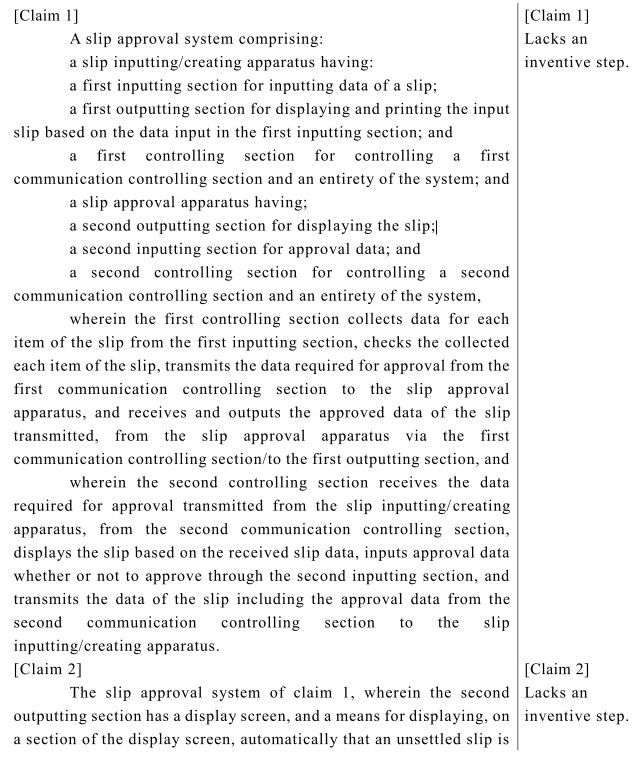

Description
[Technical Field]
The present invention relates to a slip creating works used in a window of a bank etc.
[Background]
Conventionally, in creating a slip used in a window of a bank etc., the slip for a large amount transaction has been created after a superior approves the transaction.
[Problem to be solved]
In order to obtain approval, it is required to leave the seat and to deliver the slip to the superior, and meanwhile the office work cannot be conducted. Especially, it takes more time in the case that the superior is far away.
The present invention provides a system using a computer for obtaining approval without visiting the superior.
Also, since the system displays, on the display screen, that the slip to be settled is received, the receipt of the slip can be recognized without a certain operation.
Further, since the approval data is input using an ID (individual identification) card, the configuration is enabled in which only the approver can input the approval data.
[Means of Solving Problem]
(Omitted)
[Effect of Invention]
The system provides a remarkable effect that the slip can be processed effectively to obtain approval for slip without ceasing the work, compared to the prior art.
[Brief description of the drawings]
(Omitted)
[Description of the embodiments]
(Omitted)
[Embodiments]
(Omitted)
Drawings
[FIG. 1] Configuration diagram of slip approval system
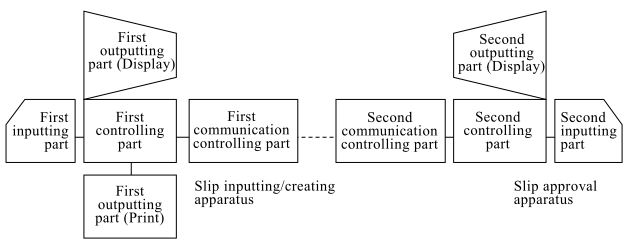
(1) Condition for Determining Inventive Step
(i) Problem to be solved
Systematizing office work using computer technology is a well-known normal problem to be solved. Since a slip approval process is also included in the office work, systematizing it is a fairly normal problem to be solved.
(ii) Person Skilled in the Art
A person skilled in the art for this case has knowledge for office work of a slip and knowledge for computer technology.
(iii) Systematization of Human Work (Office Work of Slip)
It is determined whether or not to involve inventive step in systematizing human work taking into consideration the process for developing a system (system analysis → system design).
Systematizing human work in a normal system developing scheme using a well-known computer technology falls under an exhibition of normal creation capabilities of a person skilled in the art.
It is determined, also in this case, whether or not to involve inventive step from the viewpoint that processes for office work of slip are analyzed for system and the system is designed based on the result.
(2) State of the Art (prior arts, well-known arts etc.)
(I) Processes for Normal Office Work
(i) Processes Performed by Slip Creator
(a) Writing data for creating slip and creating slip.
(b) Passing slip required for approval to approver to obtain approval.
(c) Receiving slip from approver and completing creation of slip.
(ii) Processes Performed by Approver
(a) Receiving slip from slip creator.
(b) Checking slip received from slip creator and giving approval.
(c) Passing approved slip to creator.
(II) Computer Technology
(i) Common general knowledge of computer technologies
(a) A computer having an inputting section and an outputting section is disposed for each person, the computer is connected to a communication line through a communication controlling section, and required data is transmitted and received.
(b) Data is edited with the computer, and displayed or printed in a format of required document.
(c) If receiving data, data reception is displayed on the screen.
(d) Own ID code is input using an ID (individual identification) card, and processing is performed.
(ii) Techniques Disclosed in Distributed Publication Prior to Filing of Application
(e) Input data is checked and only data required for transmission is transmitted.
(3) Specific Determination
It is determined whether to involve inventive step in terms of whether it is obvious for a person skilled in the art to systematize slip creating processes using computer technology based on the functions required for creating a slip and approving a slip in the slip approving processes, which is derived through system analysis.
(i) Claim 1
(a) It is apparent to require the inputting section and outputting section of data for creating a slip, and the communicating means for delivering slip data required for approval to the superior through analysis for the above slip creating processes.
The same is applicable to the case of approving a slip.
Therefore, from the above computer technology (a),
it would be easily conceived by a person skilled in the art using ordinary system design technology to select hardware resources for the system configuration, i.e.,
"A slip approval system comprising: a slip inputting/creating apparatus having: a first inputting section for inputting data of a slip; a first outputting section for displaying and printing the input slip based on the data input in the first inputting section; and a first controlling section for controlling a first communication controlling section and the entirety of the system; and
a slip approval apparatus having; a second outputting section for displaying the slip; a second inputting section for approval data; and a second controlling section for controlling a second communication controlling section and the entirety of the system."
(b) Functions executed in each controlling section,
"collecting data for each item of a slip from the first inputting section, checking each of the collected items of the slip, transmitting data required for approval from the first communication controlling section to the slip approval apparatus, and receiving and outputting the approved data of the slip transmitted from the slip approval apparatus via the first communication controlling section/to the first outputting section" and
"receiving the data required for approval transmitted from the slip inputting/creating apparatus, from the second communication controlling section, displaying the slip based on the received slip data, inputting approval data whether or not to approve through the second inputting section, and transmitting the data of the slip including the approval data from the second communication controlling section to the slip inputting/creating apparatus," are realized by software, but can be directly derivable by a person skilled in the art by applying said computer technologies (a), (b) and (e) to slip office work procedure.
From the above review (I) and (II), it is easily conceivable for a person skilled in the art to configure the slip approval system of claim 1 by applying the computer technologies (a), (b) and (e) to the system analysis results.
(ii) Claims 2 and 3
As stated in the common general technical knowledge (c) and (d) for the computer field, the processes in which if receiving data, data reception is displayed on the screen and own ID code is input using an ID (individual identification) card, and processing is performed" are commonly used means for systematization. Thus, it is conceivable for a person skilled in the art as appropriate to provide a means for displaying automatically that an unsettled slip is received and to attach the ID card reading apparatus to the inputting section.
The applicant stated in the specification that the present invention provides remarkable effects. However, it is recognized that the effects stated in the specification are merely natural effects (improvement in efficiency) obtained by using a computer. Thus, thus there is no other fact supporting affirmative inference of inventive step.
From the above, the subject matter of Claims 1-3 is obvious for a person skilled in the art based the well-known matters (I) and (II).
[Case 3-3] Method for offering loyalty program
(Technique easily capable of systematizing human works and modifying design based on well-known fact and practice (business field))
Title of the invention
Method for offering loyalty program
What is claimed is:
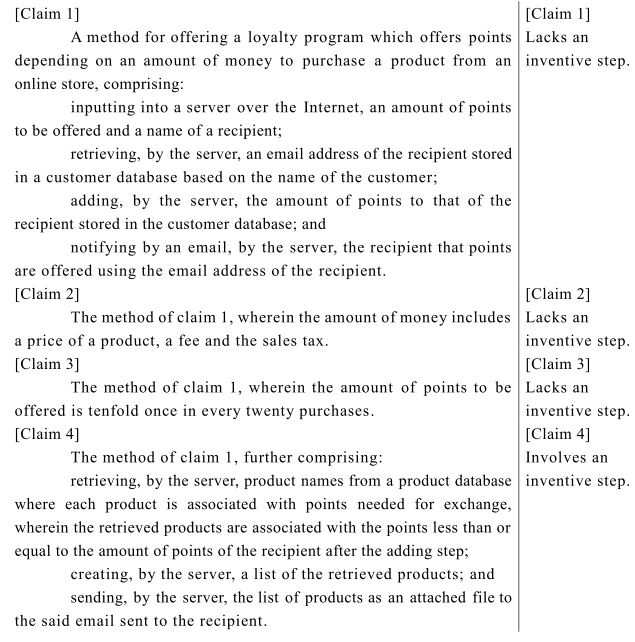
Description
[Technical Field]
The present invention relates to a method for offering a loyalty program at an online store. [Background]
Conventionally, such a program offering points depending on the amount of money to purchase products (e.g. at a constant ratio), under which customers may exchange points offered for a product, coupon, money and the like depending on the amount of their points, has been common.
[Technical Problem]
A conventional method has not been implemented on Internet transactions, due to the problem of customer management, etc. Also, points may be used only by the customers themselves, and the points cannot be transferred to even a family member due to similar problems.
[Solution to Problem]
The present invention implements a loyalty program at an online store, a server of which comprises a database that stores a list of customers (including at least a name, accumulated points, and an email address of each customer) to manage the points for each customer, and to accumulate the points in response to the purchase of products from the store.
Moreover, when a customer intends to give points to another customer, the donor needs to notify the server of the name of the recipient and points to be given by an email. Then, the server retrieves the current amount and points and the email address of the recipient from a customer list database based on the name, accumulates the points given, and automatically notifies the recipient to that effect.
The following variants are applicable to the present invention.
Firstly, the points may be calculated from the amount of money including a fee and the sales tax, as well as a price of a product as recited in claim 2.
Secondly, the amount of points to be offered may be tenfold once in every constant number of purchases (e.g. once in every twenty purchases) to increase repeat customers as recited in claim 3. In this case, a new column should be created in the database in order to count the number of purchases.
Thirdly, the server may further comprise a product database storing a name of a product and points needed for exchange associated with a product, as recited in claim 4. When the accumulated points increase, the server may automatically retrieve exchangeable products from the product database based on the accumulated points, and create a list of products and send the list to the recipient by email, which ensures the program to be further satisfactory. Specifically, the product database is configured to store the name of products and exchange points associated with each product, as in FIG. 4. When the accumulated points increase for a certain customer, the server automatically retrieves names of products, the amount of points for exchange associated with which is less than or equal to the accumulated points from the product database, and creates a list of product in a certain format. The list is sent as an attached file by an email. Because of addition of such functions to the server, also in cases where the points are given to other customers, the amount of points increases for the recipient and then the list is sent to the recipients.
[Advantageous Effects of Invention]
This method makes it easier to implement the loyalty program for customers of online stores. Since points may be given to another customer, the availability of use of points is expanded. Furthermore, to offer tenfold points once in every twenty purchases may raise purchasing motivation of customers, and also enhance the customers’ enjoyment of shopping at the online store.
[Brief Description of Drawings]
(Omitted)
[Description of Embodiments]
(Omitted)
[Examples]
(Omitted)
Drawings
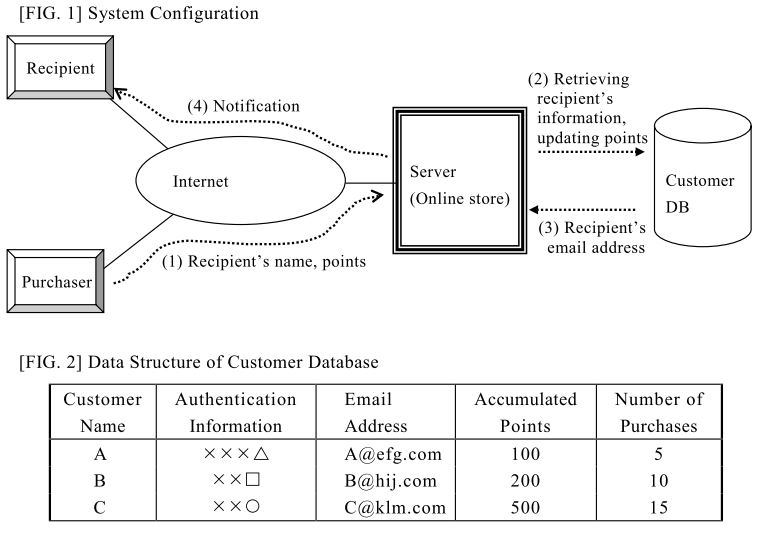
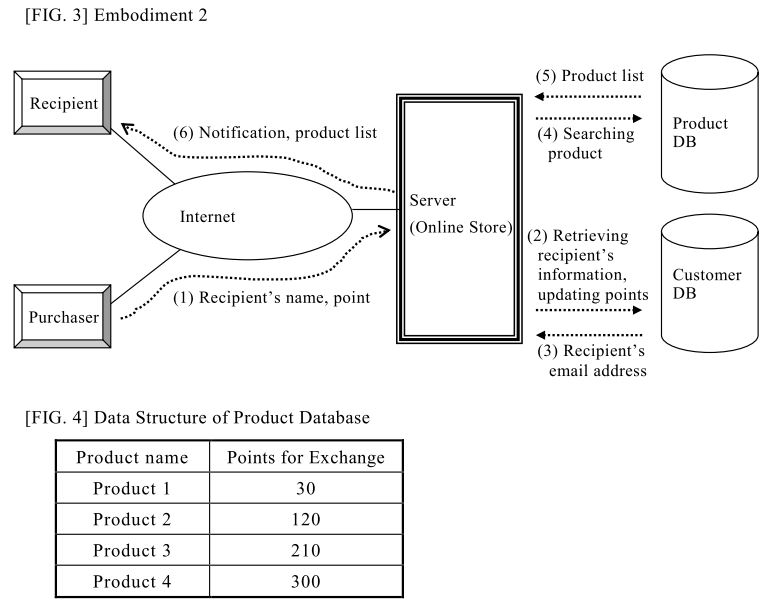
(1) Conditions
(i) Problems to be solved
Implementation of commercial transactions using a computer technology (especially, technologies related to the Internet) is a well-known, common problem to be solved. Also, a loyalty program is a service offered as a business practice.
Thus, implementation of such a program is also a fairly common problem.
(ii) Person skilled in the art
A person skilled in the art for this case has knowledge of business practices (especially, loyalty programs) and that of computer technologies.
(iii) Systematization of operation performed by humans (commercial transactions)
It should be determined whether or not the subject matter involves an inventive step from a viewpoint of system implementation which first analyzes the operations, especially, a loyalty program, and then designs a preferable system based on the result of analysis.
(2) State of the art (prior arts, well-known art etc.)
(I) Prior arts
The following prior arts had been made available to the public prior to filing of the application.
Document 1 (D1) discloses:
a method for offering a loyalty program that offers points depending on an amount of money to purchase a product at a (physical) store comprising:
retrieving in response to the indication of an amount of points to be offered and a recipient’s name, the recipient’s address recorded in a customer list based on the recipient’s name;
adding the amount of points to the points of the recipient recorded in the customer list; and
sending a postcard to the recipient’s address for notifying that points are offered.
Document 2 (D2) discloses:
a method for calculating points to be offered based on the amount of money to purchase, including taxes and fees.
However, it is not disclosed in this document that the amount of points is tenfold once in every twenty purchases.
(II) Business practices
Offering a special service to frequent shoppers, for example, offering free gifts or discounts, occasionally.
(III) Computer technologies
(i) Common general knowledge of generic computers
(a) Information may be managed collectively in a database and necessary information may be retrieved from the database.
(ii) Technical knowledge of the Internet
(b) Communication may be performed between terminals (including servers) over a network.
(c) Parties may communicate with each other using emails. Also, necessary information may be sent as an attached file to an email.
(3) Detailed determination on each claim
(i) Subject matter of Claim 1
Compared with the prior art disclosed in D1, identical features and differences are as follows.
(Identical features)
A method for offering points depending on an amount of money to purchase a product at a store comprising: retrieving, in response to the indication of an amount of points to be offered and a recipient’s name, information related to the recipient from a customer list based on the recipient’s name; adding the amount of points to the accumulated points of the recipient recorded in the customer list; and notifying the recipient of the fact that points are offered.
(Differences)
The subject matter of Claim 1 systematizes a method for offering the loyalty program using a server, emails and a customer database. Further, in the subject matter of Claim 1, the store is on the Internet.
(Determination on the differences)
A person skilled in the art would easily conceive of the use of:
a database to store and manage the customer list, by applying the common general knowledge (a);
a terminal installed in the store, i.e., a server, which automatically processes transactions which have been performed by humans and communicates with terminals of customers, by applying the technical knowledge (b); and
emails, instead of postcards, to notify the customers, by applying the technical knowledge (c), to the method of offering the loyalty program disclosed in D1 in order to systematize the method on the Internet.
(Conclusion)
The subject matter of claim 1 merely systematizes operations which have been operated by humans, as disclosed in D1, through ordinary system development methods using the state-of-the-art for computer technologies. Thus, the subject matter of Claim 1 would be easily arrived at by a person skilled in the art, and lacks an inventive step.
(ii) Subject matter of Claim 2
Compared with the prior art disclosed in D1, identical features and differences as follows.
(Identical features)
Same as for Claim 1.
(Differences)
2-1. Same as the difference for Claim 1.
2-2. The subject matter of claim 2 implements the method for offering the loyalty program under which the amount of points to be offered is determined based on the amount of money to purchase including the sales tax and fees.
(Determination on the differences)
a. Difference 2-1
Same as the determination of Claim 1.
b. Difference 2-2
It is publicly known that the amount of points to be offered may be calculated based on the amount of money to purchase including the sales tax and fees, as disclosed in D2.
Moreover, both of the prior arts disclosed in D1 and D2 relate to the technical field of commerce, especially, loyalty programs, and have the similar function that offers points depending on the amount of money to purchase a product.
Thus, there is motivation for a person skilled in the art to drive the claimed element, Difference 2, by applying the method for calculating the amount of points disclosed in D2 to the prior art disclosed in D1.
(Conclusion)
The subject matter of Claim 2 merely systematizes the operation disclosed in D1, and adopts the method for calculating points disclosed in D2. Thus, the subject matter of Claim 2 would be easily arrived at by a person skilled in the art, and lacks an inventive step.
[Remarks]
(Factors taken into consideration)
(1) Relation of technical fields
Both of the prior arts disclosed in D1 and D2 relate to the technical field of commerce, especially, loyalty programs.
(2) Similarity of operations or functions
Both of them have the similar function that offers points depending on the amount of money to purchase.
(iii) Claim 3
Compared with the prior art disclosed in D1, identical features and differences as follows.
(Identical features)
Same as for Claim 1.
(Differences)
3-1. Same as the difference for Claim 1.
3-2. The subject matter of Claim 3 offers a loyalty program under which the amount of the points to be offered is tenfold once in every twenty purchases.
(Determination on the differences)
a. Difference 3-1
Same as for Claim 1.
b. Difference 3-2
Offering a special service to frequent shoppers is ordinary performed as a business practice (II). Thus, a person skilled in the art would easily conceive of offering additional points to frequent shoppers. Here, how frequently or at what rate such additional points are offered should be left to the discretion of a person skilled in the art. Therefore, offering tenfold points once in every twenty purchases is regarded to be a design variation chosen by a person skilled in the art.
(Conclusion)
The subject matter of Claim 3 merely systematizes the operations performed by humans as disclosed in D1, and offers the special service which is regarded as a design variation chosen by a person skilled in the art. Thus, the subject matter of Claim 3 would be easily arrived at by a person skilled in the art, and does not involve an inventive step.
(iv) Claim 4
The subject matter of Claim 4 further comprises retrieving product names associated with the amount of points needed for exchange, which is less than or equal to the accumulated points of a customer from a product database where the product names are associated with the amount of points for exchange, creating a product list, and sending the list as an attached file to an email to the customer. These elements would not be derived from the state-of-the-art. Thus, the subject matter of Claim 4 would not be arrived at by a person skilled in the art, and involves an inventive step.
[Case 3-4] Tree-Structured Area Management Data
Related to a Data Structure with Inventive Step (Information processing field) (IoT rerated technology)
Title of the invention
Tree-Structured Area Management Data
What is claimed is:
[Claim 1]
Tree-structured area management data comprising in the order of single-layer root node, multi-layer intermediate nodes and single-layer leaf nodes from the top, wherein;
the said leaf nodes have location information on distribution areas and contents data associated with a plurality of angles;
among the said intermediate nodes, those equipped with the said plurality of leaf nodes underneath have pointers to the said plurality of leaf nodes underneath and location information of the minimum bounding rectangle that bounds the said plurality of distribution areas corresponding to the plurality of leaf nodes underneath with the minimum area;
among the said intermediate nodes, those equipped with a plurality of intermediate nodes underneath have pointers to the said plurality of intermediate nodes underneath and location information of the minimum bounding rectangle that bounds the said minimum bounding rectangle owned by the plurality of intermediate nodes underneath with the minimum area;
the said root node has pointers to the said plurality of intermediate nodes underneath;
wherein the tree-structured area management data is stored in a contents distribution server; and
it is used by the said contents distribution server
to perform processing to identify leaf nodes corresponding to distribution areas that geographically contain information on current position input as a search key in accordance with the pointers owned by a root node or intermediate nodes, and
to identify contents data associated with an angle closest to angle information input as a search key among contents data owned by the said identified leaf nodes.
Drawing
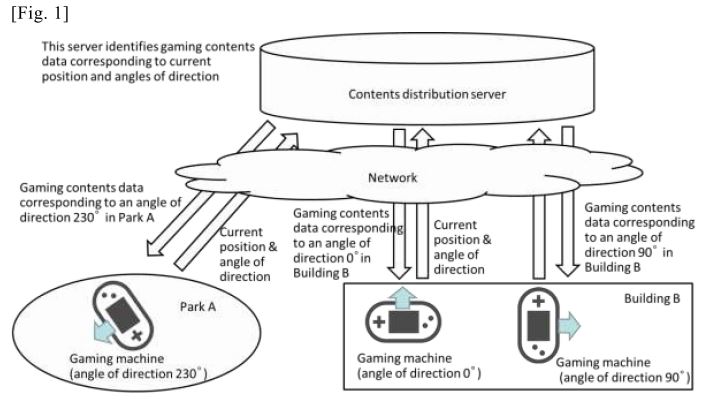


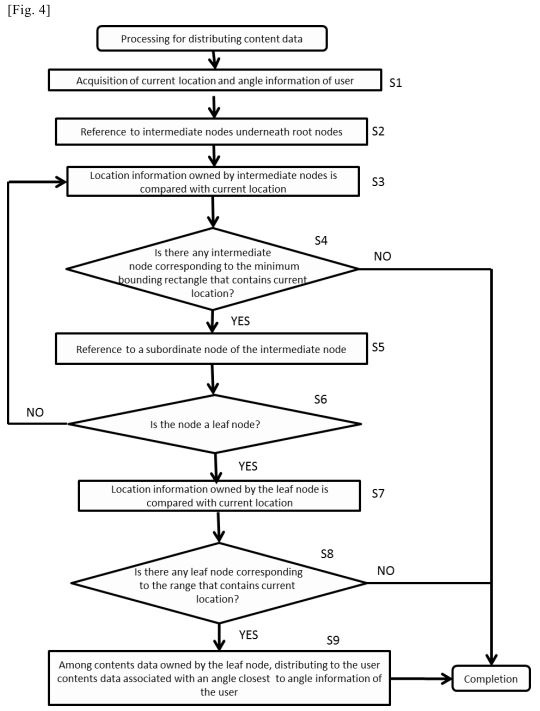
Overview of the description
[Technical Field]
The present invention relates to a data structure for a technology to distribute contents data to users.
[Background Art]
There is a service for users who own gaming machines that run on specific gaming applications within specific distribution areas on a map to distribute contents data on the game related to the distribution areas to their gaming machines. In this service, if a user is found to be in a specific distribution area while he/she is in transit, one contents data related to the distribution area is automatically distributed to his/her gaming machine. Moreover, it is envisaged that the user physically moves to a specific distribution area where he/she may receive contents data in order to acquire desired data. Furthermore, a method is known in which an enormous number of distribution areas for this service is managed by a tree-structure so that the present invention is designed in a way that processing for identifying distribution areas that geographically contain information on current positions of users is carried out only by comparing the number of stages of the tree structure.
[Problems to be solved by the invention]
In order to further increase a game element of those applications, there is a method of distributing different contents data in accordance with angles to which users are facing even when they are in the same distribution area.
[Solution for the Problem to be solved]
The present invention is characterized in that it associates a plurality of contents data by angles with one distribution area and holds such data. The present invention acquires from a gaming machine of a user, in addition to information on current location, angle information indicating a direction to which the gaming machine is facing as a search key. By this way, when the user (gaming machine) is determined to be in a specific distribution area, contents data on the basis of the angle information of the gaming machine is distributed.
[Description of the embodiments]
As shown in the outline drawing of the present invention in Fig. 1, the contents distribution server acquires current location and angle information of users from their gaming machines as search keys, identifies distribution areas that geographically contain the current locations information, and distributes contents data associated with the angle among such data corresponding to the identified distribution areas to users. A gaming machine is equipped with the telecommunication function, current location acquisition function and a function to acquire an angle information to which the gaming machine is facing by the use of an angle sensor or by other means. An angle (0°~360°) is measured in the clockwise direction on the basis of due north as 0°. Contents data includes items and characters used on gaming applications that run on those gaming machines. The contents distribution server manages distribution areas and contents data in a way that they are included in the tree-structured area management data as described below and stored in a memory part the server is equipped with.
(Data structure of area management data)
Each distribution area defines location information based on information on latitude and longitude (x1, y1) (x2, y2) in the diagonal location of the rectangle. A distribution area is bounded by one minimum bounding rectangle together with two or more distribution areas nearby. The minimum bounding rectangle refers to a rectangle that bounds a plurality of distribution areas with the minimum area and defines location information based on information on latitude and longitude in the diagonal location of the rectangle in the same manner as distribution areas. A minimum bounding rectangle is bounded by a superordinate minimum bounding rectangle together with two or more minimum bounding rectangles nearby. By this way, a tree-structured data composed of a plurality of distribution areas and minimum bounding rectangles is formed.
A root node constitutes the uppermost location of data structure. A node corresponding to the minimum bounding rectangle is called intermediate node, while a node corresponding to a distribution area is called leaf node. A root node has pointers to a plurality of intermediate nodes underneath. Each of intermediate nodes has location information on a corresponding minimum bounding rectangle and pointers to a plurality of subordinate intermediate nodes or leaf nodes. Each of leaf nodes has location information on corresponding distribution area and a plurality of contents data associated with a plurality of angles.
Fig. 2 is an example of distribution areas and minimum bounding rectangles.
The distribution areas A - C are bounded by the minimum bounding rectangle I, while the distributions areas D - F by the minimum bounding rectangle II.
Fig. 3 represents a structure of area management data formed in the case of Fig. 2. The intermediate nodes corresponding to the minimum bounding rectangle I have pointers to the leaf nodes corresponding to the distribution areas A - C, while that corresponding to the minimum bounding rectangle II has pointers to the leaf nodes corresponding to the distribution areas D - F. The uppermost root node has pointers to each of the intermediate nodes. Contents data in accordance with angle is associated with each of the leaf nodes.
(Processing for distributing contents data)
Fig. 4 is used to explain the processing for distributing contents data performed by the contents distribution server. Once the server acquires information on a current location and angle information of a user from his/her gaming machine as a search key (S1), it refers to the intermediate nodes underneath the root node (S2) and compares location information owned by the intermediate nodes with the information on current location (S3). Based on this comparison, it is determined whether or not there is any node corresponding to the minimum bounding rectangle that geographically contains the information on current location (S4), and if that is the case, subordinate nodes of the intermediate nodes are referred to (S5). If there is no such node, it is determined that there are no users in any of the distribution areas, and the processing completes and the processing for distributing contents data is not performed. Then, whether or not the subordinate nodes of the intermediate nodes are leaf nodes is determined (S6). If they are not leaf nodes, that is, if they are intermediate nodes, the process returns to S3 and the processing described in S3~S5 are repeated until those nodes reach a leaf node. If they are found to be leaf nodes, location information on distribution areas owned by the leaf nodes and the information on current location are compared (S7) to determine whether or not there is any leaf node corresponding to distribution areas that geographically contain the information on current location (S8). If that is the case, among a plurality of contents data associated with angles owned by the leaf node, contents data associated with an angle closest to angle information acquired from the user is distributed thereto (S9). On the other hand, if there is no corresponding leaf node, it is determined that there are no users in any of the distribution areas, and. the processing completes and the processing for distributing contents data is not performed.
Specific processing for distributing contents data is shown using the examples in Figs. 2 and 3. In these examples, a user exists in the distribution area C and is facing due south (180°). By repeating process of comparing location information on distribution areas owned by the root node and intermediate nodes with current location information, it is determined that current location information is contained geographically in the minimum bounding rectangle I. Then, location information on the distribution areas A - C owned by the subordinate leaf node underneath the intermediate nodes corresponding to the minimum bounding rectangle I is compared with information on current location to determine whether or not it is contained geographically in the distribution area C. Subsequently, among a plurality of contents data associated with angles owned by the leaf node corresponding to the distribution area C, contents data C associated with an angle (200°) closest to angle information acquired from the user (180°) is distributed thereto.
As discussed here, by distributing the contents data based on angle information of the gaming machine, it becomes possible to distribute different contents data depending on angles to which users are facing even if they are in the same area and thereby increase a game element.
[State of the art (Prior art, well-known art, etc.)]
Cited invention 1 (Invention disclosed in the cited document 1 (D1)):
Tree-structured area management data comprising in the order of single-layer root node, multi-layer intermediate nodes and single-layer leaf nodes from top, wherein;
the said leaf nodes have location information on distribution areas and contents data;
among the said intermediate nodes, those equipped with the said plurality of leaf nodes underneath have pointers to the said plurality of leaf nodes underneath and location information having a minimum bounding rectangle that bounds the said plurality of distribution areas corresponding to the plurality of leaf nodes underneath with the minimum area;
among the said intermediate nodes, those equipped with a plurality of intermediate nodes underneath have pointers to the said plurality of intermediate nodes underneath and location information having the minimum bounding rectangle that bounds the said minimum bounding rectangles owned by the plurality of intermediate nodes underneath with the minimum area;
the said root node has pointers to the said plurality of intermediate nodes underneath;
wherein the tree-structured area management data is stored in a contents distribution server; and
it is used by the said contents distribution server to perform processing to identify leaf nodes corresponding to distribution areas that geographically bound current location information input as a search key in accordance with the pointers owned by root node or intermediate nodes.
(Problems to be solved)
To identify at high speed the only contents data corresponding to current location information by identifying at high speed distribution areas that geographically contain the said current location information of users input as a search key.
[Drawing in D1]

Cited invention 2 (Invention disclosed in the cited document 2 (D2)):
Data to which location information indicating a location on a map of a geographical area, angle information indicating an angle in which the said geographical area has a surface and sunlight information indicating the condition of sunlight in the geographical area by angles, wherein, the data is used,
when a map of the said geographical area is displayed on a computer display, for processing to display it by associating the said sunlight information therewith by the said angle information.
(Problems to be solved)
When a geographical area is displayed on a map, sunlight information by angles relating to the geographical area is displayed.
[Drawing in D2]

[Conclusion]
The invention of claim 1 involves an inventive step.
[Explanation]
(Considered motivation)
(1) Relation of technical fields
The cited invention 1 and the cited invention 2 have a common technical field in that both of them relate to a technology to manage information on geographical areas.
(2) Similarity of problems to be solved
The problem to be solved by the cited invention 1 is, by identifying at high speed a distribution area that geographically contains information on current location of a user input as a search key, to identify at high speed the only contents data corresponding to the said information on current location, while the problem to be solved by the cited invention 2 is, when a geographical area is displayed on a map, display specific information by angle with respect to the said geographical area. Therefore, the problems to be solved by the two inventions are not similar.
(3) Similarity of operations or functions
The cited invention 1 is tree-structured data and used for processing to, by identifying at high speed a distribution area that geographically contains information on current location of a user input as a search key, to identify at high speed the only contents data corresponding to the said information on current location, through information processing in accordance with pointers owned by the root nodes and intermediate nodes. On the other hand, the cited invention 2 is data with which a plurality of specific information is associated by angle of geographical areas and used for processing to display the plurality of information by angle by associating it with the geographical areas, and is not used for processing to identify information based on an input search key. Thus, the two invention are not common in terms of operations or functions.
(Explanation on the non-existence of an inventive step objection)
When the invention of Claim 1 and the cited invention 1 are compared, they are different in the following aspects.
(Difference)
The leaf node of area management data claimed in the invention of Claim 1 has a plurality of contents data by angle associated with location information on rectangular distribution areas and a plurality of angles and is used for processing to identify a leaf node corresponding to a distribution area that geographically contains information on current location input as a search key and to identify contents data associated with an angle closest to angle information input as a search key. On the other hand, the leaf node of area management data claimed in the cited invention 1 has location information of rectangular distribution areas and one contents data and is used only for processing to identify contents data associated with a leaf node corresponding to a distribution area that geographically contains information on current location input as a search key. However, it does not have contents data by angle nor it is used for processing to identify contents data associated with an angle closest to angle information input as a search key.
The above difference 1 is considered.
When considering the circumstances described from (1) to (3) above (considered motivation) comprehensively, it is not determined that there is a motivation of applying the cited invention 2 to the cited invention 1.
Moreover, an effect claimed in the invention of Claim 1 that the leaf node of area management data has a plurality of contents data by angle associated with plurality of angles so that different contents data may be distributed depending on angles to which users are facing even if they are in the same area is advantageous and not predicted based on the cited invention 1 or cited invention 2.
When taking the above circumstances into consideration comprehensively, it is not determined that a person skilled in the art could have easily arrived the invention of Claim 1.
[Case 3-5] 3D Printing Method and 3D Printing Data
Related to Structured 3D Printing Data (3D Printing Field) (3D printing related technology)
Title of the invention
3D Printing Method and 3D Printing Data
What is claimed is:
[Claim 1]
A 3D printing method that laminates model materials that finally constitute a 3D-modeled object, supporting materials that have the lattice shape in planar view and support the said model materials during modeling and intermediate materials that are made of the same materials as the said supporting materials and are located between the said model materials and the said supporting materials during modeling,
wherein the 3D printing method comprising in each of layers of the said 3D-modeled object:
a step of performing a modeling by dispensing the said model materials;
a step of performing a modeling by dispensing the said intermediate materials; and
a step of performing a modeling by dispensing the said supporting materials; and
wherein the 3D printing method carries out a step of,
(A) after the step of performing a modeling by dispensing the model materials, (A1) performing a modeling by dispensing the intermediate materials of the lowermost layer that have not been modeled at the time when the said step completed, in case where the model material of a next-higher layer has a protruding part in relation to the model material dispensed at the said step and where the intermediate material of the same layer has not been modeled at the time when the said step completed and (A2) performing a modeling by dispensing the model materials of the next-higher layer in case where it does not have a protruding part or where the intermediate material of the same layer has been modeled at the time when the said step completed,
(B) after the step of performing a modeling by dispensing the said intermediate materials, performing a modeling by dispensing the supporting materials of the layer in which the said step was carried out; and
(C) after the step of performing a modeling by dispensing the said supporting materials, (C1) performing a modeling by dispensing the model materials of the lowermost layer that have not been modeled at the time when the said step completed, in case where the supporting material and the intermediate material of a next-higher layer have protruding parts in relation to the supporting material and the intermediate material of the layer in which the step was carried out and where the model material of the same layer has not been modeled at the time when the said step completed and, (C2) performing a modeling by dispensing the intermediate materials of the next-higher layer in case where they do not have protruding parts or where the model material of the same layer in which the step was carried out has been modeled at the time when the said step completed.
[Claim 2]
3D printing data used in a 3D printer that laminates model materials that finally constitute a 3D-modeled object, supporting materials that have the lattice shape in planar view and support the said model materials during modeling and intermediate materials that are made of the same material as the said supporting materials and are located between the said model materials and the said supporting materials during modeling,
wherein the 3D printing data has a structure comprising in each of layers of the said 3D-modeled object:
model material data indicating the quantity and position of dispensation of the said model materials;
a model material pointer that points to data used for a modeling following a modeling based on the said model material data;
intermediate material data indicating the quantity and position of dispensation of the said intermediate materials;
an intermediate material pointer that points to data used for a modeling following a modeling based on the said model material data;
supporting material data indicating the quantity and position of dispensation of the said supporting materials;
a supporting material pointer that points to data used for a modeling following a modeling based on the said supporting material data;
wherein (A’) the said model material pointer is set, (A’1) to point to the intermediate material data of the lowermost layer that is not modeled at the time when modeling of the model material of the layer in which the modeling material pointer is included completed, in case where the model material of a next-higher layer has a protruding part in relation to the model material of the layer in which the model material pointer is included and where the intermediate material of the same layer has not been modeled at the time when the modeling of the model material of the layer in which the model material pointer is included completed and, (A’2) to point to the model material data of the next-higher layer, in case where it does not have any protruded part or an intermediate material of the same layer has been modeled at the time when the modeling completed,
wherein (B’) the said intermediate material pointer is set to point to supporting material data of the layer in which the pointer is included, and
wherein (C’) the said supporting material pointer is set, (C’1) to point to the model material data of the lowermost layer that is not modeled at the time when modeling of the supporting material of the layer in which the supporting material pointer is included completed, in case where the supporting material and the intermediate material of a next-higher layer have protruding parts in relation to the supporting material and the intermediate material of the layer in which the supporting material pointer is included and where the model material of the same layer has not been modeled at the time when the modeling of the supporting material of the layer in which the supporting material pointer is included completed and, (C’2) to point to the intermediate material data of the next-higher layer, in case where they do not have any protruding parts or the model material of the same layer has been modeled at the time when the modeling completed; and
wherein the 3D printing data is used by a control unit of the said 3D printer for processing to acquire the said model material data, the intermediate data or the supporting material data from its memory unit of the said 3D printer in accordance with the said model material pointer, intermediate material pointer or supporting material pointer after the modeling based on the said model material data, intermediate material data or supporting material data.
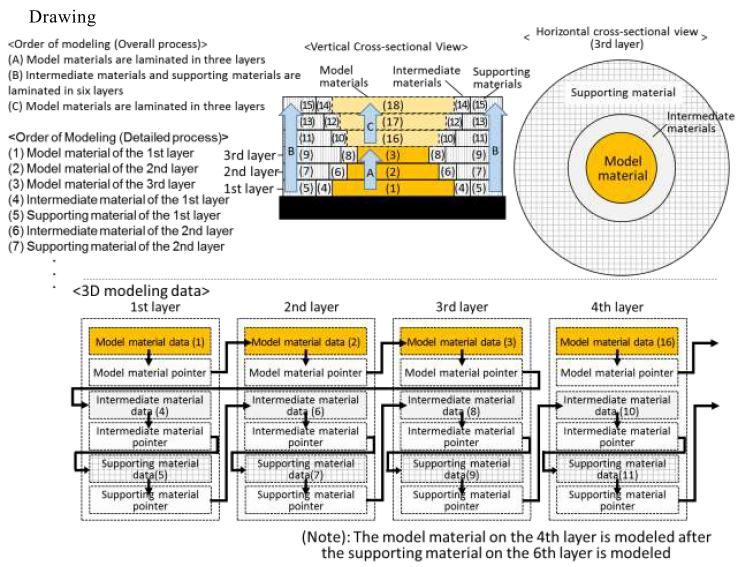
Overview of the description
[Background Art]
A 3D printer models a 3D-modeled object by calculating data indicating a thinly-cut cross-sectional shape in the laminated direction and a position of dispensation corresponding to the cross-sectional shape based on data on three-dimensional shape of the 3D-modeled object, modeling each layer using model materials in accordance with the data and laminating each of the layers.
A 3D printer that laminates model materials that finally constitute a 3D-modeled object and supporting materials that support the said model materials is known. In case where an object to be modeled has a protruding part in relation to a lower-layer structure, the supporting materials are placed on the outer or inner circumference of the model materials to support the said protruding part of the model material until the modeling of 3D-modeled object completes and then removed once the modeling of 3D-modeled object completes.
Such a 3D printer is comprised of a dispensing unit that dispenses model materials and a dispensing unit that dispenses supporting materials separately and changes materials to be dispensed at every several layers with the aim of shortening the time of modeling by reducing the number of changes compared to the case where materials to be dispensed are changed at each layer. To be more specific, after the step of performing a modeling by dispensing model materials (or supporting materials), in case where model materials (or supporting materials) of next-higher layers in relation to the model materials (or supporting materials) have protruding parts and no supporting materials (or modeling materials) of the same layer have been modeled at the time when the step completed, a step of modeling lowermost layers by dispensing the supporting materials (or model materials) that have not been modeled at the time when the process completed is performed, and, in case where they do not have any protruding parts or supporting materials (or model materials) of the same layer have been modeled at the time when the process completed, 3D printing is performed by dispensing the model materials (or supporting materials) of the next-higher layers. By this way, model materials and supporting materials are laminated properly so that the number of changes of materials to be dispensed is reduced to the maximum extent possible.
[Problems to be solved by the invention]
Since supporting materials support model materials during modeling and are removed once the modeling of a 3D-modeld object completes, they will be turned into waste after their use. It is preferable, therefore, to reduce the usage of supporting materials.
The present invention has been conceived in view of these circumstances and aims to provide 3D printing data capable of properly laminating model materials and supporting materials and reducing the number of changes of materials to be dispensed to the extent possible as well as reducing the usage of supporting materials that will be turned into waste and easily removing supporting materials.
[Solution for the Problem to be solved]
The present invention is characterized in that it laminates, in addition to model materials, supporting materials that have the lattice shape in planar view and support the model materials during modeling and intermediate materials that are made of the same material as the supporting materials and are located between the model materials and supporting materials during modeling and specifies the order of modeling steps.
The present invention is, for example, embodied in an ink-jet 3D printer. A 3D printer is equipped with a control unit that sequentially acquires model material data, supporting material data or intermediate material data used for modeling among the 3D printing data from a memory unit in accordance with a pointer and that makes a dispensing unit to dispense materials. The 3D printer itself may be equipped with the memory unit or an external server connected to the 3D printer via a network may be equipped therewith
Since supporting materials of the present invention have the lattice shape in planar view, the quantity of such materials to be used is less than the case where they are applied evenly in one layer. Thus, the usage of supporting materials that are turned into waste is reduced. When supporting materials and intermediate materials are removed by dissolving them in solvents, it is easier for solvents to spread in the supporting materials and intermediate materials due to the lattice shape thereof. Moreover, since the quantity of supporting materials and intermediate materials to be dissolved is kept low, they can be dissolved and removed in a short period of time. Furthermore, a scanning movement of the dispensing unit at the time of modeling becomes linear due to the lattice shape of supporting materials allowing a modeling to be performed at high speed.
On the other hand, intermediate materials of the present invention are made of the same material as supporting materials and are located between model materials and the supporting materials. The intermediate materials have an interface in contact with the supporting materials and the interfaces finally become a surface of a 3D-modeled object after removing intermediate materials and supporting materials. Therefore, it is required to perform a modeling at good precision, but high precision is not required for the contacting surface between the supporting materials and the intermediate materials.
Even if supporting materials have the lattice shape in planar view, it does not affect precision of the final 3D-modeled object. Moreover, since supporting materials and intermediate materials are made of the same material, after the step of performing a modeling by dispensing intermediate materials, a step of performing a modeling by dispensing supporting materials may be carried out of a layer in which the step for the intermediate materials was carried out as described later.
The 3D printing method of the present invention carries out a step of, (A) after the step of performing a modeling by dispensing the model materials, (A1) performing a modeling by dispensing the intermediate materials of the lowermost layer that have not been modeled at the time when the said step completed, in case where the model material of a next-higher layer has a protruding part in relation to the model material dispensed at the said step and where the intermediate material of the same layer has not been modeled at the time when the said step completed and (A2) performing a modeling by dispensing the model materials of the next-higher layer in case where it does not have a protruding part or where the intermediate material of the same layer has been modeled at the time when the said step completed, (B) after the step of performing a modeling by dispensing the said intermediate materials, performing a modeling by dispensing the supporting materials of the layer in which the said step was carried out; and (C) after the step of performing a modeling by dispensing the said supporting materials, (C1) performing a modeling by dispensing the model materials of the lowermost layer that have not been modeled at the time when the said step completed, in case where the supporting material and the intermediate material of a next-higher layer have protruding parts in relation to the supporting material and the intermediate material of the layer in which the step was carried out and where the model material of the same layer has not been modeled at the time when the said step completed and, (C2) performing a modeling by dispensing the intermediate materials of the next-higher layer in case where they do not have protruding parts or where the model material of the same layer in which the step was carried out has been modeled at the time when the said step completed. It should be noted that, even in case where the model materials or the supporting materials do not have any protruding part in relation to a lower layer, dispensed materials may be changed after laminating the predetermined number of layers, since a dispensing unit may collide with modeled layers when the dispensing unit comes close to the 3D-modeled object and modeling stage to dispense materials. Moreover, in case where supporting materials (or model materials) of all layers have not been modeled after the step of performing a modeling by dispensing model materials (or supporting materials) of the uppermost layer, the step of performing a modeling of supporting materials (or model materials) of the lowermost layer that has not been modeled at the time when the process completed is carried out.
The 3D printing data of the present invention is to realize the above 3D printing method and includes on each layer, together with model material data, intermediate material data and supporting material data, a pointer that points to data used for a modeling following a modeling based on such data. The model material data, intermediate model data and supporting material data here shall refer to data indicating materials (model materials, intermediate materials or supporting materials) to be dispensed from the dispensing unit of the 3D printer and the position and quantity of dispensation, respectively.
The pointer is now explained. (A’) The model material pointer is set, (A’1) to point to the intermediate material data of the lowermost layer that is not modeled at the time when modeling of the model material of the layer in which the modeling material pointer is included completed, in case where the model material of a next-higher layer has a protruding part in relation to the model material of the layer in which the model material pointer is included and where the intermediate material of the same layer has not been modeled at the time when the modeling of the model material of the layer in which the model material pointer is included completed and, (A’2) to point to the model material data of the next-higher layer, in case where it does not have any protruded part or an intermediate material of the same layer has been modeled at the time when the modeling completed. (B’) The intermediate material pointer is set to point to supporting material data of the layer in which the pointer is included. (C’) The supporting material pointer is set, (C’1) to point to the model material data of the lowermost layer that is not modeled at the time when modeling of the supporting material of the layer in which the supporting material pointer is included completed, in case where the supporting material and the intermediate material of a next-higher layer have protruding parts in relation to the supporting material and the intermediate material of the layer in which the supporting material pointer is included and where the model material of the same layer has not been modeled at the time when the modeling of the supporting material of the layer in which the supporting material pointer is included completed and, (C’2) to point to the intermediate material data of the next-higher layer, in case where they do not have any protruding parts or the model material of the same layer has been modeled at the time when the modeling completed. It should be noted that, even in cases where a model material or supporting material does not have any protruding part in relation to a next-lower layer, if dispensed materials are changed after laminating the predetermined number of layers, the pointer shall be set to realize such a change. Moreover, with regard to a model material pointer (or supporting material pointer), in case where supporting materials (or model materials) of all layers have not been modeled, it is set to point to the supporting material data (or model material data) of the lowermost layer that has not been molded at this moment, while, in cases where supporting materials (or model materials) of all layers have been modeled, it is set to point to the completion of modeling of all layers.
The case where an hour-glass shaped 3D-modeled object having six layers is explained using a pointer set in the above manner (It should be noted that it is rare that the lamination completes in six layers in actual 3D printing and hundreds or thousands of layers are usually laminated. The example gives an explanation supposing that the 3D-modeled object is composed of six layers in order to explain the idea of the present invention). When such a 3D-modeled object is modeled, it is required to place supporting materials and intermediate materials on the outer circumference of model materials. However, as model materials on the fourth to the sixth layers have protruding parts from their respective model materials on next-lower layers and supporting materials and intermediate materials on the first to the third layers have protruding parts from their respective next-lower layers, it is appropriate to laminate three layers of model materials, six layers of supporting materials and intermediate materials and then the remaining three layers of model materials. If there are a supporting material and an intermediate material in the same layer, the intermediate material is modeled first.
In this case, as for pointers in the 3D printing data, model material data of the second layer is pointed after the modeling based on model material data of the first layer, model material data of the third layer is pointed after the modeling based on model material data of the second layer, model material data of the first layer is pointed after the modeling based on model material data of the third layer, and supporting material data the first layer is pointed after the modeling based on the intermediate material data of the first layer (the same process is repeated for subsequent layers).
Since a pointer may change data to be pointed by simple data editing, 3D printing data having such a structure with pointers may simply set the order of modeling, that is, the order of acquiring the data, after calculating data indicating a thinly-cut cross-sectional shape in the laminated direction and the quantity and position of dispensation of each material corresponding to the cross-sectional shape based on data of three-dimensional shape of the 3D-modeled object.
Since a control unit of a 3D printer sequentially acquires from a memory unit model material data, intermediate material data or supporting material data used for modeling among 3D printing data, such 3D printing data having a structure with pointers is preferable in cases where the size thereof is larger than the RAM capacity of the control unit of the 3D printer or the memory unit (and the conversion unit that converts data on 3D shapes of the 3D-modeled object into 3D printing data taking into account a cross-sectional shape of the 3D-modeled object and stores it in the said memory unit) is accommodated in an external server connected to the 3D printer over the network.
[Effect of Invention]
The present invention is capable of properly laminating model materials and supporting materials and reducing the time of changes of materials to be dispensed to the extent possible as well as reducing the quantity of supporting materials used that are turned into wastes and removing supporting materials easily.
[State of the art (Prior art, well-known art, etc.)]
Cited invention 1 (Invention disclosed in the cited document 1 (D1)):
A 3D printing method that laminates model materials that finally constitute a 3D-modeled object and supporting materials that support the said model materials during modeling,
wherein the 3D printing method comprising, in each of layers of the said 3D-modeled object:
a step of performing a modeling by dispensing the said model materials; and
a step of performing a modeling by dispensing the said supporting materials, and
wherein the 3D printing method carries out a step of,
(a) after the step of performing a modeling by dispensing the model materials, (a1) performing a modeling by dispensing supporting materials of the lowermost layer that have not been modeled at the time when the said step completed, in case where the model material of a next-higher layer has a protruding part in relation to the model materials dispensed at the said step and where the supporting material of the same layer has not been modeled at the time when the said step completed and (a2) performing a modeling by dispensing model materials of the next-higher layer, in case where it does not have protruding parts or where supporting material of the same layer has not been modeled at the time when the said step completed and
(c) after the said step of performing a modeling by dispensing the supporting materials, (c1) performing a modeling by dispensing model materials of the lowermost layer that have not been modeled at the time when the step completed, in case where the supporting material of a next-higher layer has a protruding part in relation to the supporting materials dispensed at the said step and where the model material of the same layer has not been modeled at the time when the said step completed and, (c2) performing a modeling by dispensing the supporting materials of the next-higher layer in case where it does not have protruding parts or where the model material of the same layer has been modeled at the time when the said step completed.
Moreover, the cited document 1 describes the following 3D printing data corresponding to the above 3D printing method.
3D printing data used in a 3D printer which laminates model materials that finally constitute a 3D-modeled object and supporting materials that support the said model materials during modeling,
wherein the 3D printing data has a structure comprising in each layer of the said 3D-modeled object:
model material data indicating the quantity and position of dispensation of the said model materials;
a model material pointer that points to data used for the following modeling of modeling based on the said model material data;
supporting material data indicating the quantity and position of dispensation of the said supporting materials; and
a supporting material pointer that points to data used for the following modeling of modeling based on the said supporting material data;
wherein (a) the model material pointer is set (a1) to point to the supporting material data of the lowermost layer that is not modeled at the time when modeling of the model material of the layer in which the modeling material pointer is included completed, in case where the model material of a next-higher layer has a protruding part in relation to the model material of the layer in which the model material pointer is included and where the supporting material of the same layer has not been modeled at the time when the modeling of the model material in which the model material pointer is included completed and, (a2) to point to the model material data of the next-higher layer, in case where the model material of the next-higher layer does not have the protruding part or where the supporting material of the same layer has been modeled at the time when the modeling completed, and
wherein (c’) the supporting material pointer is set (c’1) to point to the model material data of the lowermost layer that is not modeled at the time when modeling of the supporting material of the layer in which the supporting material pointer is included completed, in case where the supporting material of a next-higher layer has a protruding part in relation to the model material of the layer in which the supporting material pointer is included and where the model material of the same layer has not been modeled at the time when the modeling of the supporting material in which the supporting material pointer is included completed and, (c’2) to point to the supporting material data of the next-higher layer, in case where the supporting material of the next-higher layer does not have the protruding part or where the model material of the same layer has been modeled at the time when the modeling completed; and
wherein the 3D printing data is used by a control unit of the said 3D printer for processing to acquire the model material data or the supporting material data from a memory unit of the said 3D printer in accordance with the said model material pointer or the supporting material pointer after the modeling based on the said model material data or the supporting material data.
(Problems to be solved)
To reduce the number of changes of materials to be dispensed to the extent possible while properly laminating model materials and supporting materials.
[Drawing in D1]
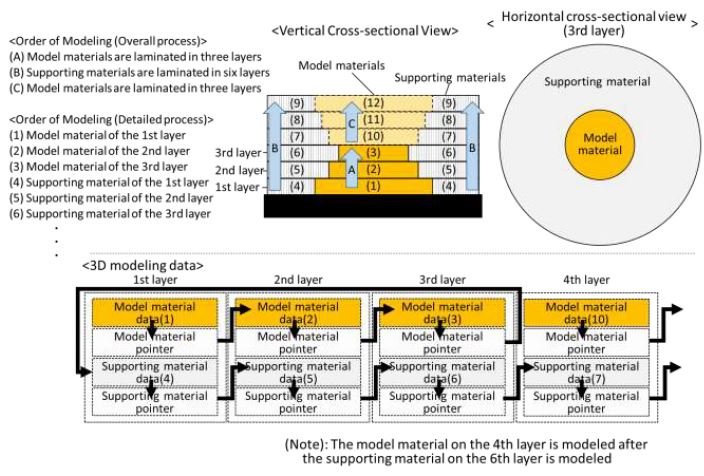
Cited invention 2 (Invention disclosed in the cited document 2 (D2)):
A 3D printing method to laminate model materials that finally constitute a 3D-modeled object, supporting materials that support the said modeling materials during modeling and intermediate materials that are different from the said supporting materials and made of materials whose releasability from the said model materials is high and that are located between the said model materials and the said supporting materials during modeling.
It should be noted that the cited document 2 does not describe the order of steps to perform modeling by dispensing the model materials, the supporting materials and the intermediate materials.
(Problems to be solved)
To easily and mechanically release and remove the supporting materials from the model materials without dissolving the supporting materials in solvents for removal
[Conclusion]
The invention of claim 1 involves an inventive step.
[Explanation]
(Considered motivation)
(1) Relation of technical fields
Both the cited invention 1 and the cited invention 2 relate to a 3D printing method to laminate model materials that finally constitute a 3D-modeled object and supporting materials that support the said model materials during modeling.
Therefore, they are common in technical fields to each other.
(2) Similarity of problems to be solved
Although the cited document 1 does not clearly describe a problem to be solved about the removal of supporting materials, making the removal of the supporting materials easier is an obvious problem for persons skilled in the art, because they are removed after the modeling of the 3D-modeled object completes.
Therefore, the cited document 1 and the cited document 2 are common in problems to be solved to each other.
(Explanation on the non-existence of an inventive step objection)
- Claim 1
When the invention of Claim 1 and the cited invention 1 are compared, they are different in the following points.
(Difference 1)
The invention of Claim 1 laminates materials including intermediate materials that are made of the same material as supporting materials and are located between model materials and supporting materials during modeling, and, relating to a step of performing modeling by dispensing the intermediate materials, carries out a step of, (A) after the step of performing a modeling by dispensing the model materials, (A1) performing a modeling by dispensing the intermediate materials of the lowermost layer that have not been modeled at the time when the said step completed, in case where the model material of a next-higher layer has a protruding part in relation to the model material dispensed at the said step and where the intermediate material of the same layer has not been modeled at the time when the said step completed, (B) after the step of performing a modeling by dispensing the said intermediate materials, performing a modeling by dispensing the supporting materials of the layer in which the said step was carried out; and (C) after the step of performing a modeling by dispensing the said supporting materials, (C2) performing a modeling by dispensing the intermediate materials of the next-higher layer in case where they do not have protruding parts or where the model material of the same layer in which the step was carried out has been modeled at the time when the said step completed. On the other hand, the cited invention 1 does not laminate materials including intermediate materials nor specify the steps of performing a modeling by dispensing the intermediate materials.
(Difference 2)
In the invention of Claim 1, the supporting materials have the lattice shape in planar view, while the cited invention 1 does not specify it.
The above difference 1 is considered.
Both the cited invention 1 and the cited invention 2 are common in technical fields to each other, because they relate to a 3D printing method to laminate model materials that finally constitute a 3D-modeled object and supporting materials that support the said model materials during modeling. Moreover, the cited document 1 does not clearly describe a problem about the removal of supporting materials, but making the removal of the supporting materials easier is an obvious problem for persons skilled in the art. Therefore, the cited document 1 and the cited document 2 are common in problem to be solved.
However, the cited invention 2 laminates materials including intermediate materials that are located between the model materials and the supporting materials, but the intermediate materials are not made of the same material as the supporting materials but of different types of materials. Moreover, the cited invention 2 does not specify the order of steps of performing a modeling by dispensing model materials support materials and intermediate materials.
Furthermore, the cited invention 2 makes it easier to mechanically release and remove the supporting materials from the model materials by using the intermediate materials that are different from the supporting material and whose releasability from the said model materials is high. Therefore, not only making it easier to remove supporting materials and intermediate materials by means of solvents by adopting the same material for those materials and but also reducing the number of changes of materials to be dispensed by setting a specific order of carrying out the step of performing a modeling by dispensing the intermediate materials, for example, by carrying out a step of performing a modeling by dispensing the supporting materials made of the same materials after the said step for the intermediate materials are not matters persons who had contact with the cited invention 1 and the cited invention 2 could have drawn from the common general technical knowledge.
The matter relating to the above difference 1 could not have been conceived only by applying the cited invention 2 to the cited invention 1 considering their technical fields and common problems and it cannot be deemed as a design variation (a design variation or adoption of a matter of design variation along with the specific application of an art to solve certain problem) that could have been made at the time of applying the cited invention 2 to the cited invention 1.
The above difference 2 is considered.
Although the cited invention 2 laminates materials including supporting materials, it does not specify that the supporting materials have the lattice shape in planar view.
Moreover, the cited invention 2 is to make it easier to mechanically release and remove supporting materials from model materials. Therefore, making it easier to remove supporting materials and intermediate materials by means of solvents by adopting the lattice shape in planar view for supporting materials is not a matter that persons skilled in the art who had contact with the cited invention 1 or the cited invention 2 could have drawn from the common general technical knowledge.
Thus, the matter relating to the above difference 2 could not have been conceived only by applying the cited invention 2 to the cited invention 1 and it cannot be deemed as a design variation (a design variation or adoption of a matter of design variation along with the specific application of an art to solve certain problem) that could have been made at the time of applying the cited invention 2 to the cited invention 1.
Moreover, based on the matters relating to the above differences 1 and 2, the invention of Claim 1 has an advantageous effect that cannot be predicted from the cited invention 1 or cited invention 2. That is, since the supporting materials have the lattice shape in planar view, solvents for dissolution and removal thereof can be spread easily. Moreover, as the intermediate materials are made of the same material as the supporting materials, they can be dissolved and removed at one time in a short period of time. After a step of performing modeling by dispensing the intermediate materials, a step of performing a modeling is carried out by dispensing the supporting materials made of the same material, it is not necessary to change materials to be dispensed. Moreover, even if the supporting materials has the lattice shape in planar view, they do not affect the precision of the final 3D-modeled object.
When considering these circumstances comprehensively, persons skilled in the art could not have easily conceived of the invention of Claim 1.
- Claim 2
The 3D printing data in the invention of Claim 2 realizes the 3D printing method in the invention of Claim 1.
Therefore, for the same reason as the invention of Claim 1, persons skilled in the art could not have easily conceived of the invention of Claim 2.

